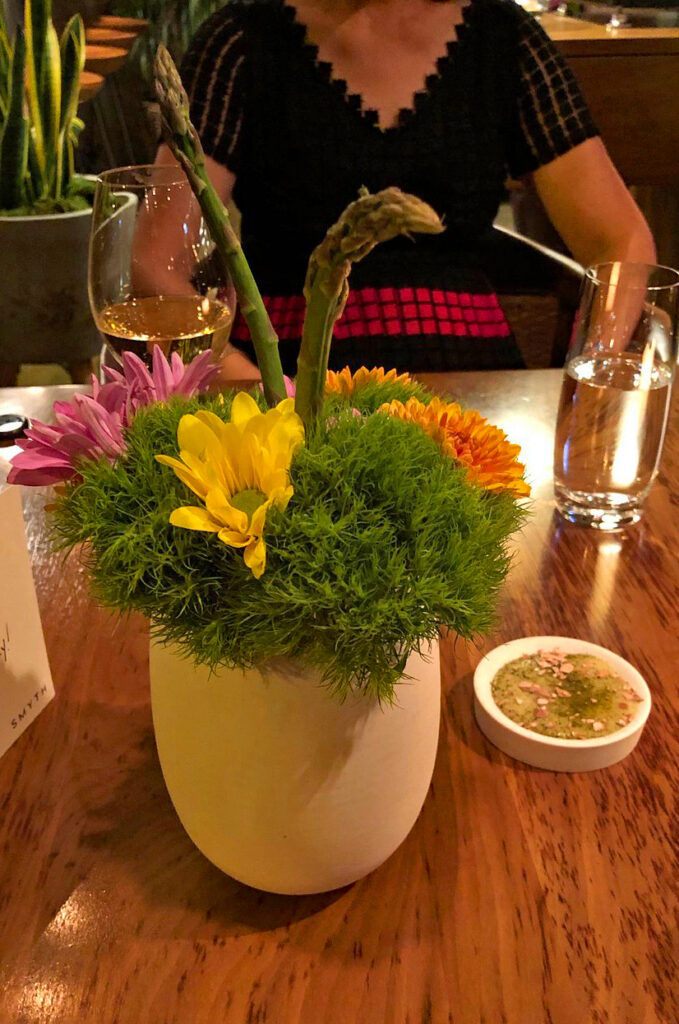Smyth is Chicago’s greatest restaurant—perhaps ever—and you have remained resolute in that declaration since first dining there in September of 2017.
Just over three years following that fateful first visit, sitting out on Smyth’s patio, you found yourself face-to-face with a far different world. Yet the restaurant, ragged from the pandemic’s toll and reeling from the looming rollback of restrictions, never seemed more beautiful.
That evening, the final dinner of Smyth’s “Farm Series” concept (a sequence of three meals scheduled throughout the year so as to celebrate the peaks of the season’s produce) had been disfigured due to the ravages of the virus. What should have been a trio of menus set in May, July, and September was altered to encompass July, September, and November instead. As luck would have it, unseasonably warm weather (and a rather effective heater placed under the table) allowed for the last of the meals to still take place.
That evening—perched between two concrete planters on the sidewalk along Ada Street, seated in the shadow of the residential building which replaced the parking lot that once sat across from the building—you were served one of the finest meals of your life. Despite shedding scores of talented staff, of twisting and turning to meet the challenges of the black swan consuming the hospitality industry, Smyth put out a menu that was stupefying in its creativity (you had just eaten there one month before) and faultless in its finesse.
On that brisk evening, you celebrated your fiftieth meal at Smyth. Fifty visits is an incomparable, inconceivable number for any “fine dining” or “special occasion” restaurant. You do not, for the sake of both anonymity and propriety, typically like to reveal (or revel in) such benchmarks. But, in some sense, the number stands as a shorthand, a testament to how unerring Smyth’s hospitality and exploration of Illinoisan terroir have been during the course of time it has been open. Smyth, as best as you can put it, is the “real deal.” It forms a fitting model for the “American restaurant” of the future. And, more than that, it is filled to the brim with heart and soul.
Dining at Smyth, on any and every given night, has presented you with the rarest, most transcendent of all hospitality experiences. It is a place that makes the phrase “restaurant family” ring hollow when applied to any other establishment. Smyth’s dining room is one where the guest cannot help but engross themselves in the rhythm of service, of forming—through true encounters with kindred spirits—yet another strand in the tapestry of the restaurant’s living history. You will not obscure the fact that Smyth inspires you—that it may have, more than nearly any other restaurant, inspired the very substance of this website. But trust, dear reader, you are not being dramatic when you declare that fiftieth meal at Smyth to be one of the greatest of your life. For diamonds are made under pressure, and the restaurant—pandemic or not—shows no signs of slowing down.
John Shields is something like the “beloved uncle” of Chicago hospitality—the sort of uncle whose absolute mastery of his craft never gets in the way of his earnest, easygoing manner. Starting his career in St. Louis, Shields cut his teeth through coveted positions at two of the Windy City’s most legendary restaurants. He served as sous chef at Charlie Trotter’s for two years before spending another two years as the opening sous chef of Alinea, a set of experiences at the nexus of culinary history that anyone would be hard-pressed to surpass. Meanwhile, Karen Urie (later to become Karen Urie Shields) was enjoying her own climb to the pinnacle of the pastry world. Moving to Chicago from Rhode Island, she worked for two years as sous pastry chef under James Beard Award winner Gale Gand at TRU before spending six years at Charlie Trotter’s, rising to the role of head pastry chef.
The couple’s command of both sweet and savory drew the renewed attention of Charlie Trotter himself, who tapped the Shieldses to open a Las Vegas location of his namesake restaurant. Though running a luxe offshoot of the renowned establishment where the two had worked seemed like “the obvious next step,” John and Karen—in a move as wise as it was risky—chose to forge their own path. They relocated to Chilhowie—a town of 1,827 at the crossroads of Virginia, North Carolina, Tennessee, West Virginia, and Kentucky—in response to an ad placed on Chicago’s Craigslist site:
The owners of Chilhowie’s Town House Grill were looking to transform their steak and seafood joint into a proper destination restaurant, and—after ensuring the couple was prepared to work in the “middle of nowhere”—they gave the Shieldses complete creative control to make it so.

Rather than do their best rendition of Charlie Trotter’s cuisine under the shining lights of Sin City, John and Karen—having both just turned 30—devoted their halcyon days to self-expression. They channeled their estimable technical knowledge towards developing their own voice on their own terms, approaching Appalachia’s natural bounty with unseen skill. Early dishes—like foie gras cotton candy or liquid nitrogen-frozen marshmallow “moss”—seem straight out of Alinea’s playbook. Others—such as a chilled “minestrone” made from nine different vegetables or marinated oysters served simply with peas and dashi—speak to Charlie Trotter’s worship of local ingredients. However, neither of the Shieldses stylistic influences are determinative. Then, as they do now, the two knew just what elements to take inspiration from and those which are best to discard. Thus, Alinea’s technical wizardry is showcased in a playful (rather than polarizing and needlessly abstract) style while Charlie Trotter’s precise preparations of produce, fish, and flesh are freed from any pretentiousness.
The end result, of course, was a style unto their own (one which, you think, has always proven to be a kindred spirit with the “New Nordic” movement). Opening in 2008, the twenty-six seat restaurant (later growing to thirty-five) served a four-course tasting menu for $48 and a nine-course menu for $90, eye-popping prices today. By 2009 (when its chefs earned a glowing feature in the New York Times), Town House had succeeded in seducing gastronomes from around the Mid-Atlantic to take the trek to Chilhowie. 2010 brought John the honor of being named one of Food & Wine’s “Best New Chefs” in the country. Then, in 2011, he was named a semi-finalist for the James Beard Foundation’s Best Chef: Mid-Atlantic award. Without question, the Shieldses decision to take their destiny into their own hands had paid off.
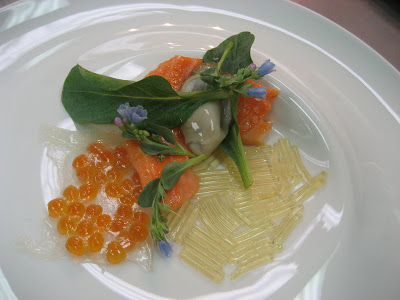
By the time Town House closed in 2012, John and Karen had developed a firm culinary philosophy of their own that would later find a home at Smyth. Looking back at their “Town House Blog” (now defunct, but available through internet archiving), one notes the genesis of a style that applies Alinea’s advanced techniques towards refining flavors and constructing novel assemblages of ingredients while, at the same time, making sure never to deny the classic, comforting essence of a dish’s central component. In this sense, Charlie Trotter’s philosophy comes into focus. However, instead of filtering native ingredients through the lens of fine French cookery, the Shieldses embrace the local bounty as Americans through and through who feel no need to embellish nature’s own designs for the sake of pleasing cosmopolitan palates. Like John and Karen themselves, nothing about the plates is put on. They are tranquil, at peace, yet infinitely complex under the surface. Any ostentation—when it does appear—is altogether playful. Such dishes greet the guest with a wink and a nod—with generous, nostalgic flavors—and no sense of cold, craven “luxury.”
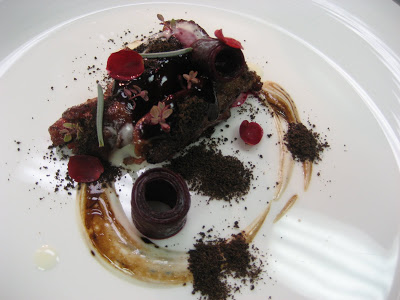
Dishes from that era include ocean trout (dressed in a broth of mussel juice, oyster juice, pork stock, butter whey, and dill oil), a lardo-lined “empanada” (filled with crispy pork tail, fried corn, and goat cheese cream), lamb cooked in smoked butter (served with beets and caramelized yogurt), lobster (with coral cream, lobster consommé, and lobster oil), beef cheek cooked in hay (garnished with corn sprout, milk skin, oats, and toasted grains), and barbequed asparagus (plated with candied lovage, cured egg yolk, Meyer lemon, and shad roe). You wish you could write out all the ingredients listed for each of those dishes but, for the sake of space, had to settle for the most interesting few. Immediately, one notes how Shields—even back then—marked his cuisine through a layering of complementary flavors. The “lobster” dish tastes even more like lobster through the incorporation of consommé and oil into the sauce. The “ocean trout” dish benefits from the juice of two shellfish—and even from pork stock and butter whey, which lend the fish a richness it might never otherwise have. Thus, any interesting “twists” (like the coral cream or dill oil) stand on a foundation of the principle ingredient’s signature flavor. They provide just enough novelty to tantalize the palate and play off of the intensity of flavor constructed via layering.
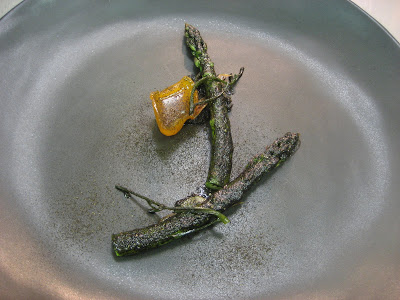
Tellingly, a dish like the “barbequed asparagus” receives the same treatment. It is not only given center stage in the same manner a piece of animal protein or seafood would, but it is dressed up in the same fashion: cured egg yolk and shad (herring) roe amplify the vegetable’s richness while the candied lovage and cured Meyer lemon elements take the asparagus in a sweet and sour direction that works to offset its impressive char. That being said, the lamb and beef cheek preparations are no slackers either. The latter, in particular, looks like it makes masterful use of an assortment textured grains and sprouts to accentuate the tenderness of the so-called butcher’s cut. At the same time, milk skin—an ingredient you have only ever seen at Smyth—adds an ethereal sort of dairy richness to the beef. This is superlative savory cooking accomplished with no tricks, merely an aim of putting diverse ingredients, in distinct forms, to work with a focus on conjuring pleasure from the dish’s central component.
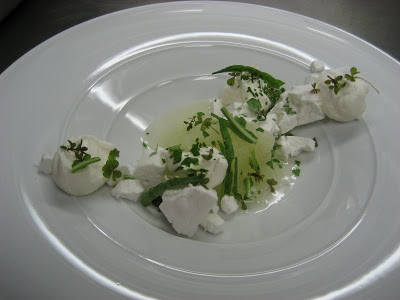
Looking at the sweeter side of things, Karen’s creations at Town House included a cocoa and black sesame “chewy meringue” (with wasabi and lime), a “broken” vanilla marshmallow (with preserved green strawberries, frozen lemon, and cucumber), a “liquid” chocolate bar (with an ice cream of burnt embers, sour yogurt, and muscovado), crabapple (with caramelized pudding, caraway seed tempura, and oats), and “fallen leaves” (made of painted white chocolate and served alongside Hubbard squash, Indian curry, chocolate “textures,” and granola).
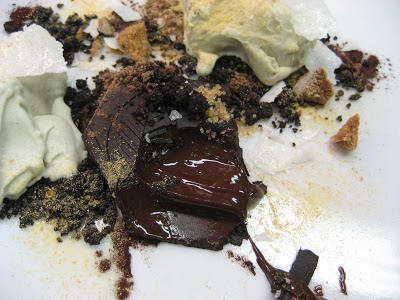
From the start, one notes how each of these dishes revolve around showcasing an interesting textural expression of a familiar form: the meringue is “chewy,” the marshmallow is “broken,” the chocolate bar is “liquified,” the pudding is “caramelized,” and the chocolate in the latter dish is reduced to “textures” altogether. Accompanying ingredients—like the duo of wasabi and lime or the trio of burnt embers, sour yogurt, and muscovado—accentuate the dish from a variety of angles: heat and sour in the former; smoke, sour, and deep brown sugar flavors in the latter. And yet, the principle flavor could not be more familiar: cocoa/black sesame, vanilla, chocolate, apple, squash. Yes, the presentations—as in the case of the “fallen leaves”—may be arresting, but the essence of each dish is altogether pleasing. These are fundamentally comforting, nostalgic desserts that are deconstructed and put back together in such a way as to amplify flavor like never before. They assert that textural and visual abstraction need not come at the cost of satisfaction. Alinea, you think, should take notes.
When the Shieldses left Town House in 2012, the chefs made for Philadelphia. There, the couple would be among relatives who could care for their 9-month-old daughter as they ironed out plans for a restaurant of their own. First, rumors swirled that the in-demand duo was set for Washington D.C.. Then, later in the year, it seemed that they had decided on Philly—and were set to open a concept there similar to Town House in 2013. However, having “gotten virtually no interest from financial bakers” there, the Shieldses set sights back towards the nation’s capital. In February of 2013, the decision to open their new restaurant in D.C. was “100%,” and things were “all coming together.” Yet, little more than a year later, the Shieldses’ plans for a Georgetown restaurant had fallen through.
John and Karen, on the heels of this disheartening merry-go-round, headed back to where they had made their name. They installed themselves in a renovated farmhouse called Riverstead, which once served as an inn for guests who had made the long trek to Chilhowie for a meal at Town House. Rather than the thirty-five seats that comprised Town House, Riverstead only sat sixteen. The menu—twelve courses priced at $200—was only served one weekend per month. John and Karen would commute seven hours from Philadelphia for each limited engagement—until the couple welcomed their second daughter. Then, John would take to Twitter to shore up his team of two (Ryan Santos and Neal Wavra) with a few additional hired guns. The cooks would prepare most of the meal in the former Town House space before applying the finishing touches at Riverstead.

The menus at Riverstead—despite a few quixotic years out of action—express a further refinement of the Shieldses culinary style. One sees, you think, an even firmer connection to the work they would ultimately do at Smyth. Dishes from one exemplative menu dated August 2014 includes a Cope’s corn “sandy” (with pickled roses) and a sunchoke “cannoli” to start the meal. These are followed by dishes of beef tongue (with fresh cheese), tomato “seawater” (with trout roe), and mackerel (with Malabar spinach). The first bread course—a vegetable sourdough—precedes dishes of lightly smoked lobster (with grilled onion and pickled blueberry) and Dungeness crab (with roasted squid stock). The second bread course—a sprouted wheat biscuit (with boudin noir)—precedes a dish of lamb shoulder (with caramelized yogurt) and an intermezzo of duck heart, egg yolk, and licorice. A palate cleanser titled “embers of wintergreen branch & mint” leads to desserts of preserved carrot, sweet and dried corn (with elderflower and olive oil), and a kouign-amann to finish.
The ingredients listed for these dishes—retrieved off of a sample tasting menu rather than the more exhaustive Town House blog—are fewer. However, you think it is safe to assume that many of the same principles reside under the surface. The “lightly smoked lobster” likely benefitted by way of adjacent elements such as the aforementioned “lobster consommé” and “lobster oil.” As before, these components intensify the dish’s principal flavor while allowing for a more powerful contrast to emerge from accompanying notes like the “grilled onion” or “pickled blueberry.” Sure enough, the Dungeness crab sees itself paired with a “roasted squid stock,” which, you think, extends and expands the essence of seafood in the dish beyond the domain of the crustacean alone. Of course, an ingredient like “tomato seawater” embraces this idea even more: blurring the lines between the essence of the sea and that of the field. Paired with trout roe, such a creation takes the static idea of a “caviar course” into an entirely new domain, grounding it in a sense of place that transcends the coast.
While lamb shoulder paired with caramelized yogurt surely seems familiar (why mess with perfection), the duck heart dish is altogether new. The combination with egg yolk and licorice—while not quite clear (perhaps it functions as a transition into dessert)—foreshadows one of Smyth’s most classic desserts. Curing the egg yolk in a licorice syrup imbues it with chewy, then runny texture that blankets its bedfellows with a rich, wonderfully sweet “sauce.” By presenting the “yolk” in a familiar fashion (to be burst by the customer), the dish actually works to celebrate the way in which a mere egg may surpass its status as raw ingredient and become a major player in the character of a savory-sweet composition.
The preserved carrot, too, represents a new chapter in the Shieldses worship of “humble” produce. Listed without any accompanying flavors—and paired with a local Virginian late-harvest wine—the carrot (which has also appeared in a similar form at Smyth) testifies to a latent flavor that need only be unleashed. Often resigned to the role of mirepoix, the carrot—when nurtured—reveals a depth of sweetness, a candied character that can act as a pleasing dessert in its own right. The idea of preserving and serving something so simple—yet unleashing, in it, and unexpected power—strikes right at the core of how the chefs marry their technical know-how with the generous, loving eyes of forager and farmer.
When it comes to Karen’s pastry work, Riverstead’s menu reflects a greater creative presence throughout the course of the meal. The “corn sandy” and “sunchoke cannoli” showcase a bit of her talent at the very start of the meal, channeling cookie forms as a means of featuring natural ingredients. The vegetable sourdough and sprouted wheat biscuit, too, make for a dual sequence of traditional bread services with a slight twist in the composition of each dough. (The boudin noir paired with the latter, you think, lends the flaky biscuit an even greater opportunity to shine). Finally, rounding the corner into dessert, “embers of wintergreen branch & mint” allows for some of Karen’s whimsy to come to the fore, with the dish’s title alone striking more closely to a visual (rather than gustatory) scene. The kouign-amann, of course, returns guests to the playful start of the meal: the classic pastry is unquestionably nostalgic, highly comforting, and made the restaurant’s own via a garnish of foraged microgreens.
By April of 2015, the monthly dinners at Riverstead had come to an end. After more than half a decade plying their trade out east—and several years of jostling to make a place of their own in D.C.—the Shieldses, now with two daughters in tow, returned to Chicago. “We just kind of gave Chicago a chance, and, lo and behold, within one day of trying, we found a space,” John admitted to The Washington Post. “We gave it [opening in the Capital] a valiant effort,” he made clear, but reporter Becky Krystal said it best: “Sorry, Washington. Our loss is Chicago’s gain.”
According to Phil Vettel, the Tribune’s former dining critic, John and Karen had gotten a hot tip from fellow Charlie Trotter’s alumnus Bill Kim—whose BellyQ and Urbanbelly restaurants formed a longstanding presence at the western end of Randolph Restaurant Row. Kim pointed the couple towards a potential opening around the corner from him on Ada Street, a sprawling 5,600-square-foot space that belonged to chef Ryan Hutmacher. Hutmacher had been running the Centered Chef—a wellness and culinary consulting business—out of there, with the bulk of the area devoted to hosting catered private events. But now he wanted out, and, in the space (which comprised two separate floors), the Shieldses saw opportunity.
From the start, the couple viewed the “upstairs restaurant” as a continuation of their work at Town House and Riverstead in Chilhowie. The chefs imagined serving both an eight-course menu and a fourteen-course extended tasting in the space, a dichotomy that would up the ante from the four-course / nine-course options served during their time in Virginia. (The sample menu from Riverstead you cited topped out at fifteen courses, but those monthly affairs must be judged differently from a regularly-operating restaurant).
Downstairs, in contrast, was described as “a casual place, food and cocktails, very lounge-y atmosphere, at a price point that you’re going to want to come back more often than not.” The Shieldses aimed to have some connection between the two dining rooms—“we’re still working that out a little bit”—but embraced the chance at distinguishing them: “it’ll be fun to have them separate, to have one feeling downstairs, a different feeling upstairs.” John and Karen’s hope was for the pair of restaurants to open late in the fall of 2015.
In January of 2016, they unveiled the concepts’ names—Smyth, for the upstairs space, and The Loyalist, for downstairs—and they pinpointed a late-spring launch for both. Now deeper into Smyth’s design phase, Karen shared how they “really want to step away from the cliched fine-dining restaurant service that, to a lot of average folks, is nerve-wracking.” Rather, the two hoped guests would feel as though they were dining in the chefs’ home, striking a “genuine” “happy medium” between formal precision and casual comfort. At forty seats, the space would number just five more than Town House, a sign that the intimacy and charm the team built their reputation on would be well-preserved.
“Smyth,” itself, refers to Smyth County, Virginia—home to Chilhowie and the larger terrain from which the Shieldses foraged and sought inspiration for their menus at Town House and Riverstead. Rather than capturing a sense of place, you think, the reference to Smyth County underlines the preservation of the culinary philosophy which the chefs had honed out east. The name, in that sense, forms a thread through which Chicago becomes another chapter of their growth as artisans, rather than a venue for the prodigal son and daughter to settle down and “play the hits.” Similarly, the cuisine does not intend to transport diners to Virginia so much as it embraces a similar rhythm of life in Illinois. To that point, Karen revealed they’d be working with a “20-acre Illinois farm for much of their produce” who would “be growing exactly what we want.”
Finally, some four years after Town House formally closed, the Shieldses opened The Loyalist in late July of 2016. Smyth followed one month later, the culmination of a dream that took the chefs from Chicago to Virginia and back again. While the two concepts are indeed connected, this piece will concern itself solely with Smyth. (The Loyalist, you think, ranks as one of Chicago’s best restaurants in its own right and deserves careful consideration in its own article). Herein, however, it is worth considering that John and Karen built their fine dining program on the foundation of a community eatery with the express goal of cultivating a flow of weekly “regulars.” Such a nesting of concepts not only makes business sense, but it speaks to something essential about the couple. The Loyalist is not Roister—that is to say, a ham-fisted attempt at comfort food from a group concerned only with monetization. Rather, the Shieldses simply love to cook for people, to care for them, and the space below Smyth ensures the widest segment of society can experience some taste of their generous, soulful cuisine.
In recounting your experiences at Smyth, you will—as is typical—condense the sum of your dinners into one cohesive narrative that looks to capture the restaurant in a comprehensive fashion. Given the establishment’s uncommon connection to seasonality (on a micro, rather than a macro “four season” scale), you think this format will prove particularly rewarding. Further, while Smyth has hosted exceptional collaborative meals with SingleThread, the Willows Inn, and Somni over the years (the best that Chicago, in your opinion, has ever seen), you will defer discussing these events in the interest of painting a picture of the restaurant in its normal operation. With that settled, let us begin!
Ada Street—now that its aforementioned parking lot has been replaced with “The Mason” (a fourteen-story apartment building)—stands as one of Randolph Restaurant Row’s more congested offshoots. On the best days, motor traffic can just about proceed in both directions while keeping decapitated mirrors to a minimum. Most of the time, however, the “sardine can” parallel parking stretching down each side squeezes passing cars uncomfortably close together. This all amounts to a rather neighborly scene where the street operates with the patience of a shared driveway—rather than a city road. Drivers inch their way out, forward, and around with eagle eyes and delicate ears, ever-alert to the dreaded sound of metal scraping metal. Pedestrians disembark and weave their away around vehicles—the luckiest among them heading to the building marked 177.
During the pandemic, Ada Street has never been more dysfunctional. Northbound traffic is a sea of hazard signals as brown bags are shuffled into trunks and passenger seats with gleeful, knowing looks. The prospect of bypassing the stopped cars and reaching Lake Street is improbable. At peak hours, it is all but impossible. Yet patient motorists refrain from their horns and heckles. Yes, a sense of goodwill reigns on this block of Ada Street. It may be a ways away from the bright lights of the dining district’s dense, eastern outcrop (home to the Goats, to Au Cheval, the Alinea Group, and all manner of other delights). But, whereas those restaurants speak to the present, this block of Ada Street embodies the future of American gastronomy.
It is no coincidence that Elske set up shop around the corner, that Curtis Duffy chose to stage his comeback only one further block north. For this block of Ada Street is home to Chicago’s greatest (ever) restaurant, and the sense of reverence shown for the work that goes on there is obvious even through all the congestion the journey entails. You see, nobody just stumbles upon Smyth (though you have no doubt the staff would find room for such a traveler, upstairs or down). Sure, it’s not Chilhowie, but visiting the restaurant—where the Shieldses have, at last, set up shop—is a proper pilgrimage. Because Smyth resists the flash of fine dining public relations 101. The chefs do not debase their cuisine so as to make it more camera-friendly. The restaurant need not jostle with the business across the street for a few breadcrumbs of patronage. It merely is.

That is to say, Smyth is at home on its block: a workaday street in an industrial section of a broad-shouldered city still defined (though decreasingly so) by the meat-packing plants that once turned readers’ stomachs. (To wit, Peoria Packing still draws lines in a building located somewhere between Smyth and Ever). Yet, unlike Ever, entering Smyth does not entail entering a different world. Rather, one steps into a more perfect world, a particular expression of a familiar place rooted indelibly in the native soil. Yes, Smyth is Chicago. It is also Illinois, the Great Lakes, the Midwest, and America, itself, at its most sublime. Concurrent with this macroscopic “sense of place,” Smyth also comprises every individual soul to have ever donned an apron in its kitchen or dining room. In that microscopic sense, the restaurant is a pantheon of hospitality where discrete figures—no matter how major or minor the role played in one’s meal—take on a salience and emotional resonance one but rarely experiences in so-called “service encounters.” Smyth stands not simply as a “restaurant family” (to use a dangerously trite expression), but a living tapestry in which staff past, present, and future are joined in a spirit of collective excellence and singular, actualized self-expression. It immediately strikes the diner as something worlds away from what a “corporate culture” could ever formulate.
You exit your Uber and dash across the street to the curb, marveling at those ivy-covered walls which mark 177 N. Ada Street. The sign says Smyth | The Loyalist, but the butterflies in your stomach foretell that you will be making a trip to the former. You enter the building’s vestibule and note the staircase, on the left, the descends to The Loyalist. A smaller staircase—rising just above ground level—brings you face-to-face with the building’s residential entrance (oh, what lucky souls occupy those units!). But to the right of that, behind a heavy wooden door, the din of Smyth’s dining room is unmistakable. No, not in the sense that the restaurant is noisy. Rather, it bustles with the sounds of the staff’s dynamism, as well as the clinking glasses and cackling laughs that denote the good time being had by all and sundry.
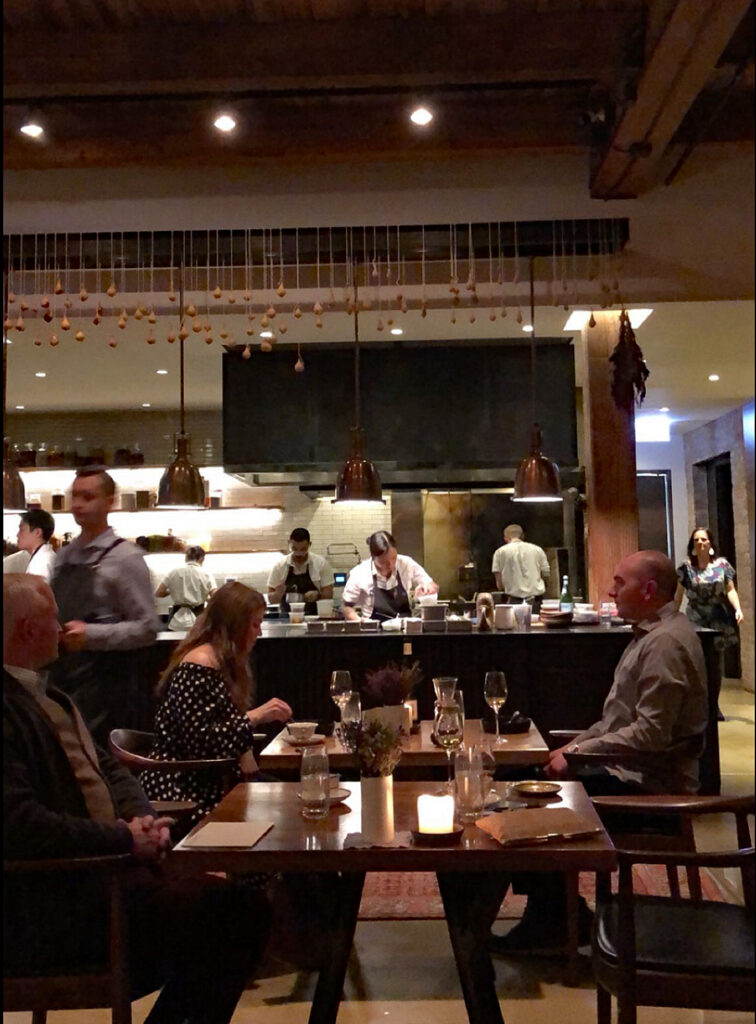
You enter the dining room and imbibe the palpable energy of proceedings: cooks engaged in careful toil; tables, booths, and banquettes filled with well-dressed and rosy-cheeked patrons; aproned and suited front of house staff scurrying about—and always ensuring each dish, each drink arrives two-at-a-time in perfect synchronization. There’s a plush little lounge situated immediately to your right. A butler’s pantry featuring glassware, that evening’s wine pairings, and other tools of the trade curls around the corner to your left and extends—with a small gap—into the pass. That counter, the crown jewel of one of the most truly “open” kitchens you have ever witnessed, frames the entirety of the space. Its intimacy and accessibility—to say nothing of the faultless organization and flow of the back-of-house team within its confines—are something special. One gets none of that foreboding feeling the “great” kitchens of the world can inspire. Instead, you are struck with the sense of being in someone’s home, a family home where onlookers’ peering and probing form a natural part of the process—and might even be rewarded by generous cooks. (You think Town House and Riverstead must have been similar: establishments where boundaries between the “cooking” and the “hospitality” dissolved completely in a manner one only commonly experiences in private residences).
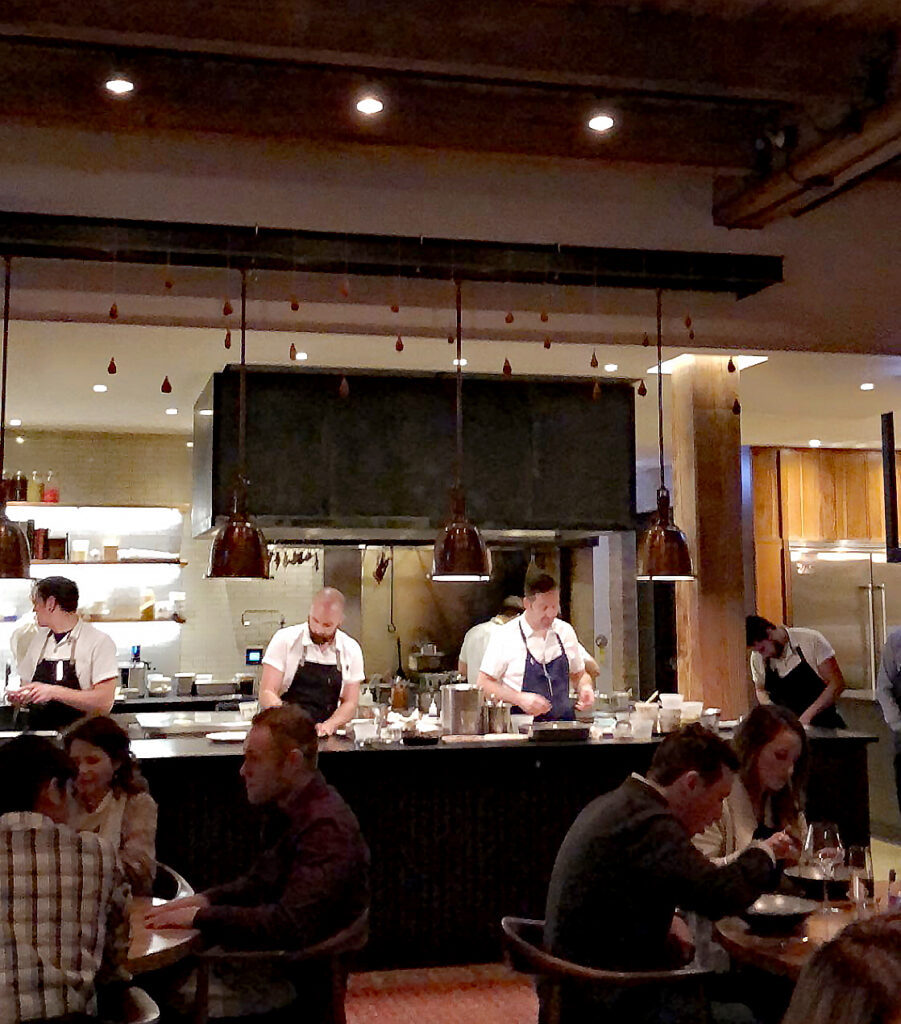
While there is nothing particularly “showy” about what goes on in Smyth’s kitchen—though, you must say, the crackling wood fire festooned with hanging squab carcasses is rather pleasing to watch—it is no surprise that every seat in the house is ensured some view of the action. Nothing screams for the guest’s attention, nothing demands they take note (or take pictures). Yes, there’s a richness to be gained from watching the cooks work, but you can just as easily simply taste the fruits of their labor and savor a meal defined more by your companions’ conversation or the nature of the wine being served. Remember, Smyth simply is. The restaurant contains untold magic, endless detail of the sort that never imposes but, rather, stands ready for just the right moment one cares to pay it mind. This, truly, is the essence of hospitality: an embracing and displaying of what is genuine at every given moment, opening the doors to guests’ fullest enjoyment of the experience without the least bit of prodding in one direction or another. Smyth does not try to impress but, instead, is fully absorbed in being. In that, it invites you to grapple with the environment on your own terms and find a place that is truly comfortable, truly yours in the annals of its seasonal storytelling.

Down the pass, after a small gap, stands the pastry kitchen, which occupies one of the room’s corners in much the same way as the butler’s pantry immediately to your side. Everything opposite these three zones (butler’s pantry, kitchen, pastry kitchen) is the dining room, with the closest tables situated only a few feet from the action. There are two-tops, four-tops, six-tops and two corner booths that can accommodate five comfortably. Each is made from a medium brown wood—no white tablecloth here—and matched with sturdy armchairs featuring the same wood and dark leather cushions.
You would call the style of the room “country minimalism,” for it does not indulge in any of the tacky accents that have come to define “industrial” chic. Rather, wood is paired with wood—with tannish-brown beams and matching, exposed ceiling playing off the tones of the furniture. Those beams, of course, are original to the building (and some of the only artifacts that remain from what was the Centered Chef space). Same goes for the brick walls. The kitchen counters are finished in a darker shade of wood, with a bit of textural variation to add intrigue. Metal finishes are kept where they belong: appliances, countertops, hanging lamps, and window settings. They add character without stealing the show (or devolving into that dreaded aforementioned industrialism).

Smyth’s principal accents come from an assortment of glass throughout the room—not just water glasses on tables or wine glasses neatly arranged on shelves, but glass lamps, hanging light fixtures, and decanters (which add character to the tabletop that separates the lounge space from the dining room proper). That tabletop is also home to a record player, which staff members will take turns manning throughout the evening. They pick from an assortment of eclectic, donated vinyls that are piped through the restaurant’s speaker system with aplomb. (On other occasions, the speaker system will emit a digital playlist, making the record player’s operation a particular treat when one sees it).
All that glass is enlivened by the towering windows that face Ada Street. The natural light—which is expertly managed by the staff through sundown using shades—later yields to candlelight, which works just as well to accent the accents. The one other accent of note extends out from the bottom of the pass. It’s a faded, reddish rug that melds into the range of browns featured in the space and further serves to frame the kitchen (relative to the dining room). Guests venturing to the bathrooms located just behind the kitchen are treated to two different sets of “accent” wallpaper, along with a selection of John and Karen’s most treasured menus from meals at Trio, Charlie Trotter’s, La Maison Troisgrois, and El Bulli, to name a few. These are playful touches that prompt pause, perhaps even a smile, when guests excuse themselves. And they also serve to highlight the restraint shown elsewhere.

For Smyth’s interior design—like every part of the experience—is imbued with some piece of the Shieldses’ soul. Eminently warm and welcoming, the dining conjures feelings of luxury without bowing before any of its tropes. The chairs are sturdy and comfortable without having to compete with Grace’s $1,000 price tag. The kitchen—despite the chefs’ mastery of molecular gastronomy techniques—operates in a familiar fashion without clouds of liquid nitrogen or other fancy contraptions begging for attention. The materials throughout the space are humble, which is to say genuine. They do not intimidate, but rather envelop the patron with their timelessness. None of the individual elements may be auspicious, yet the myriad details lend the sensation of a curated space meant to be discovered, in due time, over the course of countless visits. Smyth’s space is characterized less by any anchoring element than how it makes one feel—which is to say, “at home.”
Immediately upon entering the restaurant, Smyth’s hostess swoops besides you, bids you welcome, and offers to collect coats and other luggage. The table, she says, is ready—though on other occasions you have enjoyed a welcome drink in the lounge with great relish. Following the hostess, your party walks across the rug which underlines the pass and steals a quick greeting from the chefs (executive and de cuisine) that are hard at work. She leads you to the booth in the far corner of the restaurant—diagonal from the entrance and opposite the pastry kitchen. Three members of the group scoot themselves into position around the cushion while the two remaining—yourself included—hesitate but a moment. With perfect synchronization, the two armchairs facing the booth are pulled back and pushed forward as you both take your seats. The hostess wishes the table a pleasant dinner and, moments later, white wine glasses hit the table.
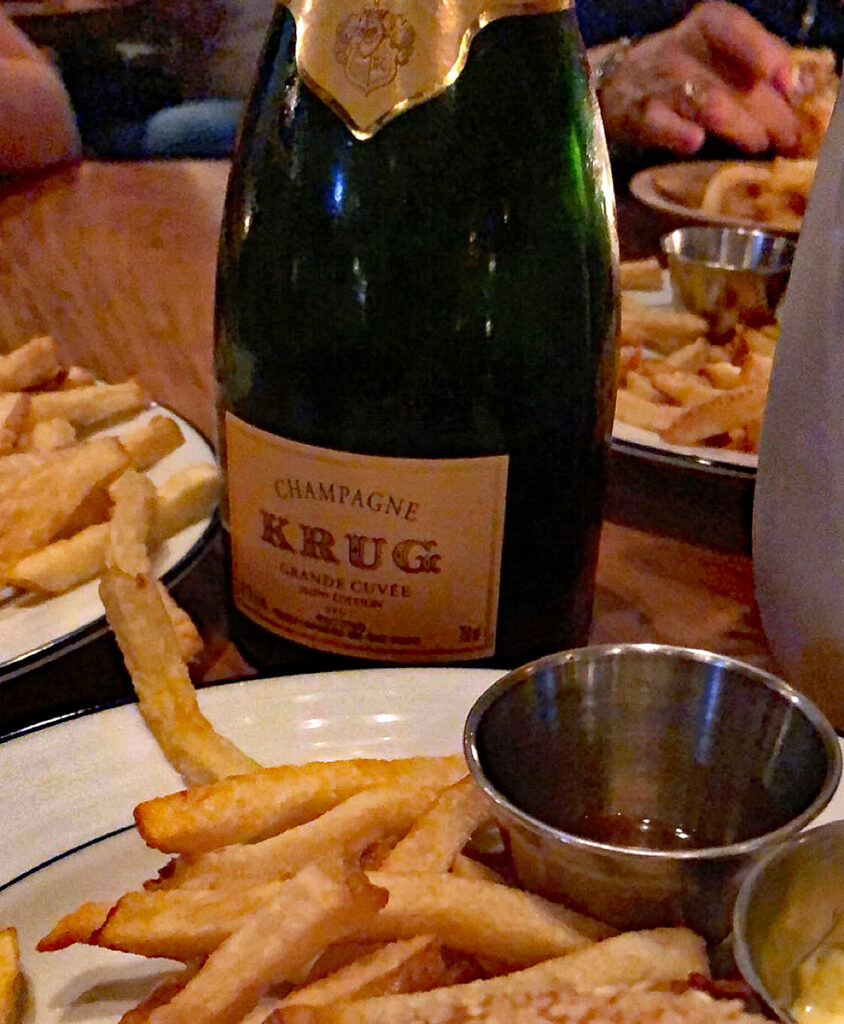
Smyth’s sommelier is as sharp as they come and, all the more, the most personable in Chicago fine dining. When he fails to greet you himself at the door, you can be entirely sure he’ll stand ready to pounce the moment you are seated. Of course, he always comes bearing gifts: a welcome glass of Champagne from Bruno Paillard, Charles Heidsieck, Paul Bara, or Dom Ruinart. On many a magical evening, the first sip that whet your whistle was even Krug “Grande Cuvée”—not a bad welcome tipple! After a warm exchange of pleasantries, the sommelier gets down to brass tacks: what will you be drinking this evening?
This conversational style of wine service works wonders, as Smyth’s sommelier possesses none of the imposing bearing that characterizes the profession, particularly in rarefied dining rooms boasting Michelin stars and Wine Spectator awards. In fact, the word “lovable scamp” comes to mind. But this is not to say that the man isn’t a total wine geek—he has the “GG” (a designation for exceptional wines etched onto bottles in Germany) tattoo to prove it! While Smyth does offer three tiers of wine pairings, there is not the slightest effort made to shoehorn guests into one of those boxes (à la Alinea or, especially, Next). For a typical meal at the restaurant (that is to say, for the middle-priced menu that is neither an abbreviated nor extended tasting), a “Traditional” pairing is offered at $90, a “Reserve” at $165, and a “Super Mega” at $255. Such a sliding scale is not only generous, but it avoids manipulative language like “standard” (instead of “traditional”) or “ultra” (instead of “super mega”) which serve to turn the emotional screws on guests already indulging in a special experience.
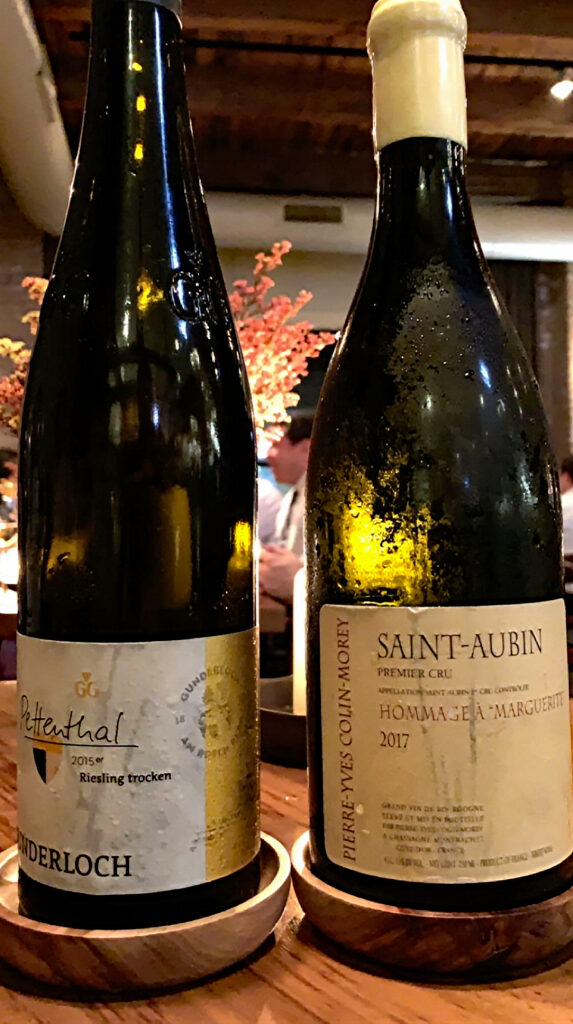
These pairings—which may include beer and sake with certain courses—are principally devoted to wine. However, in line with a hyper-seasonal menu which may change from week to week, the offerings are anything but cookie-cutter. The number of pairings sold, either in advance or on the spot throughout the evening, empower Smyth’s sommelier to open wines of greater age and pedigree. Thus, on evenings when other patrons are particularly thirsty for top-tier wine, the “Reserve” and “Super Mega” pairings may include Clos des Goisses, Keller Riesling, Premier Cru Ramonet, Jamet Côte Rôtie, or Sandrone Barolo with a decade or two of age. Dessert is almost certain to feature Port, Madeira, or Rivesaltes with many decades of age. In this manner, customers’ enjoyment of wine during the meal has a cumulative effect, increasing pleasure for all parties involved (rather than serving merely to pad the establishment’s pockets). The pairings have always struck you with their generosity and the singular nature of their curation. Yes, some wines and some dishes form longstanding companions; however, the overall sensation is one of celebrating wine, in the moment, with none of the parsimony that, at other fine dining restaurants, reduces it to mere “beverage.”
With that in mind, Smyth’s sommelier is always sure to alert you to a particularly good wine pairing which has taken shape that evening. On other occasions, ordering a round of “Super Mega” pairings for the table will prompt him to put something together—in line with your tastes—on the spot.
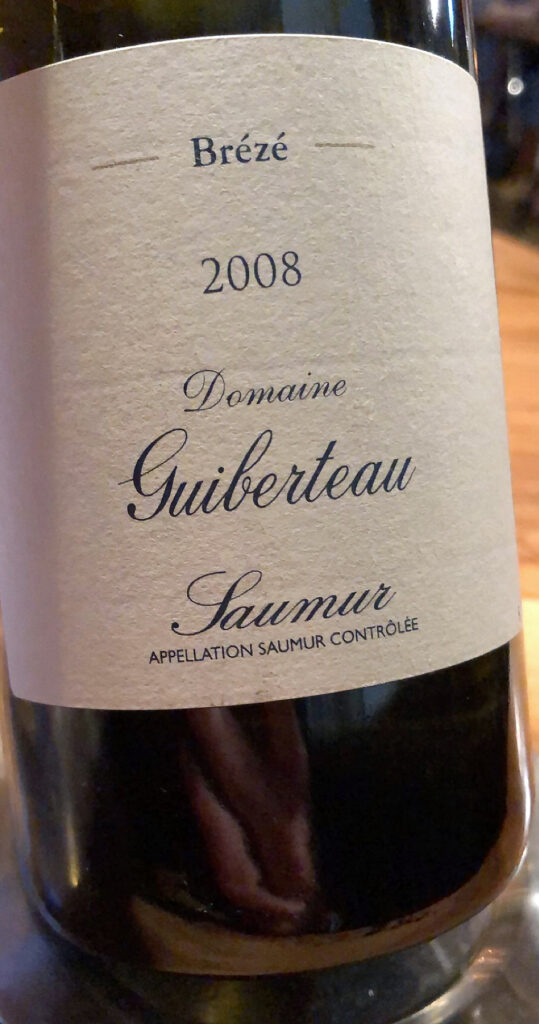
Those opting to order beverages à la carte will find themselves spoilt for choice. To start, the leather book features a range of libations made from the bar cart situated at the front of the restaurant’s lounge. Offerings like the “Smyth Manhattan” (with black trumpet bitters) and “Smyth Milk Punch” (with sweet corn) incorporate a taste of The Farm into their classic recipes. Likewise, Smyth’s non-alcoholic offerings—which can be expanded into a pairing that extends over the course of the meal—draw on the same pantry of fresh and preserved seasonal ingredients. (Not to mention, these non-alcoholic selections are actually designed by the restaurant’s head chef, which would seem to make them a kindred expression of the tasting menu and not a mere afterthought).
Three local beers (from Indiana, Illinois, and Michigan) are offered at seven dollars each. Two fancy brews (from France and Japan) will both run you thirteen. And, while the cocktails and beer are more carefully curated on Smyth’s menu, the staff hasn’t the slightest problem sneaking downstairs to The Loyalist and delivering any number of more standard brands and mixed creations from the full bar below. The ultimate goal being, of course, pleasing the customer any way they can (while also being sure to display the more unique wares that distinguish the fine dining space from its subterranean “brother”).

As well-attuned as the wine pairings are to the tasting menu, one can hardly go wrong ordering from the bottle list. You would urge guests to peruse the selections one way or another, as Smyth’s cellar has—over the course of but a few years—become one of Chicago’s most estimable (outshining Alinea, Boka, and Oriole in its selections while competing with Maple & Ash, if not in breadth than in pricing). By the glass selections have included non-vintage sparkling wines (priced from $15 to $30), white wines like Keller’s “Von der Fels” and Lafon’s Macon (priced around $20), and red wines made from Gamay, Nebbiolo, Pinot Noir, and Cabernet Sauvignon (priced from $17 to $27). You applaud the restaurant for ignoring Coravin offerings in favor of accessible, representative wines from great regions that possess at least a few years of age. Those ordering a mere glass or two of wine will, no doubt, miss out on some of the list’s riches, but they can hardly be disappointed with what they get for the price.
Those turning the page to look at the bottles will quickly find their tongues wagging. Most Champagne (including non-vintage and millésimes like 2011, 2009, 2007, and 2004) falls in the $100-$200 range. Smyth is partial to larger houses like Billecart-Salmon, Ruinart, and Laurent-Perrier alongside grower-producers such as Bruno Paillard, Paul Bara, J.L. Vergnon, and José Dhondt. The Chardonnay section is marked by premier cru and grand cru Burgundy from producers like Robin, Gagnard, Pernot, and Fichet. The list, over the past year, has also seen a greater influx of Lafon’s top cuvées (rarely seen anywhere in the city). Domestic offerings of the grape—from Lingua Franca, Rhys, and Hudson, among others—offers even greater value. But, apart from the very best selections, customers can get any number of great Chardonnays (with a healthy bit of aging) for less than $200. And oddballs like Emmanuel Rouget’s 2014 Hautes-Côtes de Beaune Blanc, priced at $100, are an absolute steal.
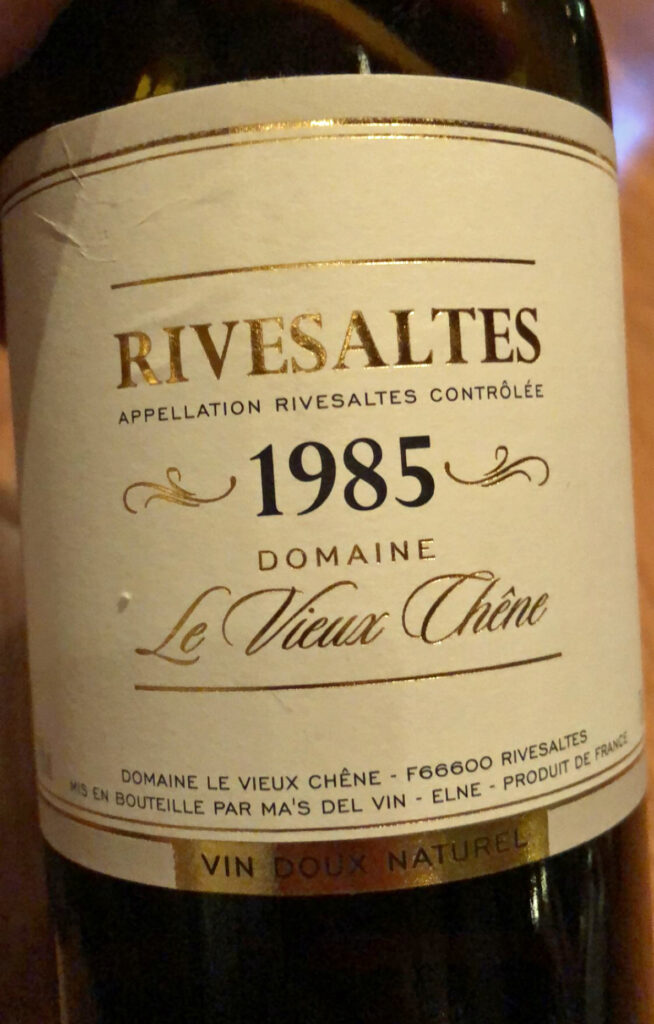
Keller’s Rieslings—particularly the full range of GG sites and even the G-Max itself—have been mainstays of the wine list’s section on the grape. Buying allocations since opening has enabled Smyth to offer more competitive pricing on the coveted bottles than seen elsewhere. Other great German producers such as Reichsgraf von Kesselstatt, Alfred Merkelbach, and Schäfer-Fröhlich are featured at a comparatively cut-rate price, as are Austrian Rieslings by Weingut Knoll and F.X. Pichler. Sauvignon Blanc, it must be said, suffers by being one of the less exciting sections of the list. The half dozen bottles offered at under $100 are laudable (including a 2014 Cos d’Estournel Blanc) if not exactly distinguished. Legendary Loire producers like Dagueneau and Vatan have indeed featured on the restaurant’s set pairings, so perhaps their absence on the list is a matter of limited allocations (which should, you agree, be directed towards usage on those pairings).
Chenin Blanc, however, is another of the list’s bright spots. Like Keller, Domaine Guiberteau has been collected by the restaurant since opening, meaning that the producer’s selection of superb Saumur Blanc is available for a song. (The same is true for Guiberteau’s Saumur Rouge wines made from Cabernet Franc). Speaking of red wine, Smyth’s Pinot Noir section is structured in much the same way as its Chardonnay. There are village bottles of Burgundy (from producers like Dujac and Dugat) at sub-$200 prices with premier and grand cru bottles (also from Dujac, as well as Denis Mortet) climbing up the scale. Opposite these, domestic expressions of the grape from Peay and Littorai (the latter from five different vineyards) provide plenty of options at $150-$200 along with the odd Spätburgunder from Germany.
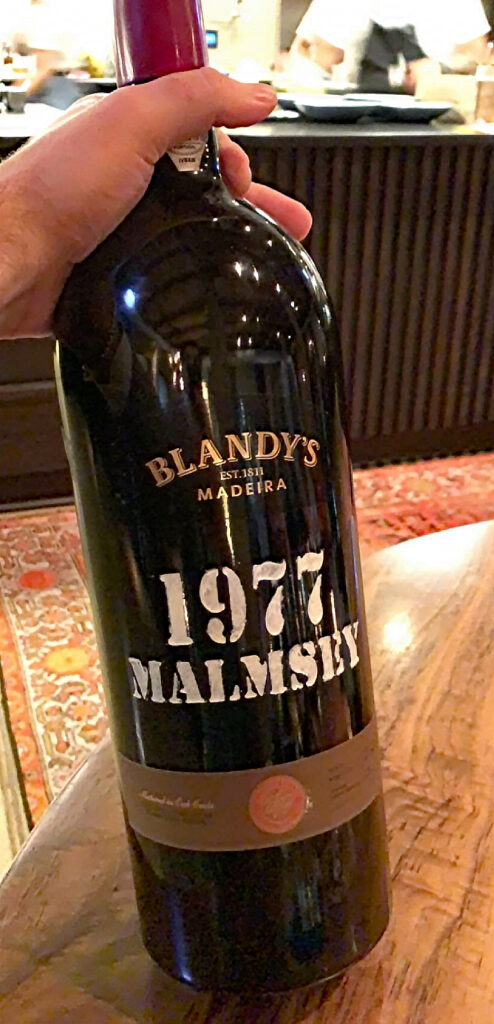
Gamay, Grenache, Syrah, Merlot, and Tempranillo (including several vintages of Vega-Sicilia’s “Unico”) are all represented on the list, in turn, with a handful of bottles. “Cabernet Sauvignon + Bordeaux” forms one of the lengthier sections, offering hallowed names such as Ornellaia, Château Palmer, and Abreu (among plenty of reliable options under $200). The Nebbiolo section is a bit shorter, yet significant, with wines by G.D. Vajra, Eraldo Viberti, Sandrone, and back-vintage Borgogno leading the charge. Dessert wines, offered by the bottle or by the glass, include white Bordeaux blends, late-harvest Chenin Blanc, Rivesaltes, Tokaji, and Port. (The restaurant has always been especially generous with these pours, which allow Urie Shields to craft desserts that offer a meaningful interplay with certain pairings).
While any attempt to represent Smyth’s wine list in this manner amounts to a snapshot, you must say that you have been impressed most of all by the program’s growth over the course of time you have patronized the establishment. What was always an exciting list—replete with hidden gems and untold value—has, under the stewardship of a new wine director brought on from Alinea, transformed into one of Chicago’s most compelling selections. The restaurant’s list does not only sustain First Growth Bordeaux, Harlan, Rayas, Rousseau, and the like—all with age—but it offers those premium wines at an attainable price. Though bottles in the $100-$200 range have long been a strong suit, each section of the list has been fleshed out (both above and below that pricing). Such development signals that Smyth is interested in the “long haul,” and, given the restaurant’s prescience with regards to producers, wine lovers will have more and more to look forward to in the years ahead. Further, given the manner in which wine pairings are constructed night to night, even amateur winos can expect to benefit from the great work being done.
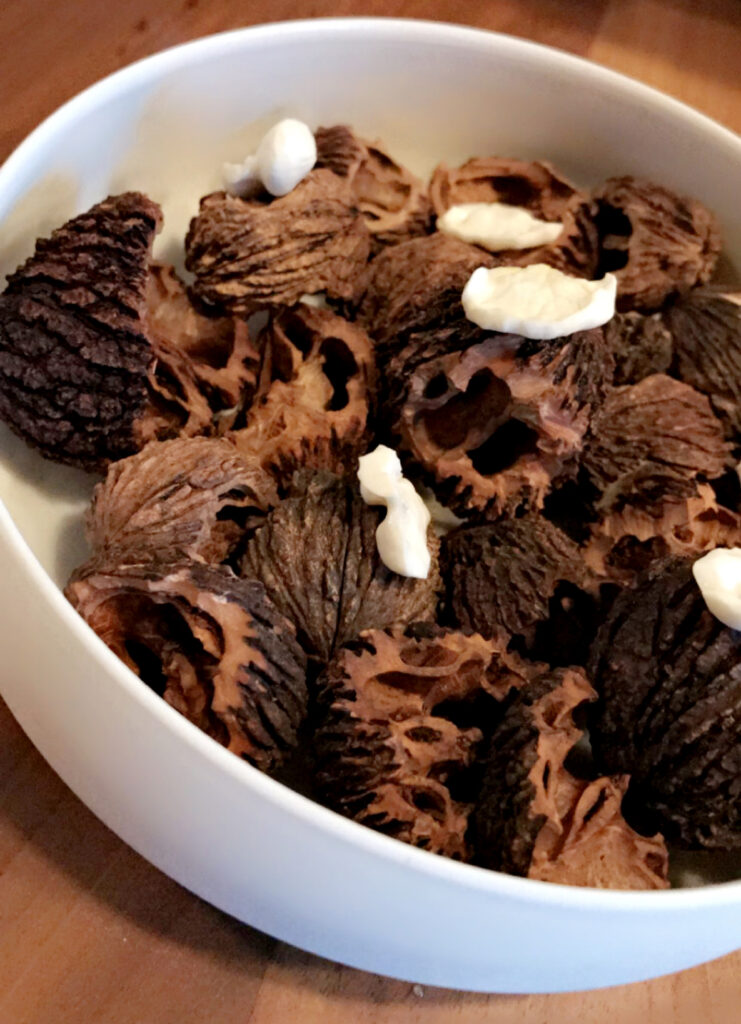
Beverages being settled, the welcome toast of Champagne having frothed refreshingly against your lips, the meal may, at last, begin. The opening interlude of bites, which has featured as few as two and as many as four or five amuse-bouches throughout your visits, reliably contains two of Smyth’s signature creations. The first, a few pale white slivers of black walnut, sit atop a bowl of the discarded shells. They taste, it must be said, like you would expect. Yet they also tell a story: black walnuts were the first ingredient the Shieldses sourced from The Farm, and the presentation (which once upon a time arrived at the table with a small book filled with pictures of the purveyor’s holdings) serves to underline the cuisine’s connection to that land. Indeed, black walnuts have been used more creatively in other dishes throughout the menu, but, here, the form a fitting foundation, centering the experience to come.
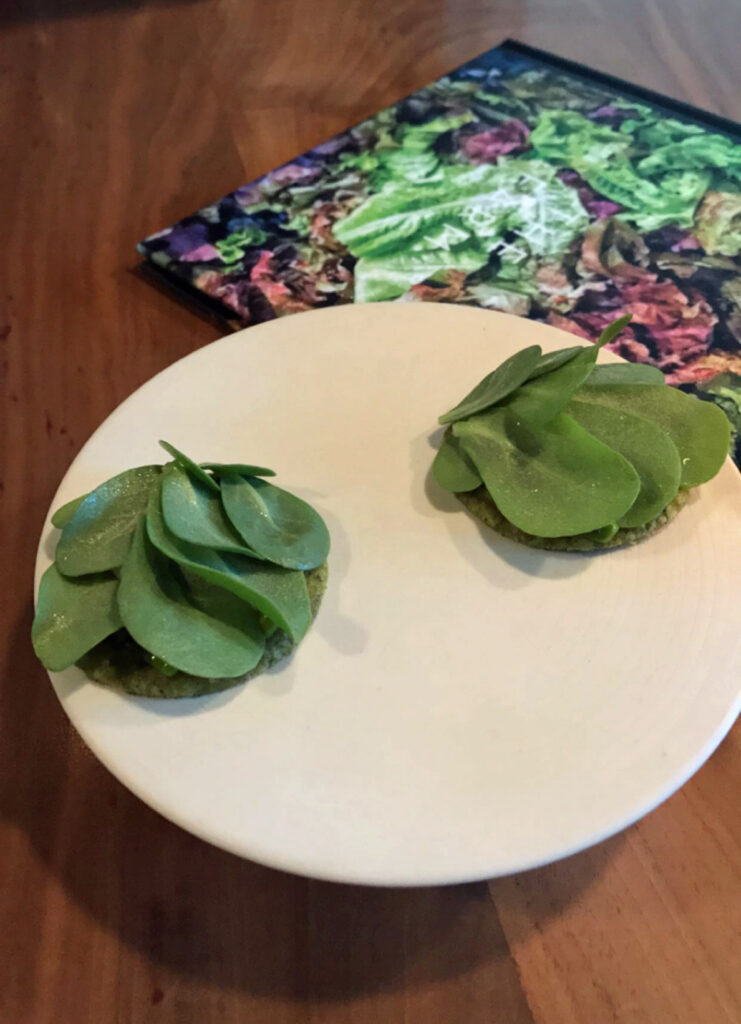
Another classic opening bite, served even more invariably than the walnuts, is Smyth’s so-called “sea lettuce cookie.” Each rendition of the cookie starts with the same base: a super crumbly biscuit strewn with powdered seaweed. Atop this thin cookie sits a dollop of cream. Sometimes the cream is milky white. On other occasions, it has taken on a green hue that matches the shades seen in the biscuit. No matter the color, the cream serves to moisten the tongue as it contends with the drying effect from the crumbly base of the bite, lending it a slightly sour—yet still vegetal—note.
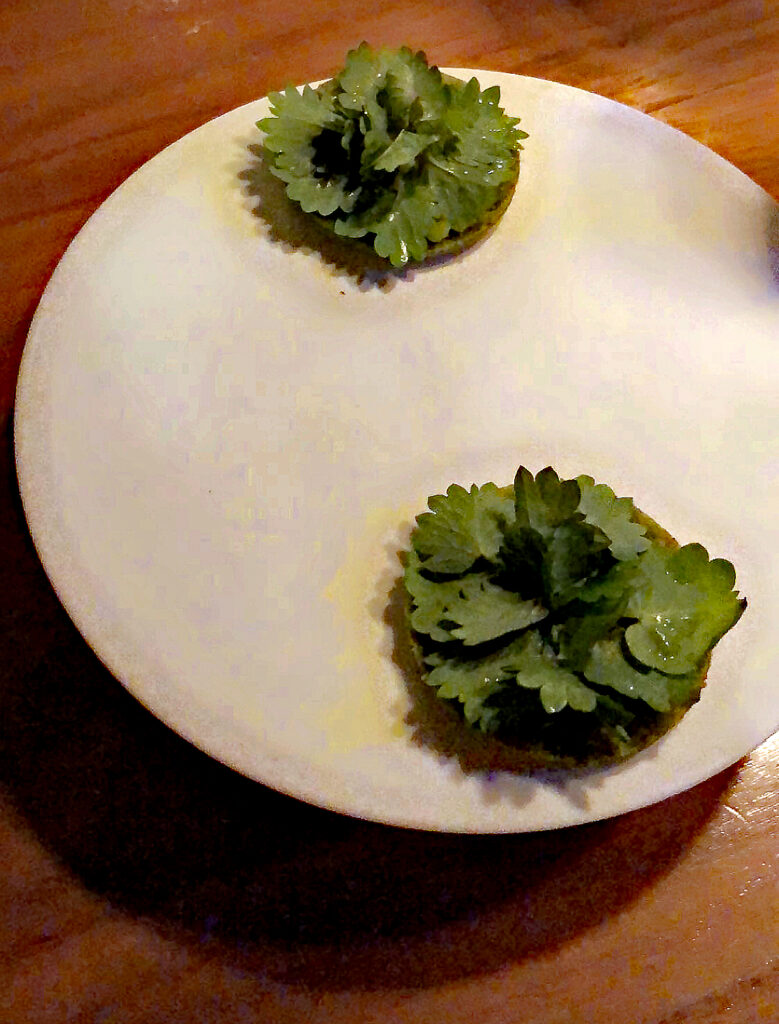
Crowning each cookie is the titular “sea lettuce” (a catchall term for the seaweed and edible algae that lines the coasts of the world’s oceans). On any given evening, the exact species of lettuce topping your cookie could be different: members of the genus might taste the same, but they take on myriad shapes and sizes. Added to this bouquet are all sorts of edible flowers and fresh herbs from The Farm, an ever-rotating assemblage in and of itself (that makes for a lovely “land meets sea” effect). On one occasion, the cookie arrived topped with a thin twirl of salmon sashimi. On another, the term “cookie” was replaced by “voulevant,” a reference to Carême’s vol-au-vent puff pastries (and a term that surely was in use at TRU or Charlie Trotter’s). You have even seen the cookie discarded altogether from the bite before, the result being something akin to a seaweed “taco” set inside a giant leaf.
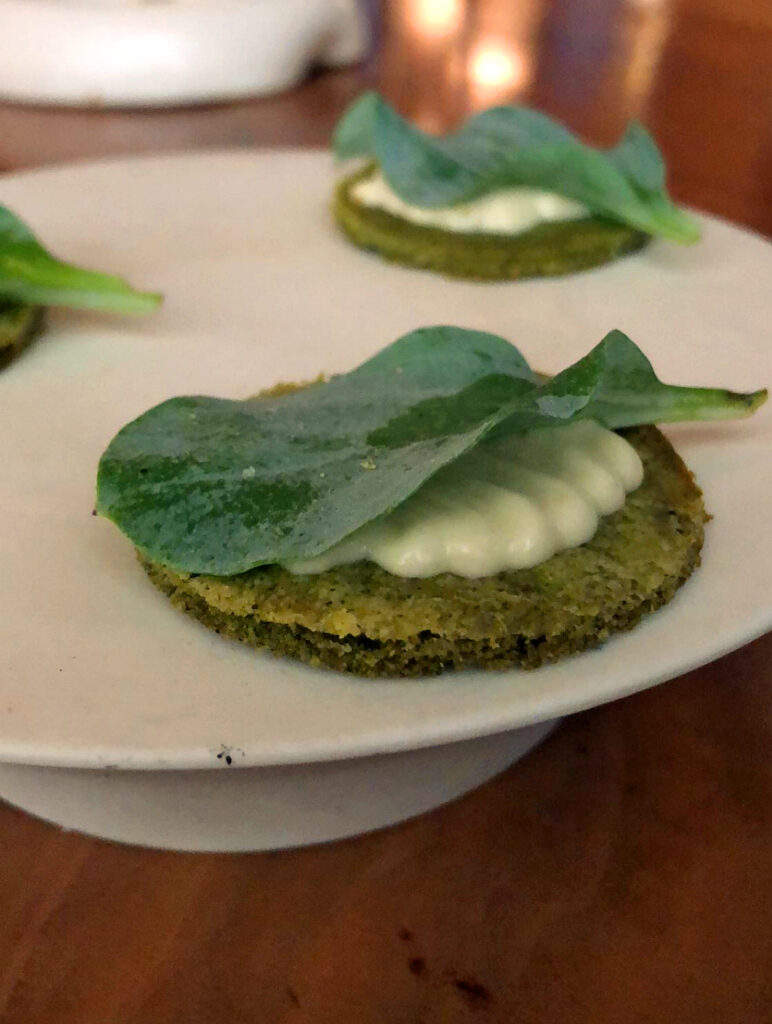
Whatever the exact form it takes, the “sea lettuce cookie” stands as one of the ultimate testaments to Smyth’s ethos. Yes, the bite is easy to overlook at first. It’s tasty—combining the umami of the crumbly seaweed cracker with the sourness of the cream, the freshness of the greens, and the essence of the ocean—and it’s extraordinary when paired with Champagne. But it’s also gone in an instant and quickly overshadowed by the many dishes to come.
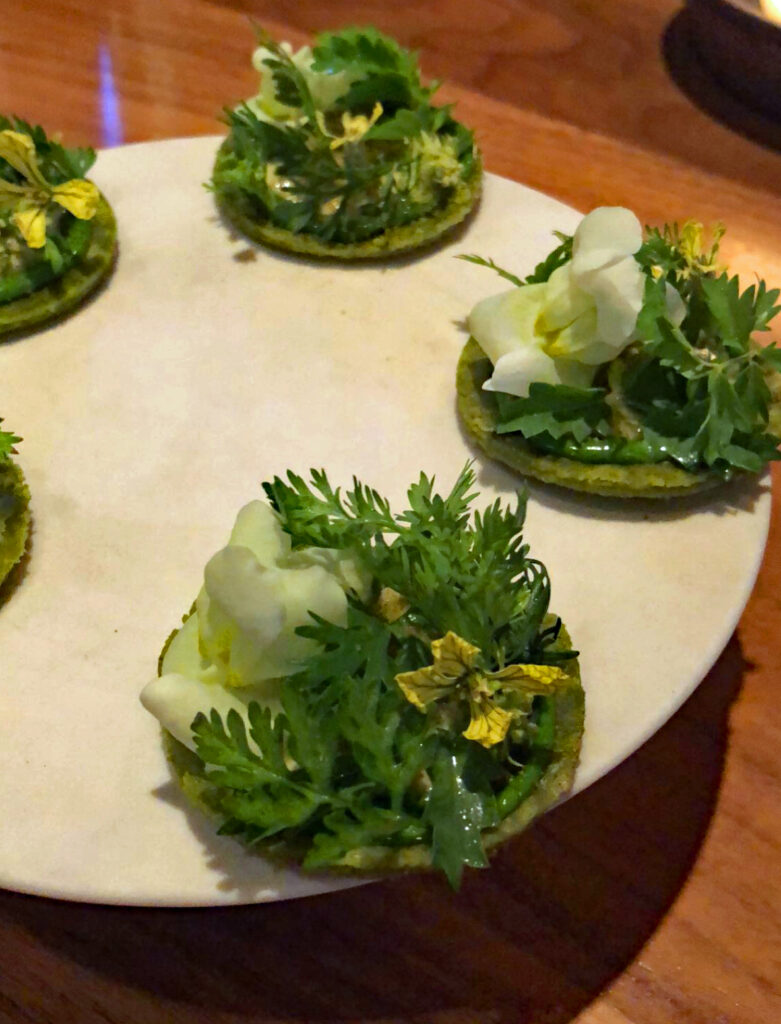
However, over the course of repeat visits to the restaurant, that cookie becomes something of a totem. It’s always there and, yet, slightly different. The parts are tinkered with, the form changes here or there, but the essence is the same. The effect is the same, titillating the palate with the algae’s gentle caress. Though its place in the meal is relatively minor, the restaurant builds each “sea lettuce cookie” fancifully, organically as if it were the very first time it was served. The bite is perpetually changing, just as all of Smyth’s cuisine is, but never loses sight of its unwavering goal: excellence.
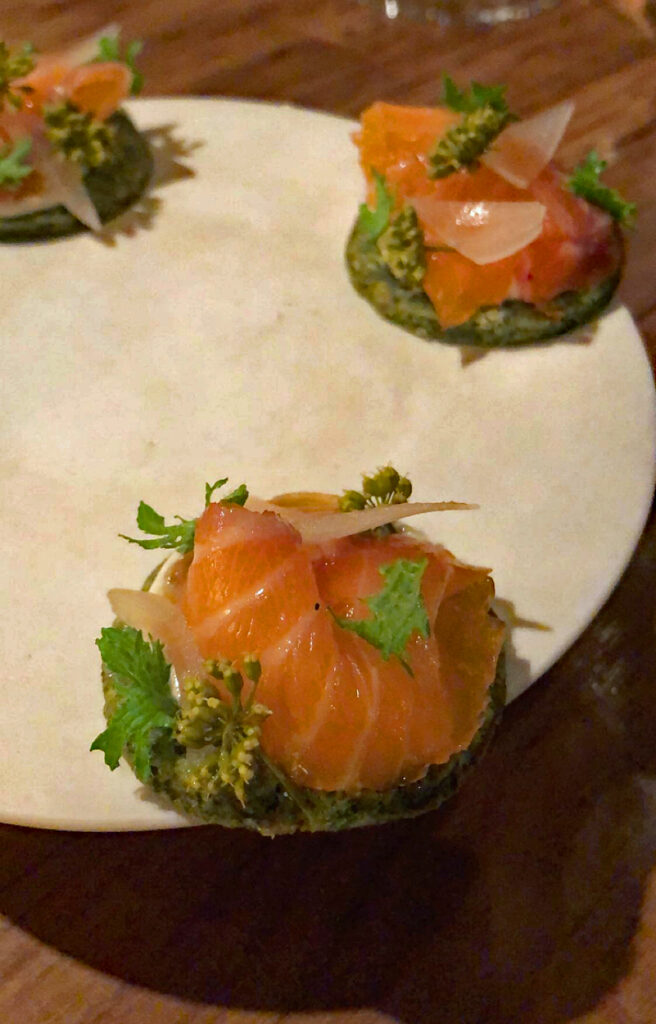
Every time a diner comes face to face with that familiar morsel, they are reminded that, here, the details really do matter. Nature does not allow her treasures to be frozen in time forever. One can never hope to perpetually hold her bounty in a set “form,” no matter how exacting. Rather, the bite reminds us that Smyth is a living, breathing restaurant wherein one tastes not only the season, but the moment. This moment, expressed through this “sea lettuce cookie,” that will never be the same again. Not a bad bit of romance for a bite that amounts to “bycatch.”
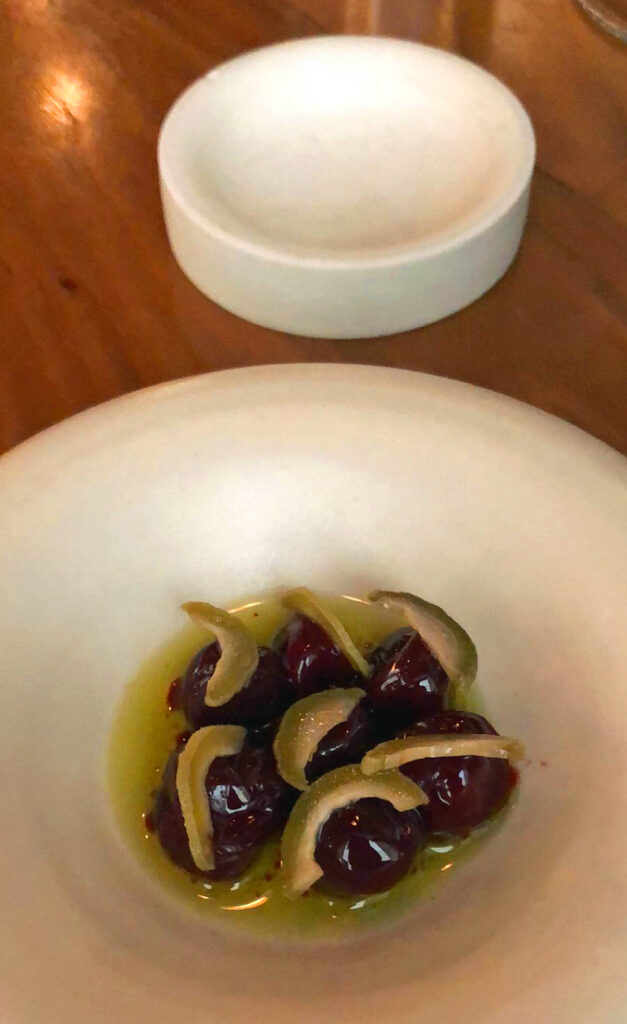
Other amuse-bouches, served alongside (or in place of) the walnuts and the seaweed cookie, have embraced this hyper-seasonal perspective all the more. They have included a small bowl of pitted cherries with sliced olives in olive oil, halved black mission figs glazed with a blue cheese “syrup,” raw asparagus paired with raw oyster, and a “fruit platter” filled with two types of cherries and some picturesque green almond slices (all poked and eaten with skewers). As seen throughout the Shieldses’ time at Town House, the name of the game with these bites is the worship of raw ingredients.
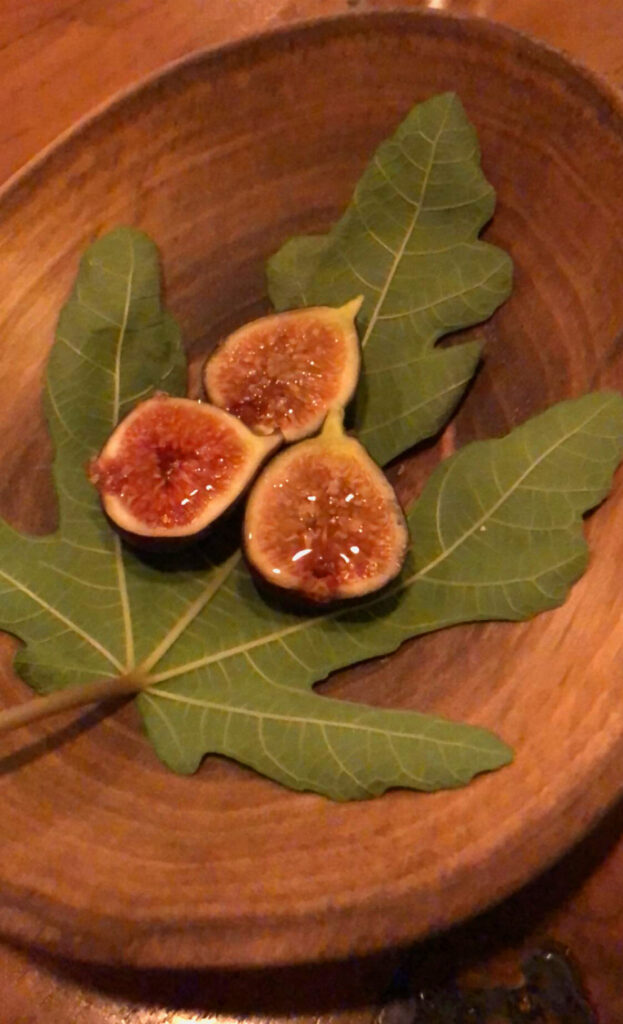
Whereas other restaurants imbue their opening morsels with a high demonstration of technique—so as to impart as much flavor as possible into a diminutive form—Smyth’s amuse-bouches are all about subtlety. This is no place where buzzwords like “truffle,” “foie gras,” or “caviar” are trotted out at the start to shock and awe skeptical customers. Rather, the restaurant offers guests a humble selection from the natural bounty that forms the lifeblood of the entire enterprise. A piece of fruit, a nut, a stalk of asparagus—these are hardly the harbingers of a two Michelin star “luxury” meal. Yet they speak to the foundation that good sourcing forms at Smyth.
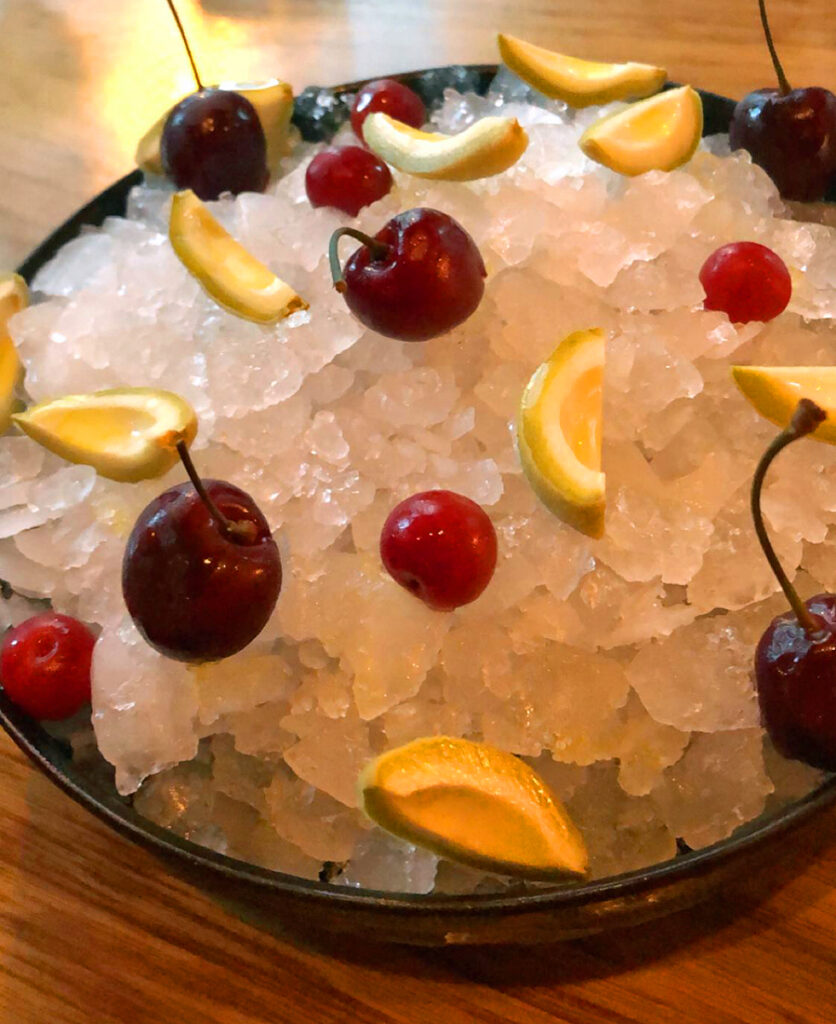
The bites assert the quality of that evening’s ingredients with supreme confidence, making clear that most of what the kitchen serves demands little transformation or ornamentation to taste good. Instead, a chef sometimes needs to know when to move “out of the way” and merely play the part of the wingman for whatever nature has, herself, designed. Surely, the subsequent dishes will be a great deal more complex. But patrons start dinner by being primed to appreciate “less” instead of “more.” Not “less” flavor, mind you, but the sort of deep flavor that finds its expression more in field and ferment than fancy presentation. It’s the sort of flavor that, shirking the trappings and expectations that have come to define high gastronomy, begs to be discovered and inevitably blows you away.
The opening sequence having passed, dinner proper typically begins with a couple preparations of seafood. Of these, oysters have formed one of the cornerstones. They are served raw, usually on the half shell, and have been dressed with garnishes such as green gooseberries & dulse; tomato & fish roe; dulse, apple, & spruce; radish & strawberry; and salted plum. The oysters also often find themselves festooned with the same sort of seaweed used in the amuse-bouche cookie, a minor accompanying note that, nonetheless, forms a nice linkage between courses.
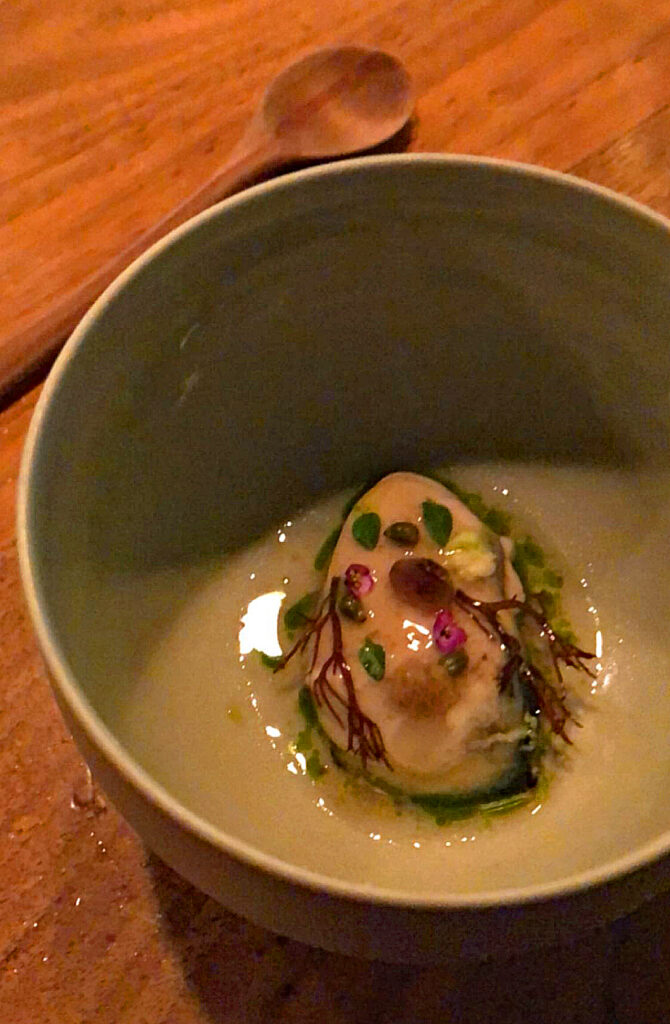
Smyth has been partial to serving Beausoleil oysters from New Brunswick, Canada—a small variety known for its mild brine and bright, clean flavor characterized by cucumber and green melon. When served within its own shell, the restaurant reduces the aforementioned garnishes into syrups and slivers that can be easily slurped in one fell swoop. On other occasions, the oyster is removed from shell—its brine carefully retained—and placed at the bottom of a bowl. It may even be gently smoked before reaching this resting place. In either case, the accompanying fruit garnishes take on the form of cold broths or, better yet, frozen slush. More textural components like the dulse or fish roe are given greater room to dot the plate.
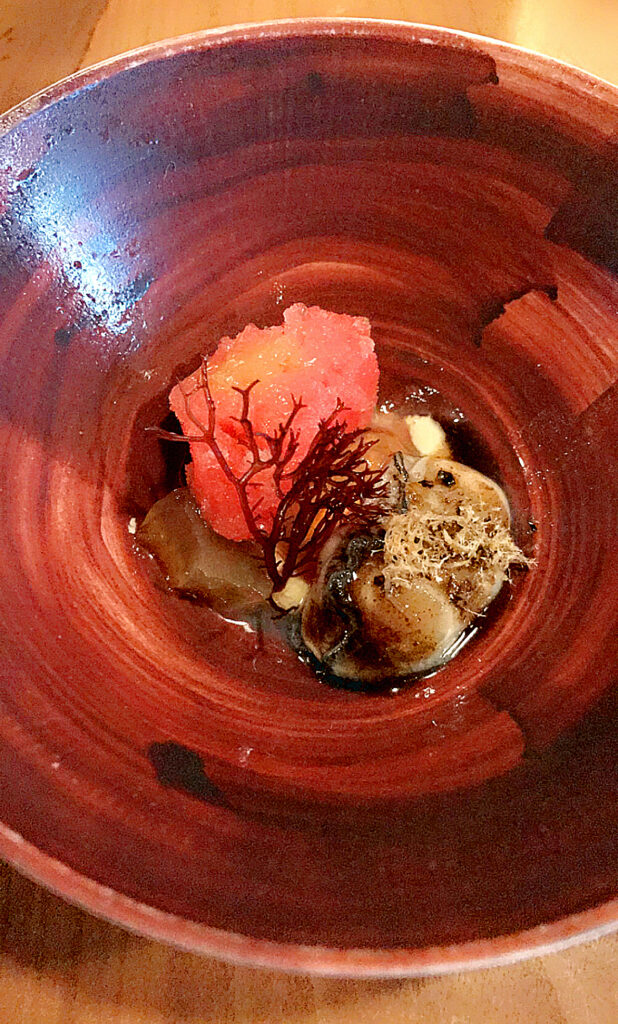
No matter the exact form (which perpetually changes), Smyth’s oyster preparations have long succeeded in using the bivalve as a canvas for produce both preserved and fresh. A good mignonette is, of course, a marvel, and The Loyalist has appended a fine example to the seafood towers served downstairs. But the range of garnishes used upstairs move beyond mere acidity and the tang of sourness. The gooseberries, strawberries, apples, and even the tomato and plum, in turn, provide genuine sweetness (to say nothing of their own tartness) that partners wonderfully with the Beausoleil’s latent melon notes. Opposite this, ingredients like radish may provide a contrasting sharpness while those such as fish roe and dulse amplify flavors of the sea. But the textures, processed down into sauce or slush so as not to overshadow the delicate oyster, are totally unerring. One savors those few seconds in which the bivalve dances on the tongue before diving back into the bowl to drain every drop of its dressing. In this fashion, the “raw oyster” comes close to a highly refined ceviche with a leche de tigre that looks beyond citrus to embrace a pleasing range of other fruit flavors.
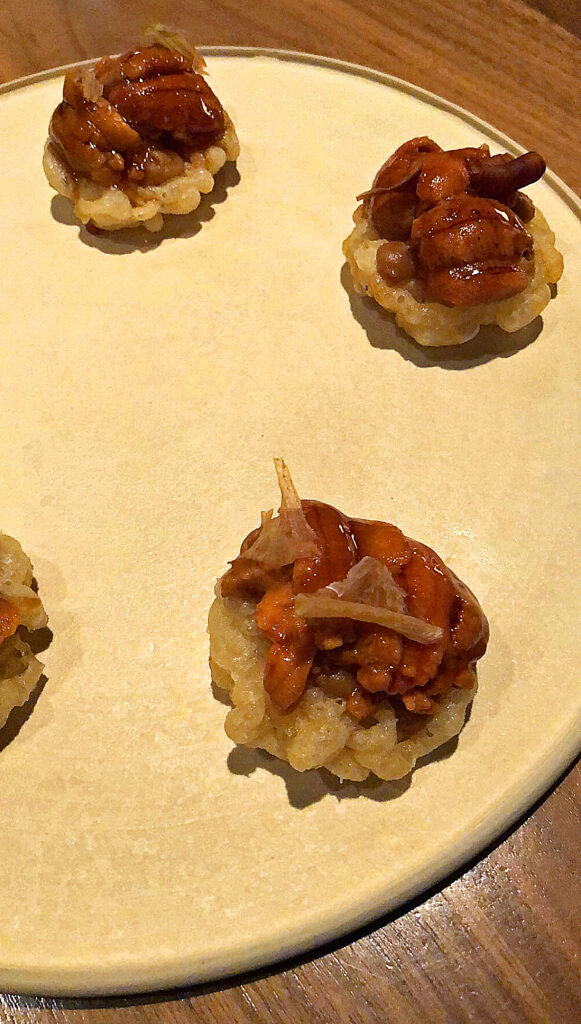
Also typically served at the start of the meal, sea urchin roe (or uni) has proven to be yet another pristine ingredient from which Smyth has coaxed out almost an unparalleled depth and intensity of flavor. On some occasions, it forms a fitting bedfellow for the oyster preparation, adding yet another delicate texture to discover within the slush of salted radish, apple, and tomato that coats the bowl.
Yet the sea urchin—typically sourced from Maine—really shines when given its own starring role—like being placed upon a puff of fried sourdough and glazed with The Farm’s own maple sap. This creation, which Shields referred to colloquially as an “uni funnel cake,” formed one of the restaurant’s most playful and creative bites over the course of several visits in 2018.
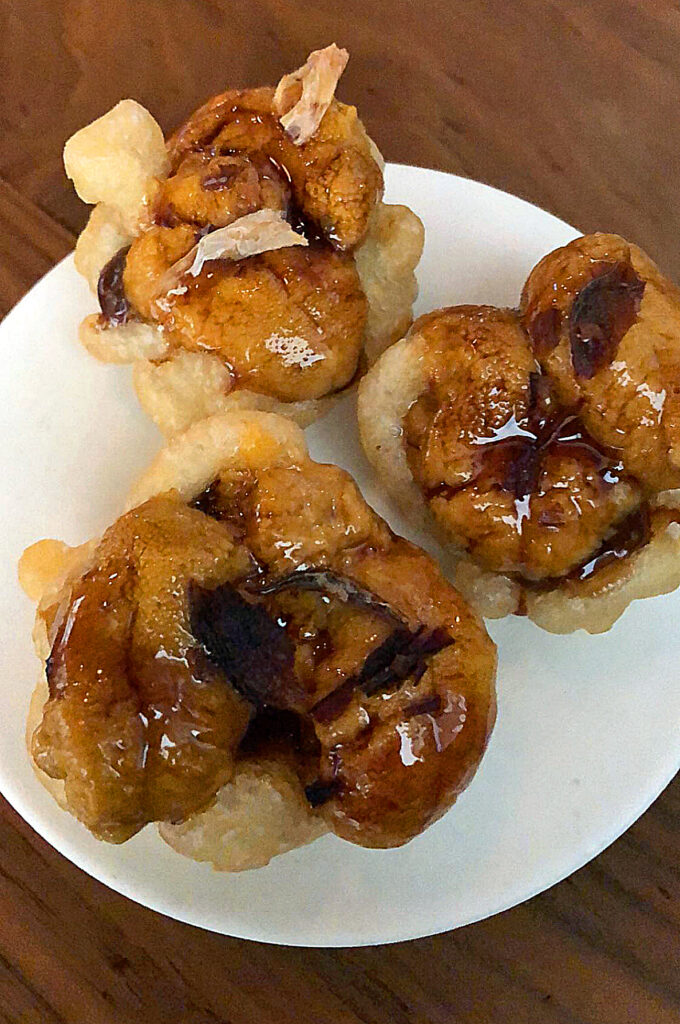
First, the warm sourdough would melt on the tongue, coating the palate in such a way that the sea urchin itself transformed into a custard with the chews that followed. Both textures would mingle, releasing the full breadth of the uni’s smooth, supple consistency and infusing it into the sourdough so as to amplify its mouthfeel. The subtle sour flavor of the dough would work to accent the sea urchin’s latent notes of sweetness and sea. Then, as a final flourish, the glaze of maple sap would extend and underline that sweetness. The end result unmistakably reminded you of “funnel cake” without compromising in its showcasing of the uni (an ingredient that may easily be overshadowed by a heavy hand). Such a dish, undoubtedly, speaks to the chef’s ability to bring luxury totems down to earth in a way that charms amateurs and aficionados alike.
As time went on, however, Smyth transitioned its sea urchin preparation into something simpler and more pristine. Ditching the sourdough, as well as the maple glaze, the restaurant took to serving the uni—just as the oyster before it—at the bottom of a shallow bowl. There, it would receive a more restrained glaze—made solely from egg yolk—and served as is.
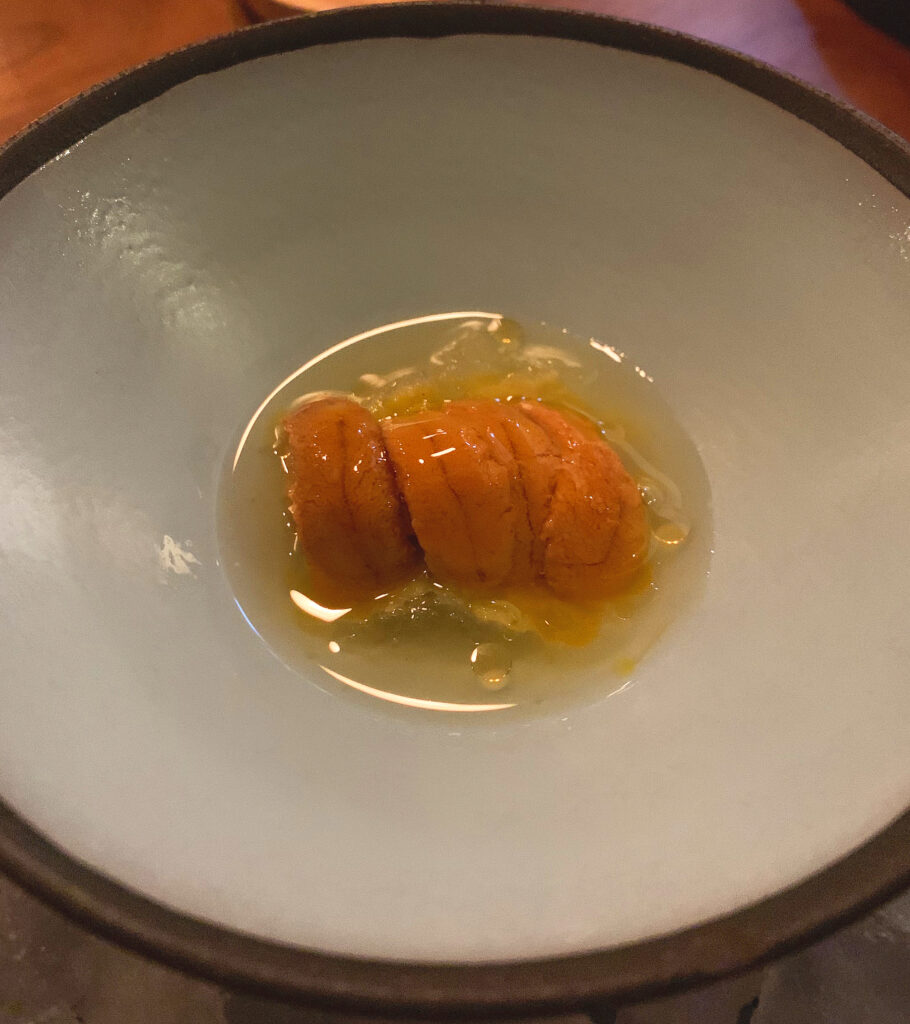
The effect of the egg, in this case, is threefold. Visually, its glistening yellow color lends the sea urchin an attractive finish, doing well to frame the ingredient’s own unmistakable orange hue. Thematically, the egg yolk grounds the uni within the world of The Farm and the Shieldses own style (eggs being, both at Town House and at Smyth, something of a signature). Further, given that sea urchin is often reserved for sashimi or nigiri preparations, the light touch of the egg yolk aligns with (and plays off of) a certain minimalist Japanese sensibility regarding the ingredient. Finally, the egg yolk possess a perfect neutral sort of richness that furthers the uni’s unctuous texture and custardy, slightly sweet flavor. (Later renditions of this dish have received a garnish of habanada peppers—a natural mutation of the habanero that lacks heat—lending additional, enjoyable melon notes to the equation while incorporating more of The Farm’s crop).
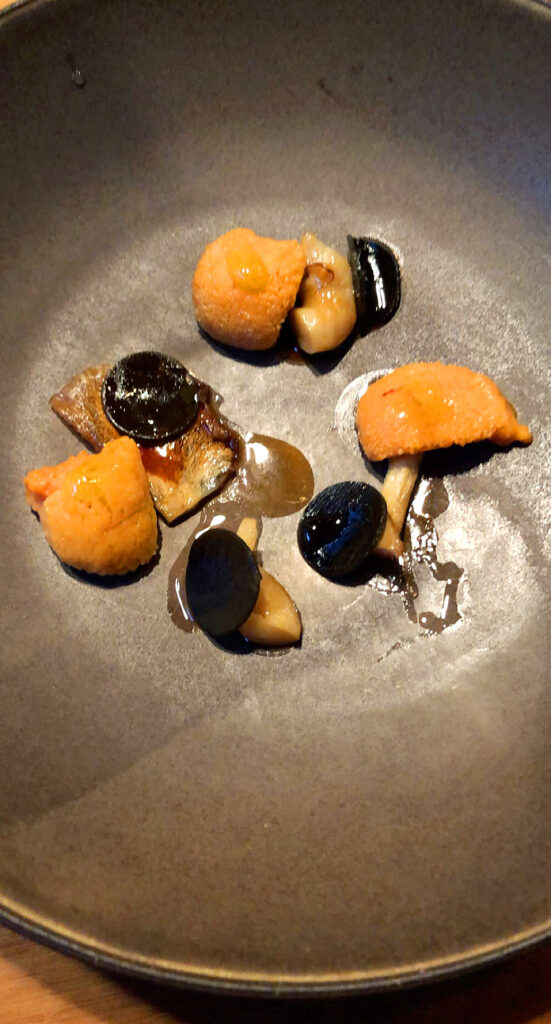
More recently, you have even seen sea urchin feature towards the midpoint of the menu—right on the precipice of the transition from seafood to meat. The dish in question, one of the most striking you have seen at the restaurant, features three picture perfect lobes uni placed around the plate. Each is paired with a slice of “soured” oyster mushroom and neatly cut circle of braised kelp. The end result is something like a surrealist painting (note how the stalk of one mushroom invites the illusion that the uni forms its “cap”). And it is, perhaps, Smyth’s most elegant of all sea urchin preparations to date. The oyster mushrooms imparting that rare combination of sour and umami while the braised kelp lends both more umami and a sea-vegetal note.
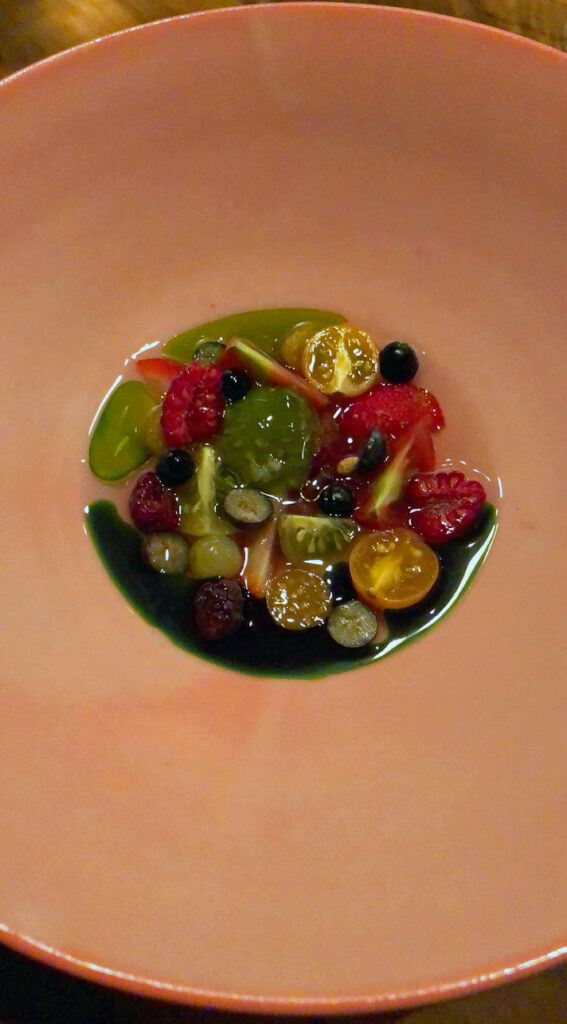
Following the oyster and the uni, Smyth’s menu might take one of several turns. The kitchen may interrupt the array of seafood with a pure expression of produce, such as fava beans (with buttermilk whey, spring onions, and chamomile), caramelized eggplant sorbet (with tomato and spices), squash (with sunflower and togarashi), a chilled soup (of tomatoes, eggplant, and peppers), a salad of late summer fruit (“nature’s skittles”), a solitary stalk of barbecued white asparagus, a turnip “ceviche,” or a carrot “aguachile.”
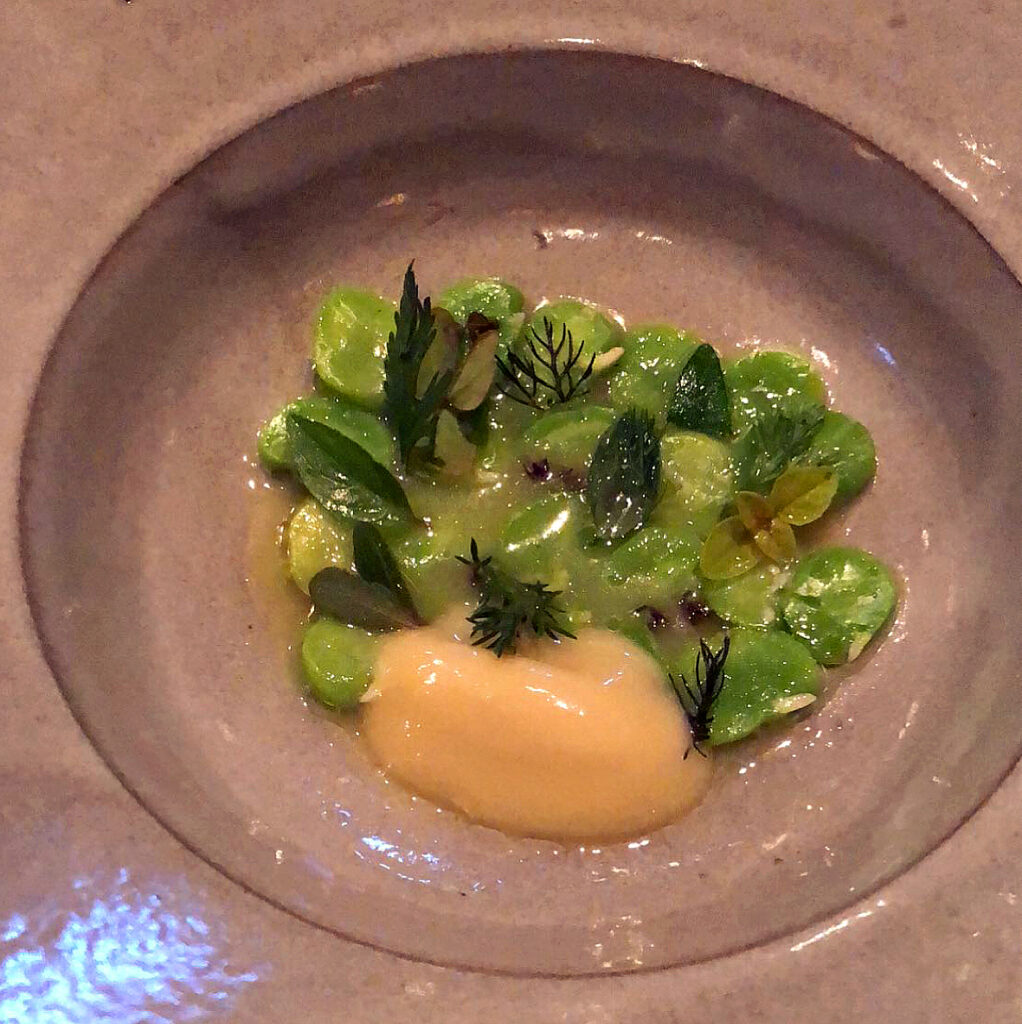
Relative to the delicacy which defines the meal’s opening courses, these vegetable- and fruit-forward creations excel in offering robust, layered expressions of complementary flavors. Some—like the fava beans, squash, and white asparagus—express rich, buttery notes. Others—like the eggplant, soup, ceviche, and aguachile—marry acid, tang, and sweetness into a jolting medley. Whatever the case, these dishes reorient guests’ attention—having, by now, enjoyed some luxury shellfish—towards the produce’s role as the “main player” in the proceedings to come. They also, by way of their intensity of flavor, make clear that balancing other ingredients (like seafood) actually serves to reign in the extraordinary flavors The Farm’s cultivars can offer alone.
But that is not to say that guests have seen the last of seafood on the menu. Instead of fruit or vegetables, the oyster and uni might be followed by a preparation of spot prawn. As best as you can tell, the spot prawn is removed from its shell and served raw—a testament to the freshness and quality of the shellfish. Rather than the plump, juicy texture for which cooked shrimp are known, this “sashimi”-style serving displays a softer, slightly gelatinous mouthfeel. Whereas the bivalves served before it (comprising just one or two bites each) are also characterized by softness of texture, the shrimp still offers patrons a greater sense of “flesh” and chew as they slice it into three or four separate morsels.
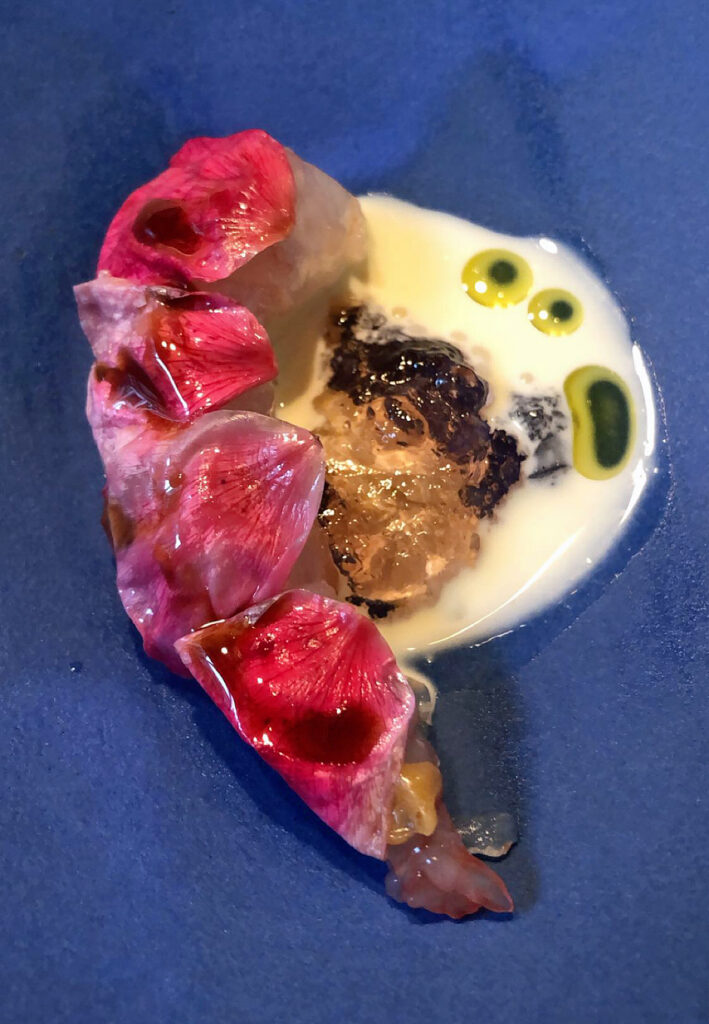
Moreover, the presentation of the spot prawn dish is utterly genius. Marinated (in fish sauce, you think) roses line the shrimp from the carapace down to its abdominal segments, forming a sort of faux shell. The prawn’s legs—which have been removed and discarded—are replicated by strands of green almond jutting out from its side. Meanwhile, the whole dish sits in a puddle of one of Shields’s signature sour/lactic sauces. In that familiar manner (which, across so many seafood dishes, can only be called masterful), the sauce amplifies the shrimp’s sweetness through contrasting notes that avoid overshadowing any sense of its pristine, raw qualities.
This same light touch with regards to raw seafood—be it oyster, sea urchin, or spot prawn—reaches its pinnacle when Shields works with caviar. It’s no surprise, given that few ingredients epitomize delicacy like those briny, nutty orbs of sturgeon roe. And yet, as you have described before, few ingredients are also wielded as wastefully. Caviar, being a hyperreal symbol of “fine dining,” a totemic luxury item par excellence, seduces chefs into thinking they need not really do anything with it. Just give guests their prized ration of roe and something to smear it on, the thought process goes, then sit back and lap up the praise. Shields, it is no surprise, sees things otherwise. Despite Smyth’s relative youth as a restaurant, his vision is clear, and no ingredient is so precious as to escape his stylistic stamp.
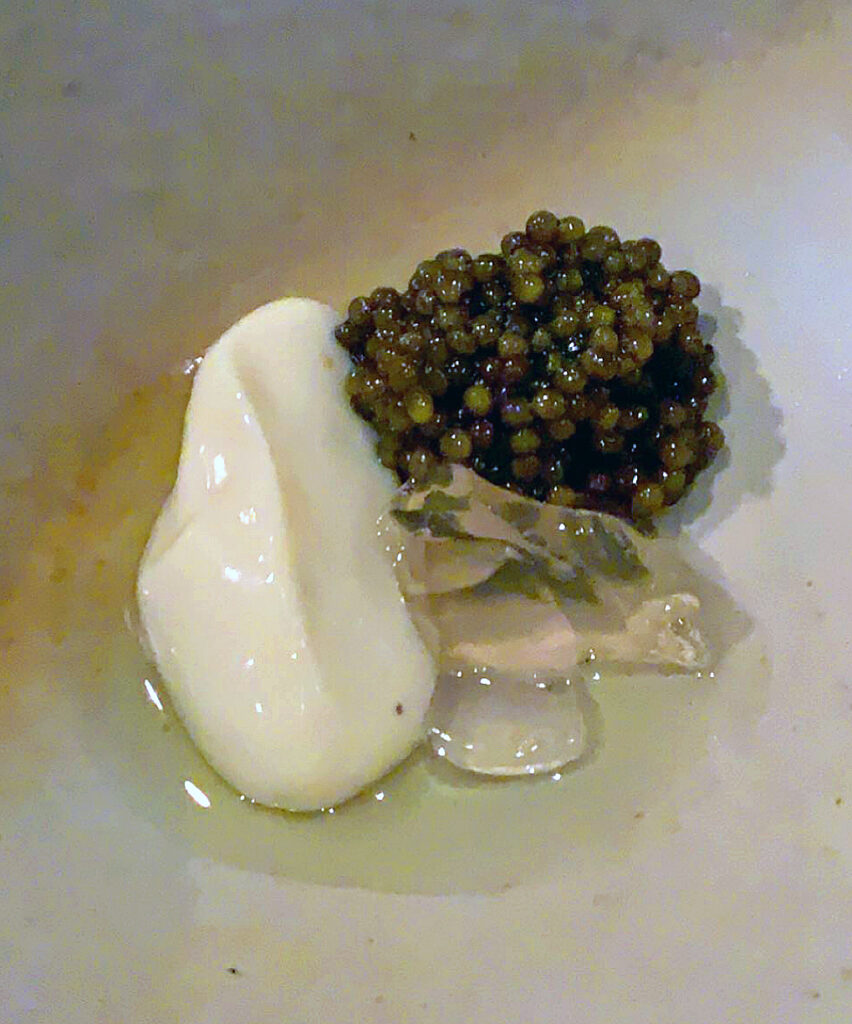
One signature caviar preparation has seen the ingredient—typically Kaluga (a sustainable “River Beluga”) caviar—paired with cantaloupe and almond milk. The fruit, depending on the iteration, is either sliced to an almost transparent thinness or shaved into a glistening, pulpy mound. Both transformations serve to soften the melon, removing any need to chew and, instead, allowing the ingredient to nestle the roe without obscuring its bursting on the tongue. The fruit’s sweetness, of course, plays off of the caviar’s saline quality and enables its nutty notes to shine. Likewise, the almond milk—in the style of those “lactic sauces”—undergirds the dish with additional sweetness, nuttiness, and a hint of sour. Married together, the components reveal in the caviar a greater depth of flavor through a layered shading of complementary flavors.
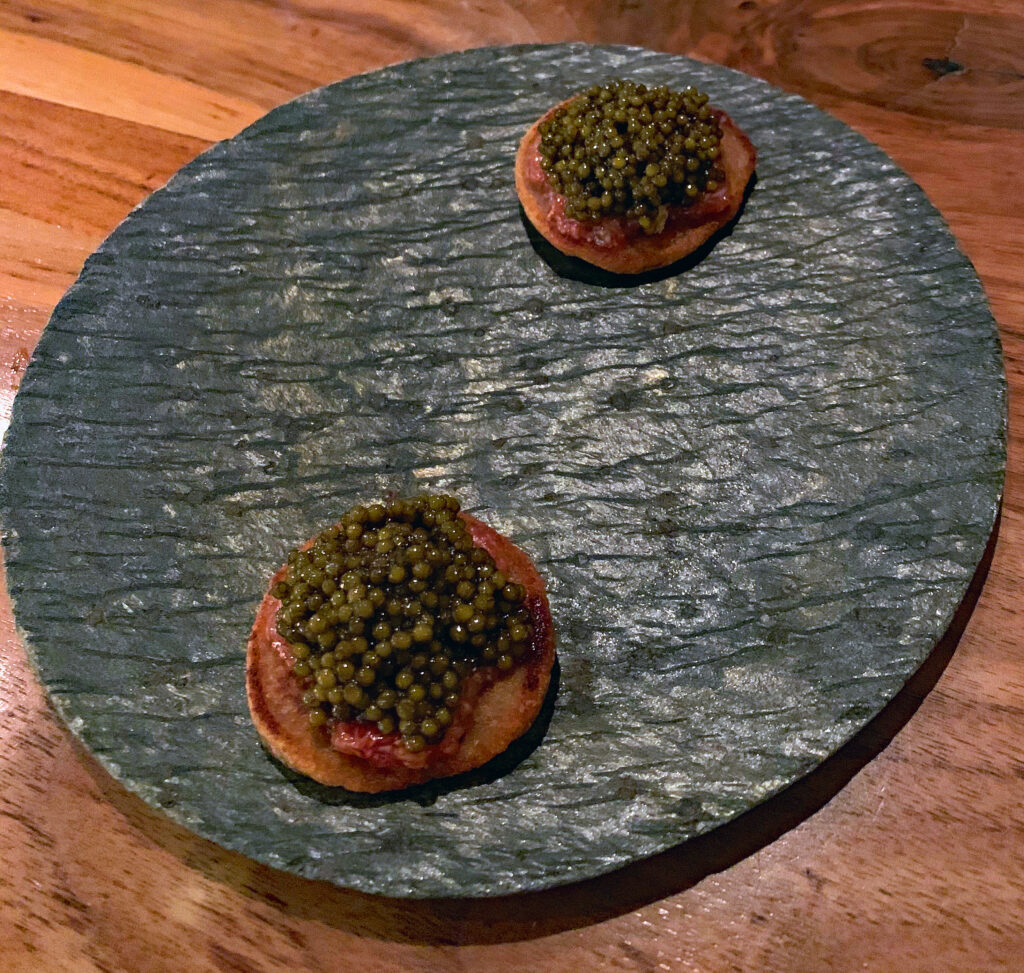
Another caviar preparation has seen the Kaluga placed atop a drizzle of chicken fat jus and nestled against a quenelle of crème fraîche. The dish is served with a pancake made from kōji—a mold that naturally grows on rice grains, forming sugars that play an essential role in fermenting both sake and miso. The kōji-coated grains can also be processed into a rice flour, with the mold displaying sweet aromas that have reminded some chefs of fresh scallops. For the purposes of this dish, the kōji lends the pancake a tinge of sweetness and umami that matches the chicken fat jus it inevitably soaks up. Both elements, of course, serve to enrich the caviar’s mouthfeel and buttery notes—with the crème fraîche coming through to provide the palate with a bit of reprieve.
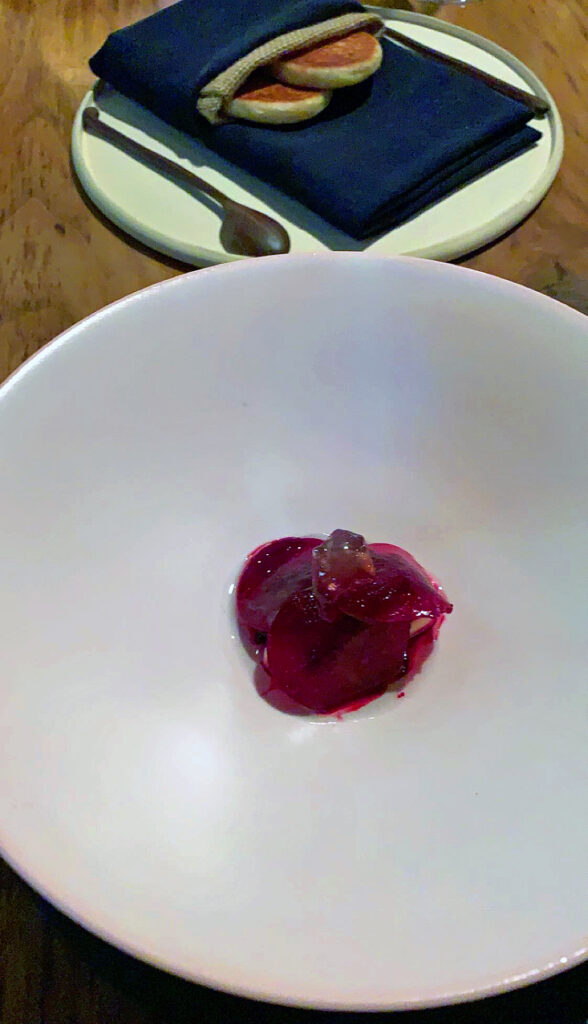
The third (and most recent) example of Smyth’s caviar expertise combines elements from the prior two dishes. The Kaluga, instead of chicken fat jus, is paired with a jus made from guinea hen. Instead of a pancake made from kōji, guests are served one made from plain brioche. However, rather than cantaloupe, the caviar is strewn with thin slices of marinated beets and a hint of horseradish. Thus, rather than just sweet and sour, the Kaluga’s accompanying flavors are earthy and even a little “hot” to boot. The end result is more multifaceted than the caviar course’s other iterations but still characterized by restraint. With fat, earth, sweet, sour, and “heat” all in play, the roe is given ample room to express itself fully.
Though each service of seafood at Smyth seems to outdo the last, you have not yet reached the sequence of fish dishes upon which the restaurant has really built its reputation. This sequence is not so much about storytelling or referencing The Farm but, rather, presents an exploration of a singular fish in all its glory. Shima-aji, also known as striped jack, is the name of the game. The fish is found in warm waters throughout the Atlantic, Mediterranean, and Pacific Oceans but is extensively farmed in the waters to the south of Japan, where it commands a high price at local markets. Shima-aji is characterized by bluish green scales, light-colored flesh, and a fatty, oily texture with mild flavor that is reminiscent of fatty tuna. The ingredient, unsurprisingly, is a mainstay within sushi restaurants (where it is regarded, you think, in a high stratum of offerings alongside hamachi but bellow tuna).
Smyth’s embrace of the fish’s Japanese name implies a sourcing from those waters and an embrace of the cuisine’s sensibility. Over the course of a couple years, you have seen the restaurant’s shima-aji sequence grow from two titillating dishes, to three, and then finally four. In whatever form, patrons reliably single out at least one of the preparations as among their favorites from the entire meal.
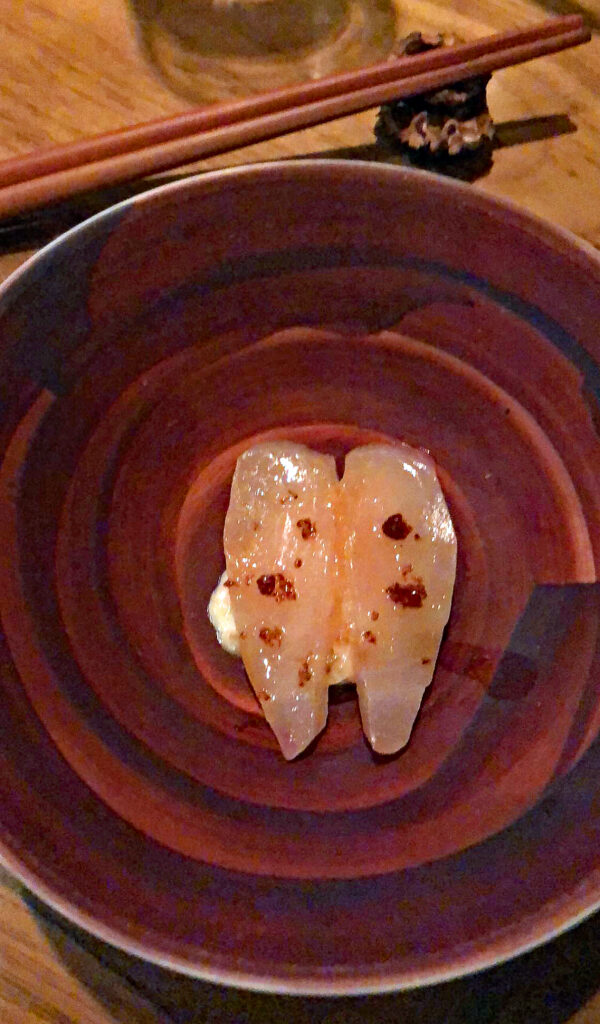
Typically, the sequence begins with something akin to sashimi. The shima-aji is cured in nuka, also known as rice bran. The bran is a byproduct of the process in which brown rice is milled into white rice, with that remaining exodermis forming an excellent “pickling bed” once mixed with salt and water and allowed to ferment. This technique, of course, reminds you of Shields’s use of kōji in the earlier pancake preparations. Here, however, curing the shima-aji in nuka imparts the same added complexity and softness edomae sushi chefs aim for when aging the fish for one or two days before serving it. (As mentioned before, farmed shima-aji’s graces are largely textural, with younger Japanese finding the rare, traditional wild-caught variety to be too mild-tasting to be worth the price).
After being cured, Shields slices the fish into slivers and places two of them, per guest, in a shallow bowl. Then, they are garnished with pine cones (pulverized into a powder) and served. On occasion, the dish will see a few drops of fish sauce, some edible flowers, or even those familiar sea lettuces added as a further accent. Yet there is no question that the shima-aji is the star. The fish maintains the slightest bit of “chew” before yielding onto the tongue and coating it with an oily, all-encompassing texture. Its flavor is slightly sweet, slightly sour (due to the curing), and complicated by the dusting of pine cones that adds a sharp, green note. The end result ensures that the shima-aji’s fattiness stands front and center before disappearing with a lip-smacking twang.

Recent renditions of this dish have seen portions cut from the cured fish’s belly and served without any sort of garnish. Titled “shima on steroids,” these prime pieces are an even purer expression of the shima-aji’s fatty texture, flavored only with the sour and umami notes of the nuka. Surely, Chicago’s sushi chefs could learn a thing or two from Shields’s sashimi preparations (and they have even admitted as much!)
The second dish in the shima-aji sequence—which, originally, formed a longstanding duo with the “sashimi”—presents a masterful utilization of a part of the fish that is typically discarded. And, while the Shieldses take on barbecue beef brisket has been all the rage throughout the pandemic, it must be said that John first made his name grilling these fish ribs.
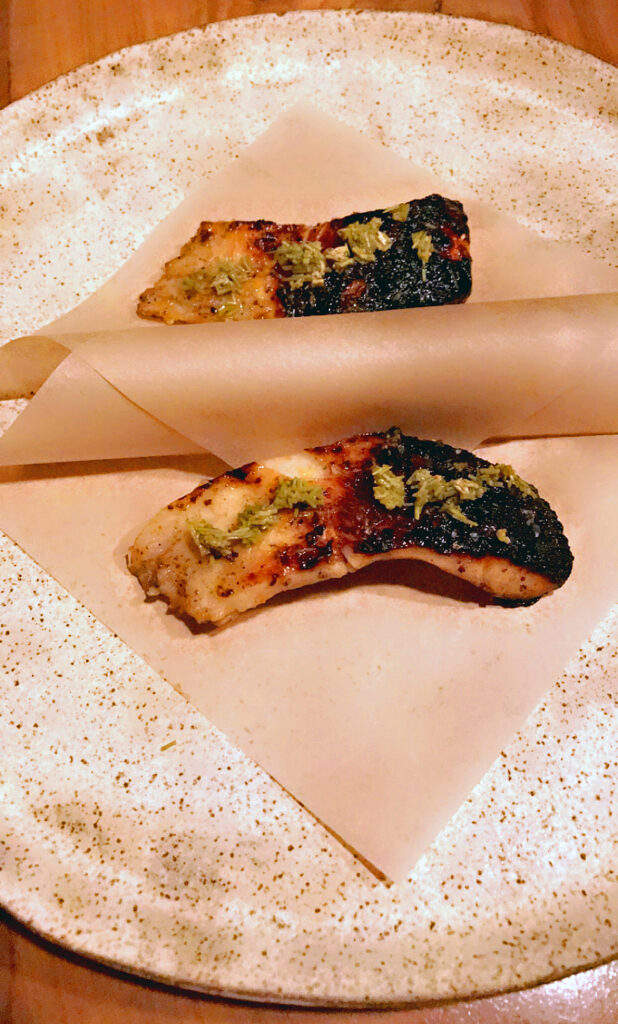
The portion served at Smyth is taken from the many thin bones that jut out along the shima-aji’s vertebrae. Between each of those bones, which are about the size of toothpicks, sits a deposit of succulent flesh. However, due to their relatively small size, the ribs would typically be overlooked in favor of preparing the fillet for customers. They’re not exactly big enough to make a meal out of (but, upon tasting Smyth’s expression, you sure would like to try!)
The chef grills the shima-aji ribs over juniper. This not only allows them to develop an attractive black char, but the smoke from the conifer imparts notes of balsamic and fresh wood. The ribs reach the table glistening atop squares of butcher paper. Guests are instructed to hold the ends of two of the bones as they drag the flesh cleanly onto their tongues. The end result begins with the sweet, caramelized notes of the shima-aji’s crust before advancing into subtle flavors of smoked fish. The fish’s texture, other than that crust’s slight resistance, is altogether luscious. It combines the natural fattiness found in the shima-aji’s sashimi preparation with a juiciness developed from grilling it “on the bone.”
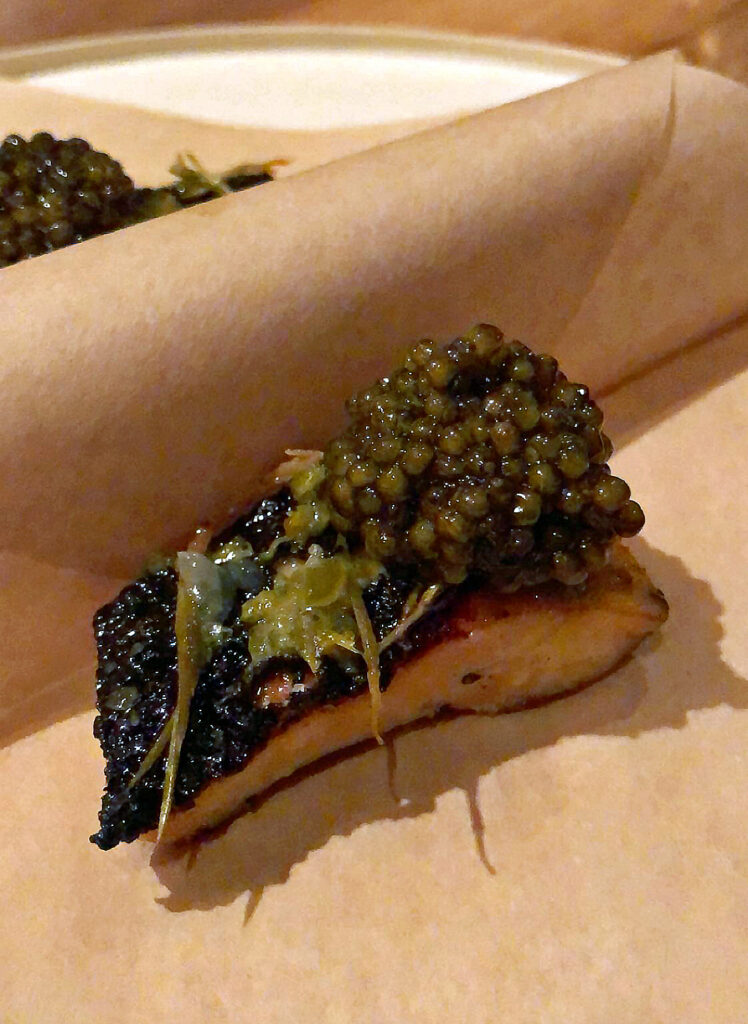
With such a supreme mouthfeel on display, is it any surprise that—for the longest time—Smyth’s Kaluga caviar found its way on top of the shima-aji ribs as a garnish? Yes, seeing a dollop of sturgeon roe resting on top of something already so unexpected and decadent would send your heart fluttering. Yes, in some ways it was a bit too much. But, in its era, it represented a veritable “mic drop” for the restaurant—a use of caviar both bold and indulgent. Today, however, you are happy to see the Kaluga given center stage in its own creations. Both it and the fish ribs shine brightly enough to command attention on their own.
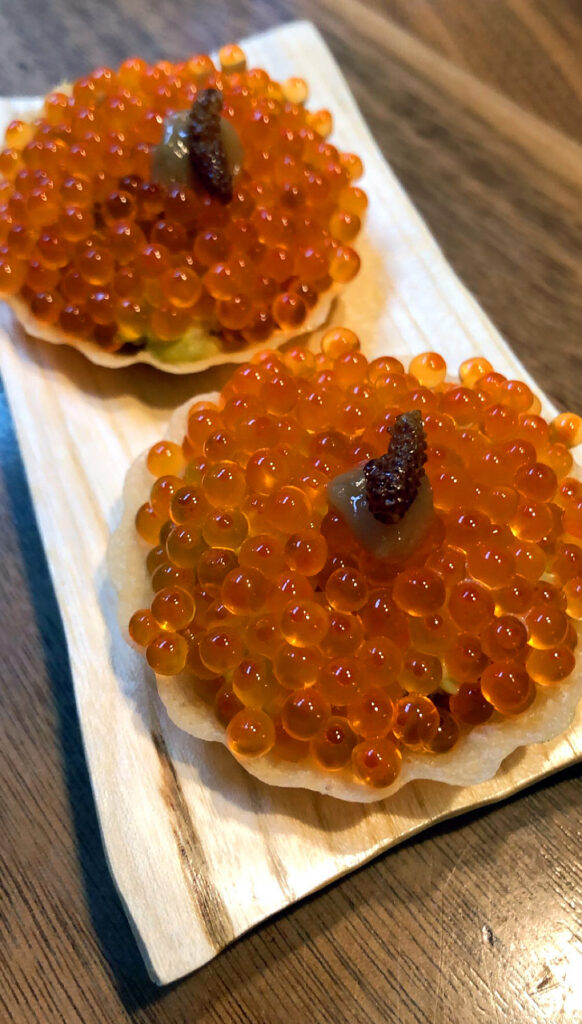
Over time, the aforementioned duo of shima-aji dishes has come to include two more preparations. First, following the pickled sashimi, was placed a preparation of shima-aji head. It is smoked and its flesh (including those coveted bits of cheek) processed into the filling for a crisp sourdough tart. The tart is then topped with a mound of glistening orange trout roe and a lone, tiny pine cone. The crunch of that cone, atop, and the crispness of the tart shell, below, serve to bookend the smooth shima-aji “meat” placed inside. And the trout roe, of course, lends each bite a delicate “pop” of saline, fishy goodness to help moisten the palate. Ultimately, it’s an artful addition to the sequence that impresses not only in its usage of yet another part of the fish, but in the flawless construction of the tart shell itself.
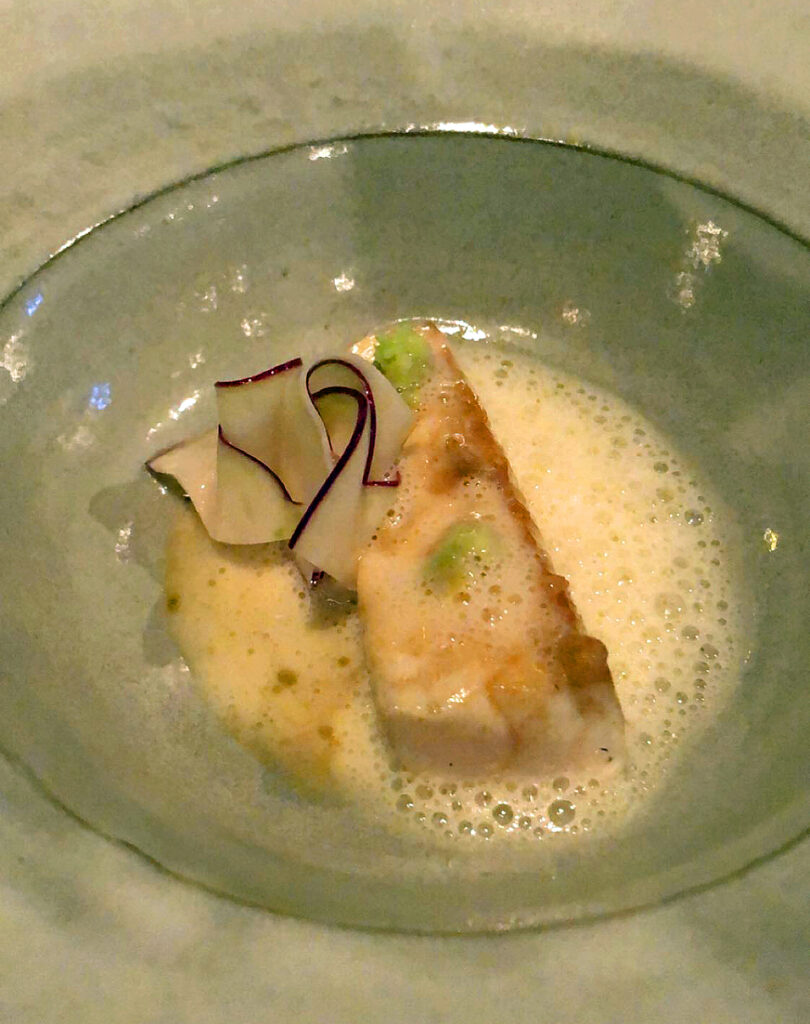
In its superlative, full-fledged form, the shima-aji saw itself used in still one more dish on the menu. And, relative to the other three, this piece of the fish—taken from the loin—is treated far more traditionally. As best as you can tell, it is pan-seared and finished with plenty of butter—likely tinged with something else—arriving at the table dressed in a puddle of froth. The shima-aji’s texture, in this case, transcends even those luscious ribs. With no bones to deal with, nor any charred crust, the loin is a dead ringer for a slab of butter. It possesses all the fattiness you love from the sashimi with all the juiciness of the ribs and then some. Simple? Perhaps, but the dish forms a welcome, classic reference point against which patrons can further appreciate the fish’s other, more creative applications.
Just as soon as Smyth’s shima-aji sequence reached its ultimate expression, Shields tore everything down and started over again. The fish had been a mainstay on the menu, in some form, for more than four years. And, while the chef’s overflowing creativity ensured that no two preparations were ever the same, such a sequence (which had, as previously mentioned, even absorbed the restaurant’s caviar course) begins to cast a shadow over the rest of the meal. The shima-aji was a sure thing, yet its cult appeal could ultimately stand in the way of bigger, better changes at a structural level. Thus, during your last visit to Smyth, the striped jack rode off into the sunset to enjoy a well-earned retirement. In its place, a new sequence dawned: the king crab sequence.
The foundation for a trio of preparations utilizing the crab had been set one meal prior. In many ways, the development of the sequence can be ascribed to Shields’s inspired creation of one particular dish: “king crab in beeswax.” Therein, plump, prime pieces of Norwegian king crab legs are steamed, dipped in the titular beeswax, and chilled. The legs arrive at guests’ tables displaying all the grooves and dimples of “shell-on” crab, yet the beeswax breaks so much more cleanly. Rather than wrestle with seafood crackers to rescue the meat, patrons are empowered to remove perfect, glistening whole pieces of the crustacean out from the faux shell before dipping them in an accompanying sauce. On most occasions, that means a butter made from crab tomalley (the prized fat taken from its hepatopancreas).
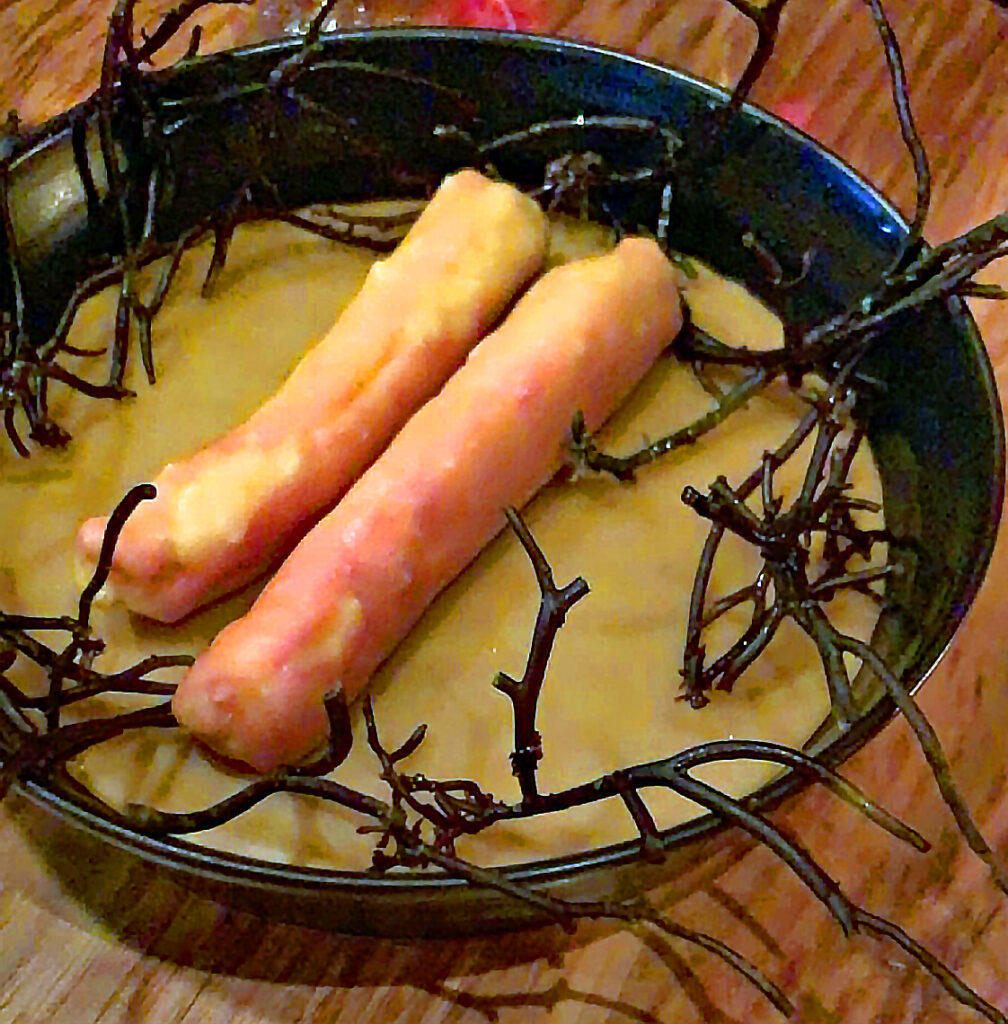
In the same manner Shields’s shima-aji “sashimi” preparations sought to express the ingredient’s purity, “king crab in beeswax” offers guests a total refinement of the seafood tower or crab shack experience. Eating king crab is typically characterized by the engrossing nature by which the crustacean’s flesh is retrieved. Be it a half, a full, or even several pounds of product, the customer becomes accustomed to grabbing a shell, carefully removing its meat, and enjoying the fruits of their labor with a squeeze of lemon, some butter, or a Dijonnaise. Rinse and repeat. The labor involved—which may include its share of nicks and cuts—is offset by occasional bursts of crabby goodness. Like so many beloved comfort foods, this effortful manner of eating, you think, lends itself to a greater sense of enjoyment and satisfaction.
Classy seafood establishments may work hard to prepare their king crab for customers. They’ll split the shell, providing easy access to the meat, but neglecting to pull it from the feather-like internal bones that connect it to the body. On other occasions, the primest portions of flesh from the thickest legs of the crab may be cut into chunks and left in the shell. This facilitates their skewering and dipping with a cocktail fork but removes any tactile charm from the process.
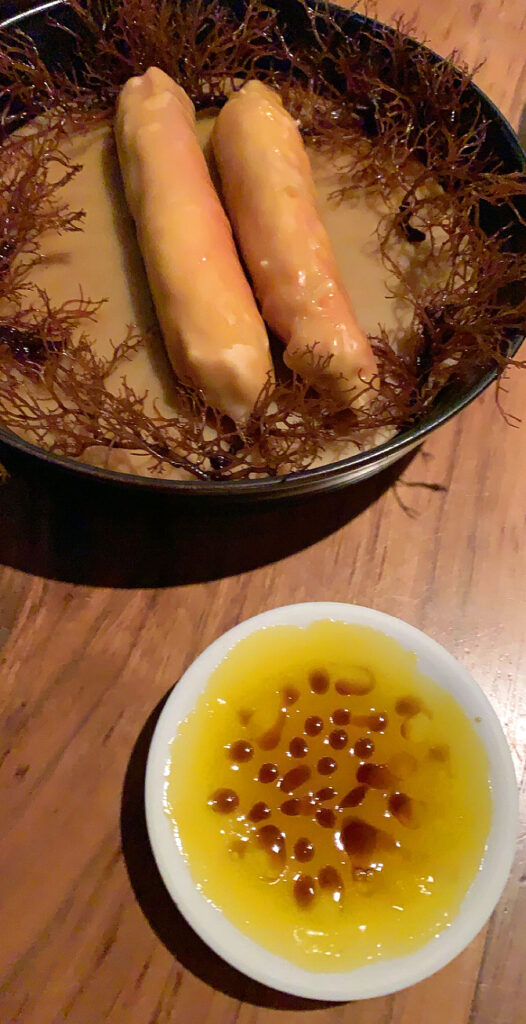
“King crab in beeswax” is such a stunning dish due to the way it embraces and enhances the classic crab-eating experience. The beeswax coating, while it sadly does not impart any noticeable honeyed flavor, faithfully embodies the feel of a real shell. Guests can indulge in the nostalgia of cracking into the crab with absolutely no fuss, and they are rewarded with the cleanest, biggest solitary portion of the crustacean—completely ready to eat—they have likely ever seen.
Rather than simply preparing the ingredient, Smyth preserves and refines the entire experience. One shell, yielding one perfect leg of steamed crab, dipped into the most flavorful crab butter imaginable, condenses (and, perhaps, surpasses) the thrill of tucking into pounds of the stuff. The end result demonstrates how Shields is able to embrace novel techniques while never denying an ingredient’s heritage. In fact, he is one of the rare fine dining chefs who consciously channels such high technical expertise towards elegant, sometimes irreverent reimagining of classic forms. He thinks not only in terms of two-dimensional flavor or texture, but the three-dimensional hospitality experience—with all its physicality—his restaurant so expertly offers.
Is it any surprise that this king crab preparation formed a new lynchpin on the restaurant’s menu? The beeswax bite featured on Smyth’s menus but a few times before, ultimately, two other crab dishes were developed to go alongside it. The first—“king crab & almonds”—forms the beginning of the sequence and references those same “lactic” sauces Shields uses to dress seafood elsewhere. The crab arrives thinly shredded, studded with slivers of almond, and lightly dressed in a froth formed with almond milk. While this particular portion might be small, the twofold use of the nut (which, in truth, is actually a seed) works to reveal a lighter side of the crustacean.
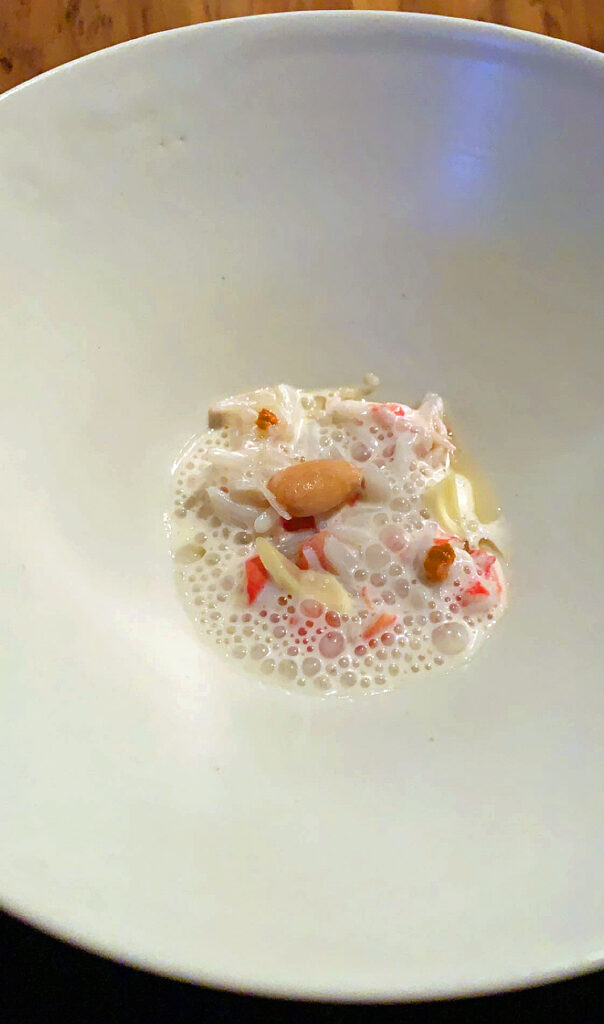
The slivers of almond, which you believe to be blanched, impart light notes of nuttiness and sweetness alongside a tinge of tart, green flavor. Texturally, their typical crunch is a bit subdued, preventing any jarring clash with the soft shreds of crab. The sauce made from almond milk, on the other hand, coats and thickens the crustacean. It lends the dish some of the mouthfeel of a crab salad, bringing additional sweet and tangy notes to the party in a way that rounds out the almond slivers. Yes, in some sense, “king crab & almonds” scratches your itch for crab dressed in mayonnaise. The dish’s delicate blend of sweet and nutty notes is, of course, a bit more complex than a New England crab roll, but its refreshing sour finish serves the same purpose: to make you reach for that glass of Ramonet (the restaurant’s typical pairing) and ready your palate for richer expressions to come.
The third and final dish in the king crab sequence—following “almond” and “beeswax”—must, thus, be the most decadent. Shields, of course, does not disappoint. “King crab & marmite,” as this last member of the triumvirate is called, does indeed make use of the world’s “favorite” vegan food spread. (Marmite, of course, is a salty, umami-rich paste formed from yeast extract that is a byproduct of beer brewing. It was popularized in England while Vegemite, an equivalent product, was developed in Australia to cope with Marmite shortages following WWI).
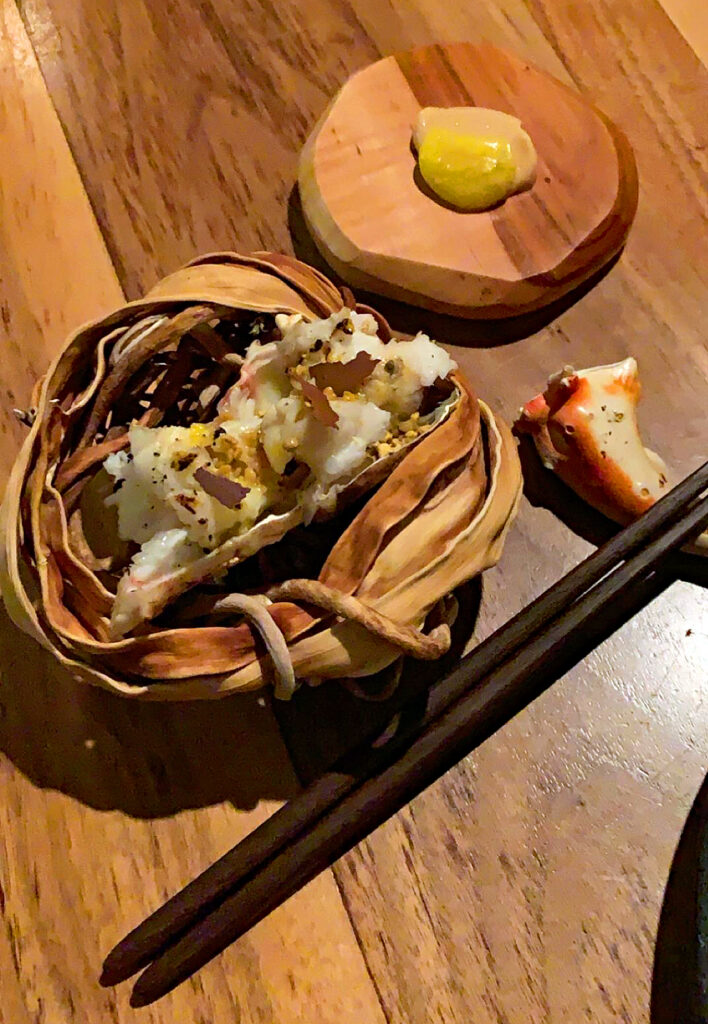
Guests, having been served that delectable morsel of crab leg, are now greeted by the claw of the crab served on the half shell. The discarded portion of the shell shrewdly forms a holder for the chopsticks one uses to grab onto the nuggets of flesh, which have been divided into a few chunks and dressed with furikake (a Japanese seasoning made from toasted sesame seeds and seaweed). Alongside the claw is presented a small dish containing a dollop of Marmite enveloped over a slightly larger dollop of so-called “crab fudge butter.” The exact identity of this latter substance is hard to discern. However, whereas the butter made from crab tomalley (served with the leg) offered notes of both butter and crab, the “crab fudge butter” is much more like the concentrated essence of the tomalley. In that respect, it forms a perfect partner with the Marmite: both substances are as savory as you can imagine, and they close the king crab sequence with a supercharged flavor replete with notes of brown butter and concentrated crab fat.
Thus ends Smyth’s king crab in three acts: a play on crab salad, a pristine piece of crab leg, and an indulgently dressed crab claw. Relative to the shima-aji, the crustacean offers less opportunity to butcher, cure, and cook different parts of its anatomy in distinct ways. There are no coveted fish cheeks or ribs to draw on for a novel preparation, but Shields, nonetheless, shows that he knows his way around shellfish. Each piece of crab displays its distinct texture, and each is paired with diverse accompanying ingredients that express the subtle shades of its flavor. The chef’s processing of the tomalley into butter and fudge, in particular, impresses you with its refinement of the crab’s very essence into condiments for the dishes.
The third and final sequence you will feature in this article—before moving onward into the rest of Smyth’s menu—is somewhat unique. Rather than worshipping a singular piece of seafood across a flurry of preparations, this last sequence focuses on produce. And it boldly features that produce at four distinct points of meal, appearing and reappearing as an interlude throughout the raw seafood, cooked seafood, and meat sections of the menu. For a restaurant that boasts unparalleled ingredient sourcing, such a sequence presents a celebration of that very ethos. Shima-aji or king crab might fit best at the start of the meal, but produce—wielded with the same care—can adapt to and complement any (and every) part of the menu.
The vegetable in question—served in this manner during June of 2019—is asparagus. And the sequence of four dishes incorporating the stalky crop begins with the very start of the meal. Guests are greeted by a small pot that has been placed on the table. It overflows with a crown of grasses from which yellow, orange, and purple flowers peek their petals. Jutting out from the top, like the antennae on the Sears Tower, are two whole pieces of raw asparagus. Guests are instructed to retrieve them from the grassy knoll and dunk them in an accompanying ramekin of “oyster dip.” That dip—which, in this case, directly precedes one of the aforementioned preparations of raw oyster (with radish and strawberry)—is gooey like egg yolk, possessing a hint of the bivalve’s metallic, saline, and buttery notes. But the asparagus is unquestionably the star: perfectly green, both tender and crunchy in turn, and striking in its mildly grassy, mildly bitter flavor.
The effect of the presentation does not necessarily amount to advocacy for the eating of raw asparagus. Rather, its juxtaposition to the oyster highlights how both are pristine products deserving of some recognition in their naked form. That is to say, while raw oysters have long been fashionable, raw vegetables are looked at as “incomplete.” While the former has commanded the respect of gourmands for centuries, the latter is viewed as lacking the same latent flavor upon which it may stand on its own without manipulation.
Shields turns this dynamic on its head, processing the “perfect as-is” oyster into a dip while leaving the asparagus alone. This leveling influence strikes directly to the core of the restaurant’s ethos: vegetables are not afterthoughts appended to seafood and animal proteins but command respect in their own right. A dish need not take fish or fowl as a starting point, transforming produce into worthy accompaniments that work to accent some other ingredient’s flavor or texture. Instead, a stalk of raw asparagus—seen through the right eyes, the eyes of a Barber or Passard—may be the star. It need only be presented beautifully, confidently and form a base upon which other elements (yes, even those prized bivalves) endeavor to express its natural character. This dish is Smyth in a nutshell (the shell of a black walnut, perhaps?), asserting the restaurant’s identity while rolling naturally into the array of seafood that starts the menu.
A couple of courses later—after the oyster dish proper and the spot prawn have had their effect—the asparagus arrives again at the table boasting a whole new look. Guests are once more given a whole stalk to contend with, yet, instead of the green variety, it is white. This variant, harvested before the crop pokes out of the soil (absorbing sunlight and developing chlorophyll), maintains a deeper sweetness and more tender texture than its counterpart. Here, the stalk has been barbecued until the color is more of an off white or pale brown. It comes coated in orange and yellow petals from, you think, the very same flowers seen in the first presentation!
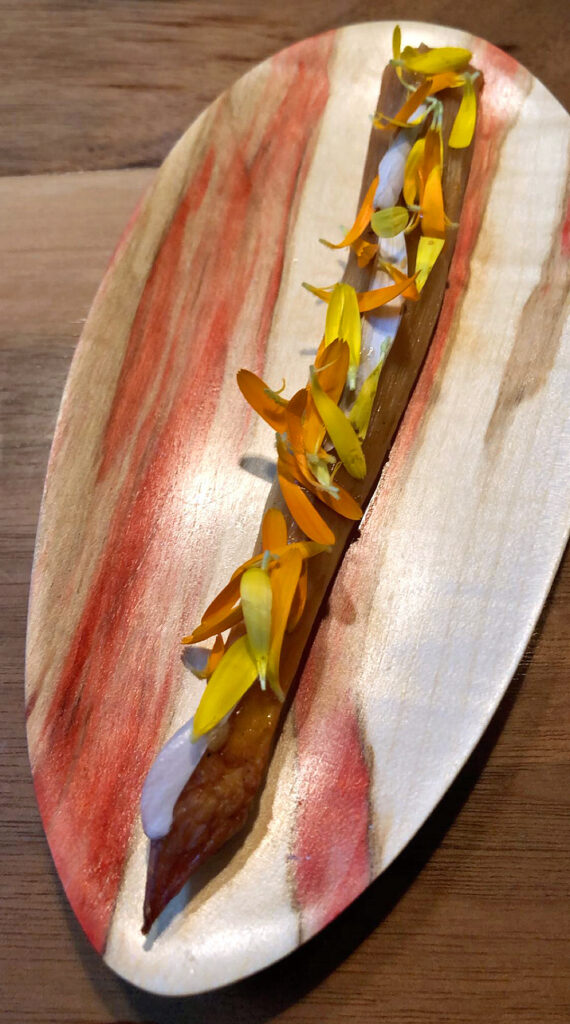
Relative to the raw green asparagus, the cooked white variety really does possess a resounding sweetness with fewer of those grassy, bitter notes. And yet, the garnish of flowers ensures a tinge of that flavor remains. The preparation, overall, offers a rather intelligent variation on the opening theme. It introduces a different form of the ingredient, prepared in a different manner, but presented in the same matter-of-fact style. Thus, it lends itself to a like-for-like comparison between the raw/green and cooked/white poles being presented. The visual trope of the flowers, as well as the whole stalk, work to encourage a careful study of the asparagus’s two forms. In this manner, it is treated with the curiosity and respect typically reserved for different cuts of fish or meat, and Smyth succeeds in championing The Farm’s bounty.
The third of four asparagus dishes in the sequence appears some five courses later—after guests have enjoyed a separate sequence of three shima-aji dishes (along with crab and sweet pea preparations). The vegetable, again, appears dressed in white. But, rather than a whole stalk, it is of the baby white asparagus variety—braised and served in thin strands alongside slices of dried scallop and a glaze of black truffle paste. The sauce it sits in—as pleasantly frothy as ever—is not lactic, but more of a brown butter vinaigrette. It works to draw out the sweetness both of the asparagus and the scallop while, at the same time, cutting the richer, earthier notes imparted by the black truffle’s presence. Texturally, the baby asparagus—braised in this manner—offers only the slightest resistance. It is enjoyably hearty to chew through alongside the softer texture imparted by the scallop.
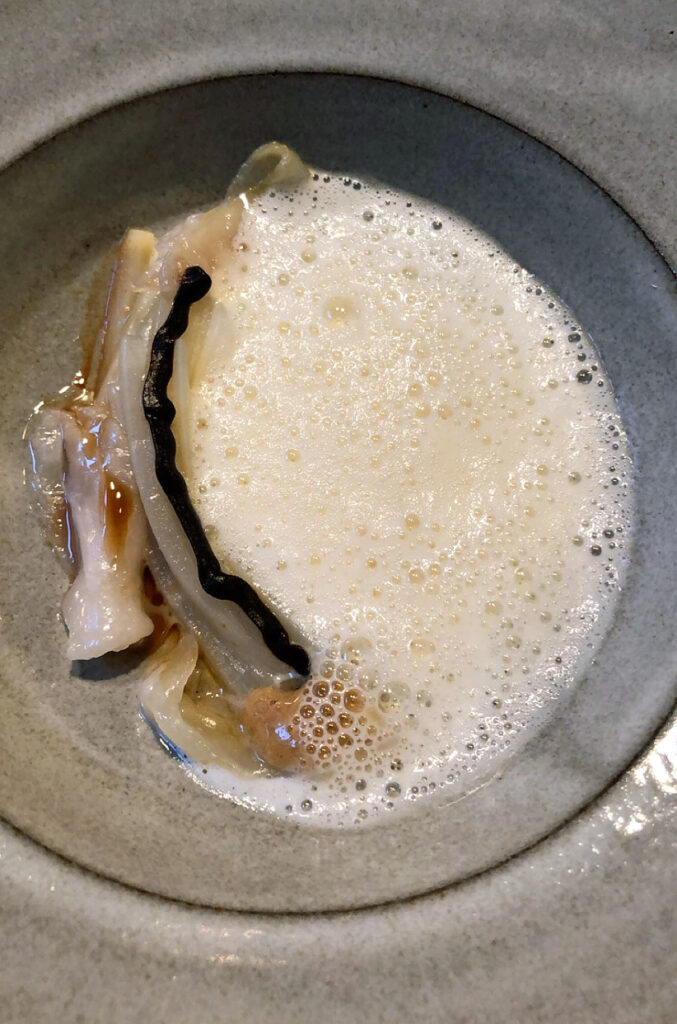
Relative to the raw and barbecued asparagus presentations, the baby asparagus is a bit more composed. Its tiny stalks are incorporated into a dish alongside luxurious items like scallop and truffle, but—nonetheless—the vegetable maintains top billing: “white asparagus with black truffle & dried scallop” is how it reads on the menu. The produce might not be as “in your face” as the two solitary stalks were in their respective preparations. Nonetheless, the baby asparagus forms the crux of the third dish’s flavor composition: the sweetness of the dried scallop melds with the earthiness of the black truffle by way of its unique capacity as a bridge between the two. In that sense, the vegetable asserts itself as the essential component of the dish, a conduit capable of marrying two luxury ingredients that might otherwise clash.
The fourth and final dish in this sequence is served three courses later—sandwiched between beef tendon salad and lacquered squab breast preparations somewhere around the three-quarter mark of the meal. Needless to say, the asparagus is now standing amongst animal protein, and it must endeavor to spread its wings alongside flavors that normally relegate it to the role of “side dish.” But have no fear, Shields is up to the task.
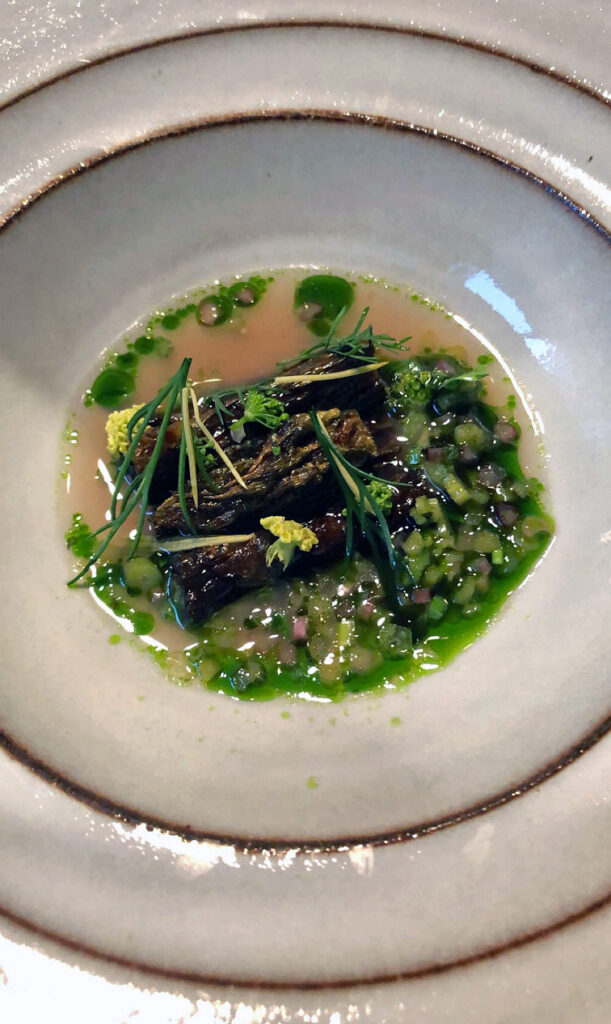
He takes only the tips of green asparagus and roasts them “low and slow” in beef fat. They arrive at the table in a shallow bowl containing the residual fat, thin slices of baby asparagus stalk, microgreens, and drips of an herbal dressing dotted throughout. The asparagus stalks themselves are cooked to a dark, glistening green that is only a few shades removed from looking like a bite of beef jerky. If the previous preparations of the vegetable were all about delicacy, this dish is where the full weight of its flavor is released. Softened for so long in the beef fat, the asparagus tips’ ultimate texture is something like a morel mushroom: the ridged outer texture yields to a gushing interior that coats the palate with its retained juices. The flavor retains the richness of the fat but bolsters it by way of a slightly-sweet, slightly-bitter profoundly umami and savory-vegetal essence.
Which is to say, the asparagus plays the role of “meat” quite well, with those tiny slices of baby asparagus serving to contrast the tender tips with a bit more crunch and overt greenness (the same role asparagus would typically play in a “proper” plate of steak). It’s a rich, lip-smacking dish that goes to show the ingredient’s range from altogether raw to deliciously decadent. And it is served alongside an aged beef fat brioche doughnut meant to be dunked in the remaining beef fat or spread with an accompanying marmite butter. The doughnut—which you will talk more about later—is reliably served with Smyth’s main meat course. Here, placing it alongside the asparagus only underlines the vegetable’s ability to carry that carnivorous mantle.
With the shima-aji, king crab, and asparagus sequences being settled, you can now return to regularly-scheduled programming. Following, in most cases, the shima-aji ribs, Smyth’s menu embraces one or several vegetable preparations in the lead-up to more robust dishes of cooked seafood.
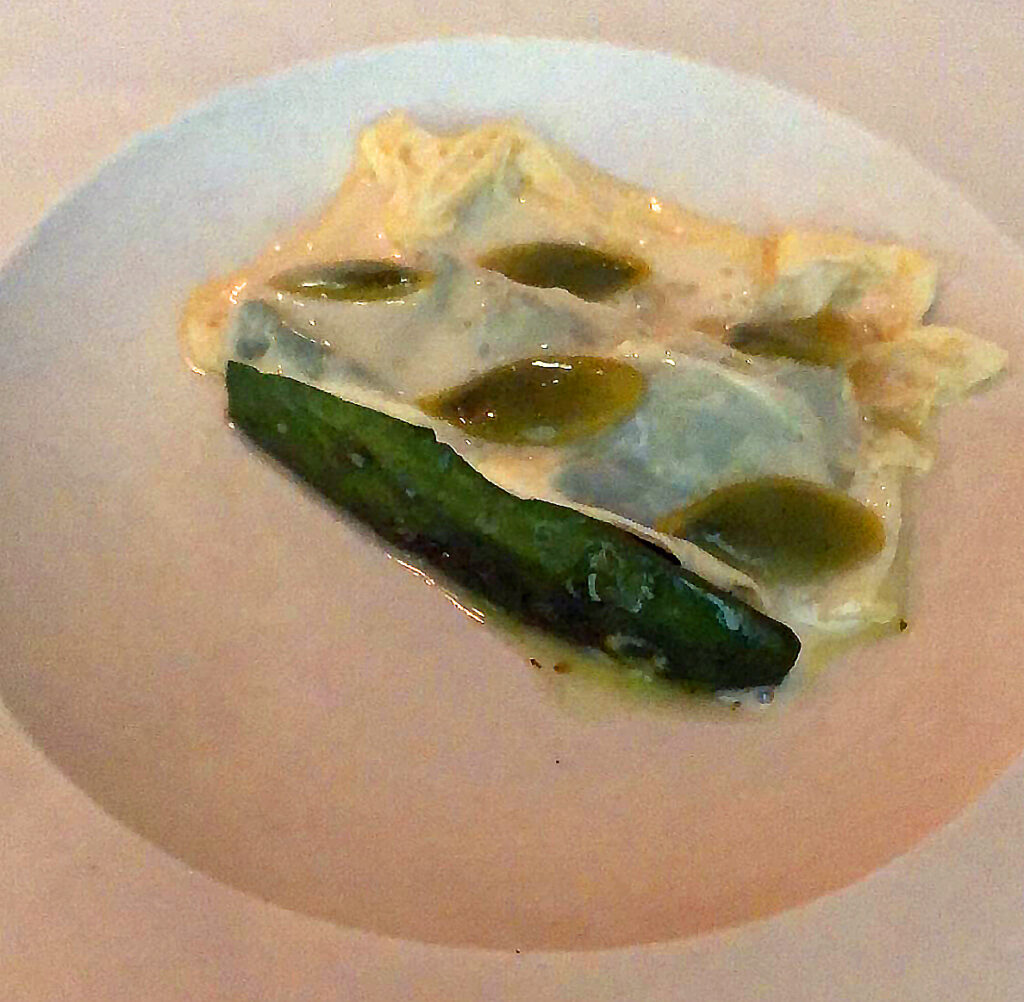
Barbecued cucumber, served in one of two styles, has played the part before. The first version of the dish made use of long slivers of the vegetable. They are cooked to a dark green—with faint tones of black—and served in a bowl with nasturtiums that have also been grilled. The whole thing is topped with a film of yuba, the skin that forms when boiling soy milk to make tofu, and a few gem-like green almonds. The second version of this same dish substitutes the whole slivers of cucumber for a stack of thin slices tucked against the side of the bowl. The grilled nasturtiums, green almonds, and yuba are still present, yet the dish also receives a coating of one of those lactic sauces (perhaps made from soy or almond milk) this time.
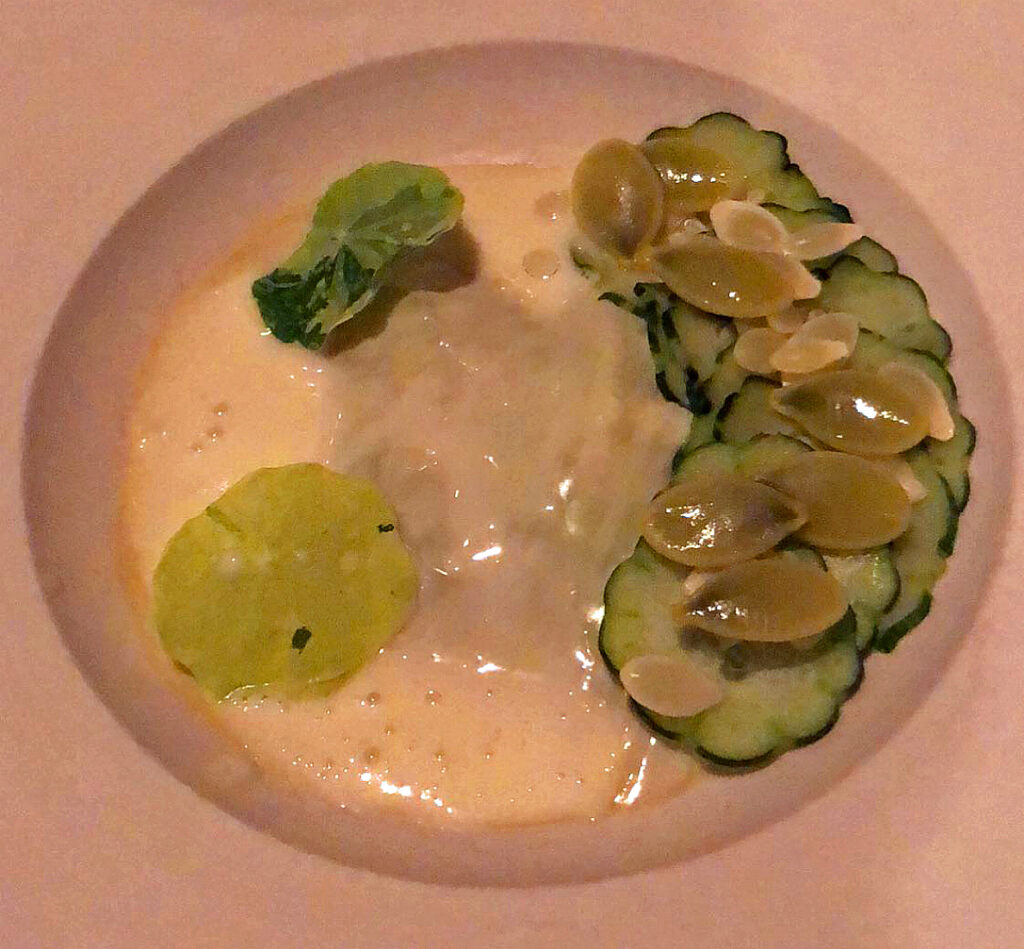
While the first form of the dish—defined by the crunch of larger bites of cucumber—did more to celebrate that vegetable, the second presentation strikes you as more complete. This is due to the way in which the thinner slices of cucumber work alongside the plate’s other elements. The yuba, defined by a mildly nutty taste and slightly chewy texture, functions roughly the same way in both versions. It coats the cucumber and tinges its charred (but still, principally, watery) flavor with an added savoriness. Yet, whereas the slivered cucumber wears the yuba as a sheath—its chewiness contrasting a heartier crunch—the sliced cucumber forms a double gossamer layer with the tofu skin that is altogether smooth. This matching of complementary textures enables the mild flavors at hand to better shine. The green almonds provide, in addition to an extra dose of nuttiness, the same crunch that the slivered cucumber possessed. Meanwhile, the grilled nasturtiums—rather thinly-textured themselves—are able to better match the sliced vegetables and offer a slight floral note. One of Shields’s lactic sauces, of course, can be relied on to make any dish better. But the second version, more than anything, regales you with the blend of charred, nutty, and floral flavors in such a self-contained, slight-textured package.
Another vegetable preparation that revels in intricate textures features sweet peas from The Farm. They possess a paler shade of green than their conventionally cultivated brethren, a color that is preserved by gently cooking the vegetable in dashi (a stock made from kelp and fermented fish shavings that forms the base of miso soup). This broth undergirds the peas’ natural sweetness—a sweetness of a sort that only comes freshly-picked—with a light touch of umami. This not only imparts a sense of richness—subduing any green notes—but plays right into the peas’ exceptional mouthfeel. The orbs dance across the palate and burst like oversized pearls of roe, the umami ensuring that each individual bite resonates with untold succulence.
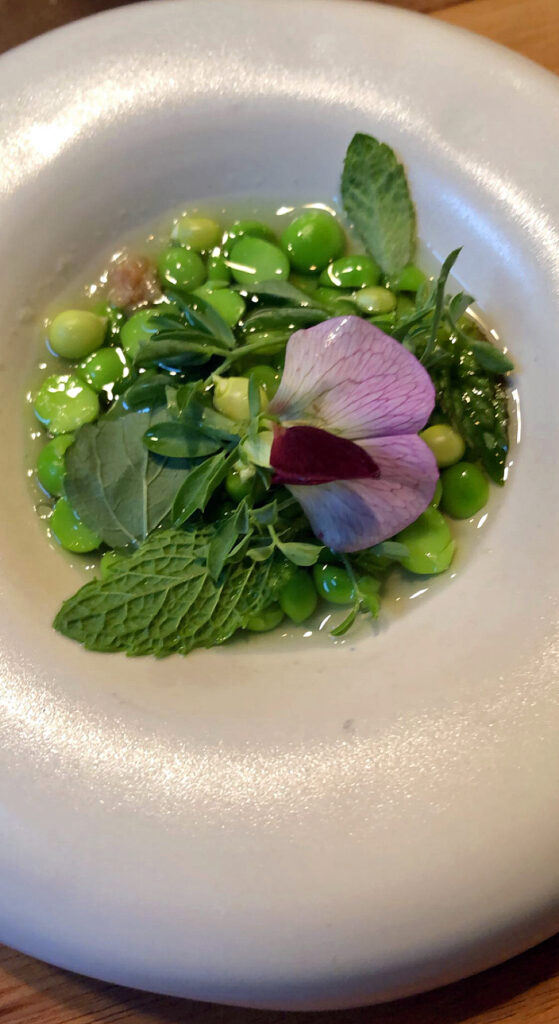
Joining the peas in their dashi are small chunks of blood sausage and woodruff—a flowering plant also known as “master of the woods” in Germany, where it is widely used to flavor sugar powders. The blood sausage functions, like the broth, as an umami booster. However, while the dashi is understated, the chunks of sausage invigorate certain bites with a firmer sense of salt, pork, and that signature metallic note of iron from the blood. Nonetheless, this is not a “blood sausage” dish—it is given third billing of the four ingredients—and Shields’s restraint in wielding it ensures it never stands in the way of the produce. The woodruff, on the other hand, lends the peas an extra layer of sweetness, as well as earthiness, that guests will be hard-pressed to place. The herb enlivens the vegetable’s essence through addition, whereas the dashi and blood sausage do so through contrast. The end result amounts to an absolutely reverent preparation of peas unlike any usage you have seen before.
Having already served such a wide variety of seafood throughout the early stages of the menu, Shields could be forgiven for foregoing any formal preparation of cooked fish. To wit, once a guest has witnessed Smyth’s shima-aji take on two, three, or even four exceptional forms before their eyes, what more—within the confines of that same meal—can really be done? “Plenty,” Shields’s menu seems to say. The fish dishes that appear around the midpoint of the menu—separating lighter preparations of vegetables and shellfish from their heavier counterparts—stand as superlative expressions of the chef’s technical prowess. In that sense, they are decidedly classic—eschewing the novel elements used elsewhere—and, altogether, direct in their pleasure.
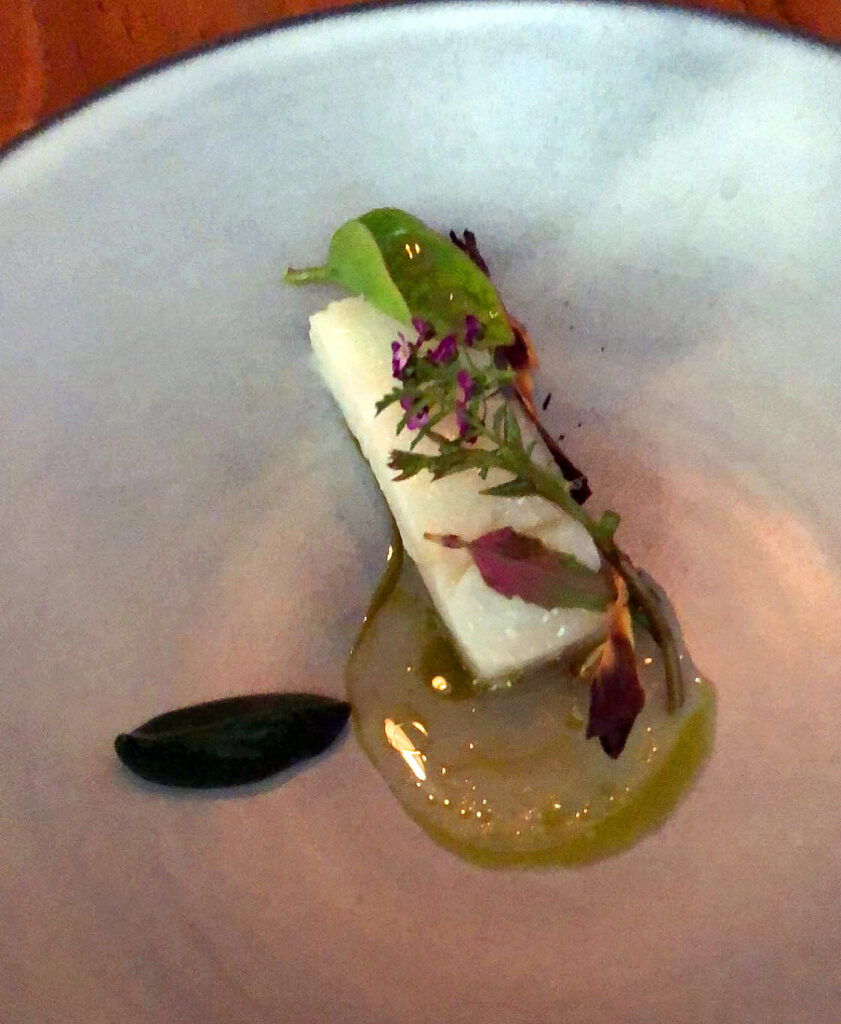
One halibut dish, in particular, became something of a signature for the restaurant during 2018 and 2019. Like the black walnut, “sea lettuce cookie,” and shima-aji ribs, it was nearly never missing from the menu—and the core of its composition, which saw little to no changes, had achieved something close to “perfection.” The dish is titled “lightly steamed halibut with fermented green tea,” and it was served in exactly this form no less than three times.
The fish, situated in the center of a plate, arrives at the table looking like an unidentifiable white slab. Really. So expertly is the fillet portioned, so carefully is it cooked (without the development of any color), that it seems more like a piece of tofu at first glance. This blank canvas comes bedecked with a few microgreens: stems, leaves, and tiny flowers that impart trace flavors and textures. The exact assortment—as with the “sea lettuce cookie”—is always a bit different, but they work to the same effect.
Under this garnish and the flesh of the halibut sits something of a broth—something like brown butter—strewn with dozens of microscopic green bubbles. While this sauce does not function as the principal seasoning for the fish, it does much to enliven the plate with both color and form. The brown tone references a succulence and sweetness that the halibut’s milky white flesh—lacking any caramelization—otherwise subverts. Meanwhile, the green globules (an herbal tincture, perhaps) accentuate the plate’s leaves and flowers while contrasting with the deeper, darker tone of what Shields terms a “green tea condiment.” That condiment, of course, contains the fermented green tea element that, otherwise, defines the pristine preparation of fish. It stands to the side of the halibut, partially submerged in the broth, and ready to be spread across individual morsels cut from the fillet.
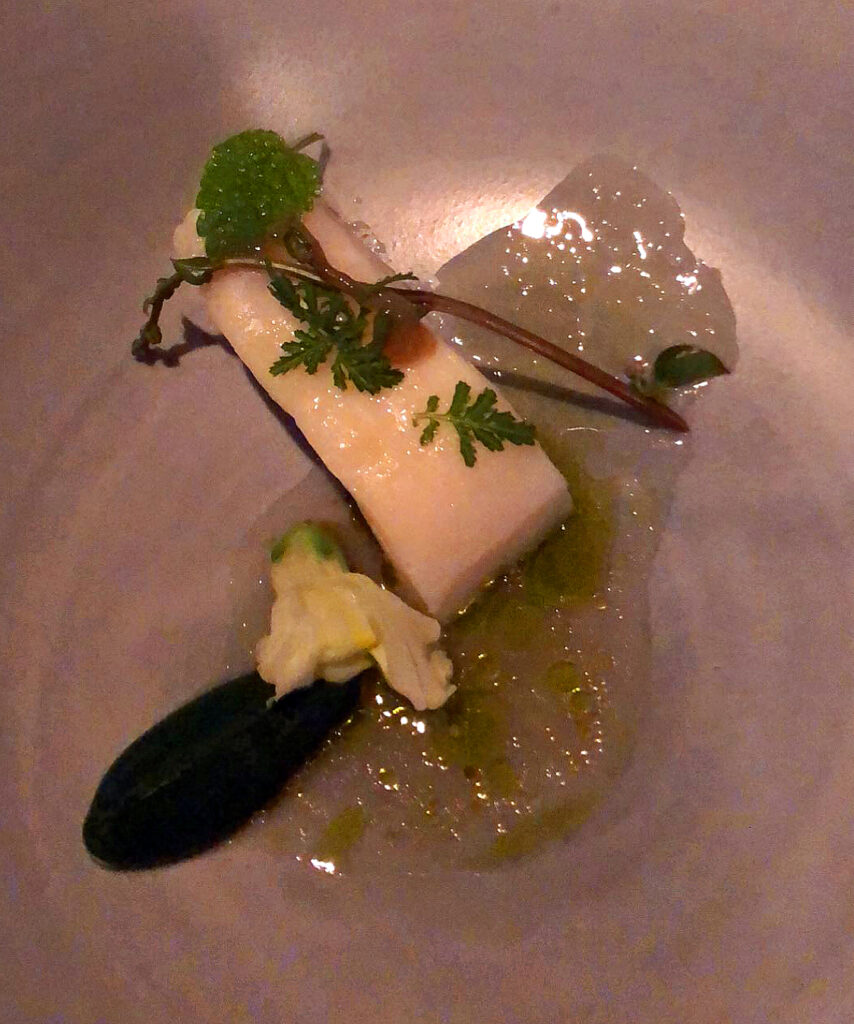
When consuming the dish, you are first struck by the consistency of the halibut. Its flesh, in line with that striking color, offers absolutely no resistance when pressed with the end of a fork. Still, the fillet breaks off into a clean, self-contained chunk. Such is the its gelatinous texture—true unctuousness of the sort that adjective oh-so-rarely describes. The fish holds its form as you drag it through the sauce, coat it with a thick dollop of the green tea condiment, and maneuver a couple of the microgreens onto it in preparation for your first bite. When that comes, any structure the halibut possesses is gone in a flash. The flesh melts on contact, separating into so many slick layers as the condiment—whipped to a light-yet-mouth-filling consistency—pervades the palate’s every nook and cranny.
Yes, the slight crunch provided by the microgreens does just enough to offset the ephemeral nature of the steamed fish. But the dish is ultimately a celebration of the halibut’s essence: a mild, slightly-sweet flavor made transcendent via refinement of texture and accompanying notes of nut, sweet, bitter, and butter from the pure-yet-potent green tea condiment. There are no gimmicks here, only a meditation on how two ingredients may be nurtured so as to reach a superlative form. And, paired with the juicy, vegetal notes of Weingut Knoll’s “Vinothekfüllung” Grüner Veltliner bottling (as the dish was on the first occasion you sampled it), you are looking at one of Chicago’s best fish dishes served in recent memory.
But Shields, as readers may have already sensed, is certainly not shy about tinkering with perfection. Smyth’s halibut soon found a new way of expressing itself, borrowing some of the same structure as the “fermented green tea” version but embracing an altogether different flavor composition.
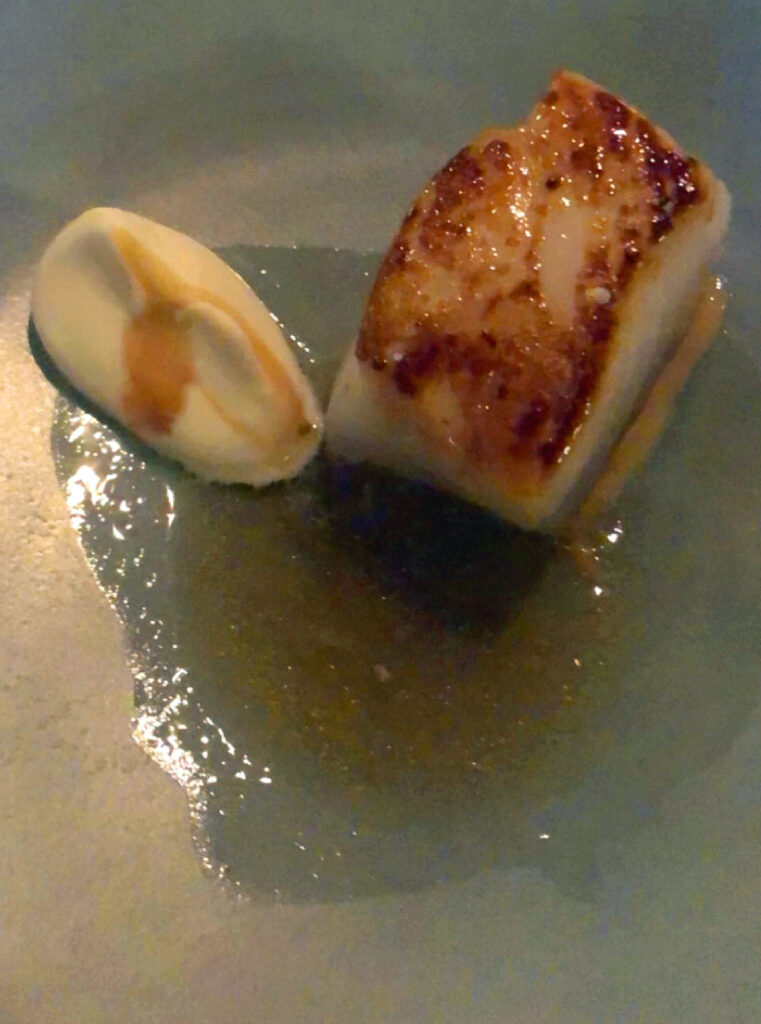
In this second rendition, the fish is no longer gently steamed but, instead, caramelized. What was once an amorphous slab of flesh now arrives looking more familiar: the fillet boasts an attractive top layer of brown-and-black crust that accentuates the flaky chunks contained below. It sits atop a custard of “toasted crab” that is easy to miss—the crustacean being processed to such a degree that it forms more of a sauce. The halibut is also paired with a quenelle of “double cream” that offers much of the same, thickened mouthfeel as the “green tea condiment.” However, whereas the tea lent the fish a nutty, roasted quality, the cream is defined solely by the richness and sweetness of milk fat. The dish is then finished with a glaze of walnut sap.
Relative to its steamed preparation, the caramelized halibut aims at—and achieves—a more direct sense of pleasure. However, this is not to say it is necessarily superior. The crust, of course, allows for a more direct textural contrast between the outer and inner layers of the fish. It also imparts an initial burst of the sweet sap glaze—balanced by a slight char—that lends the milder inner flesh some added complexity. The double cream quenelle and toasted crab custard, in turn, amplify the fish’s unctuous texture and sense of richness respectively. This drives the flavor sensation more firmly towards one of nuttiness, sweetness, and (via both the milk and crab) fat.
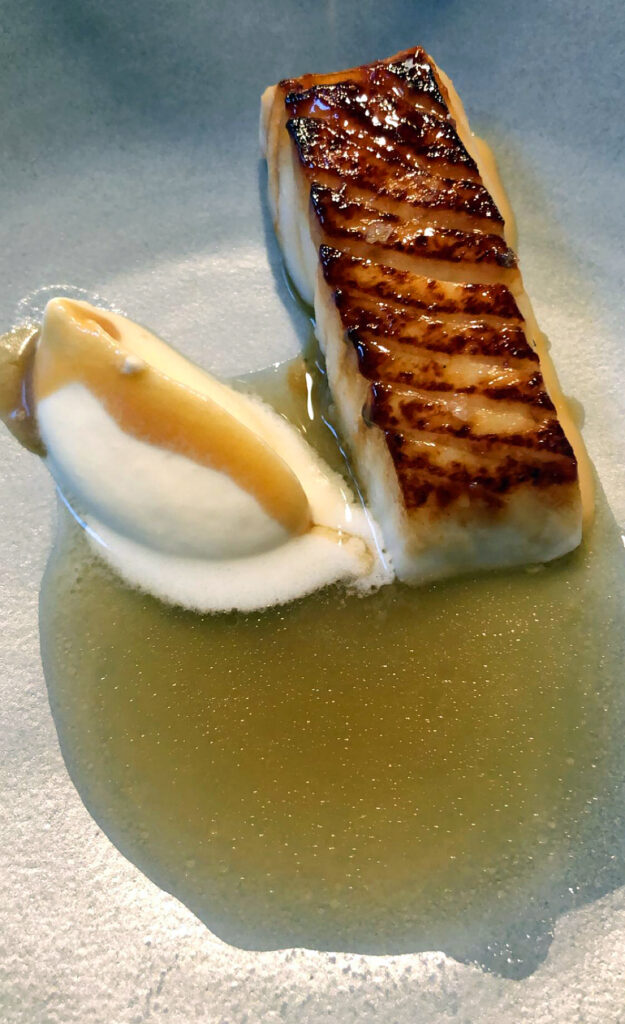
The steamed halibut, by comparison, is characterized by the interplay of the microgreen garnishes and “green tea condiment.” The fish possesses no caramelization, no further texture than its resplendent softness. Rather than being bolstered by a glaze of walnut sap, its gentle cooking process only works to reveal the fillet’s latent flavor. That mildness, and the extraordinary nature of the steamed halibut’s texture, enable the accompanying elements on the plate to really shine. The microgreen and green tea components, in that sense, define the flavor of the dish and do so intricately. The double cream and toasted crab, in contrast, complement a sense of sweetness inherent to the caramelization. They exaggerate, rather than complicate, the base notes. Thus, while the steamed preparation forms a perfect foil for an aromatic wine like Grüner, the latter halibut dish begs for a decadent pour of Chardonnay. Both dishes surely impress, yet the former offers a more singular expression of the fish.
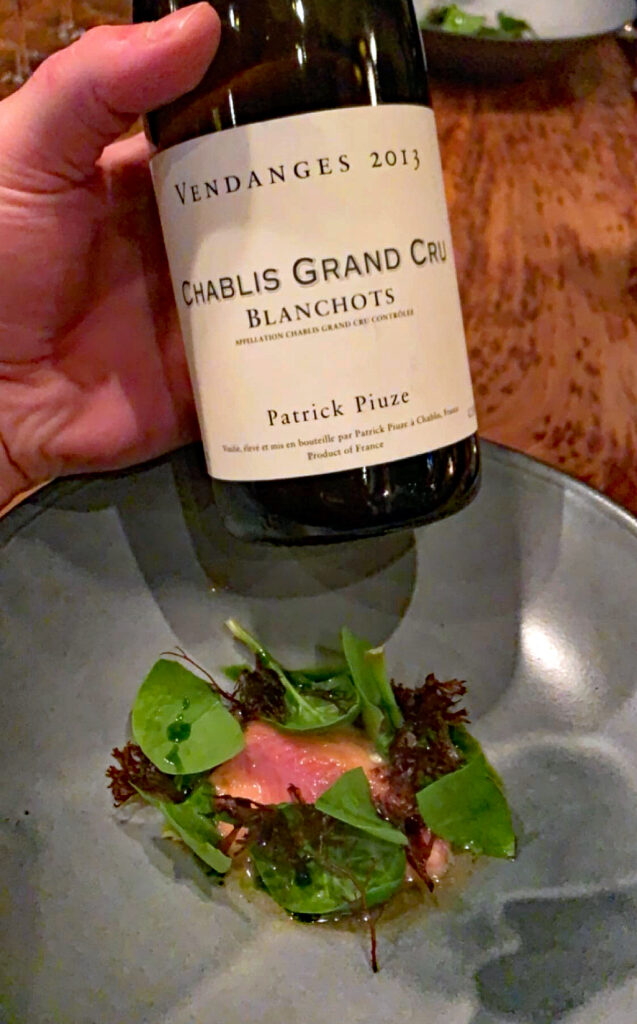
Other than halibut, Smyth’s later menus have made wonderful use of rainbow trout in a set of distinct preparations. The first sees the fish crusted with miso and served with a combination of kelp and autumn greens. Paired with a glass of grand cru Chablis, the dish is decidedly classic. The trout’s soft, nutty flesh is bolstered by the miso’s added umami and contrasted by the bittersweet, vegetal notes from both sets of greens. (Though the kelp, you think, also adds additional umami and an intriguing oceanic quality). The stage, in this manner, is set for a wine rich in minerality and acidity to enliven a comparably orthodox pairing of fish, miso, and veg.
A second variant of the rainbow trout dish, however, treats the ingredient more boldly. The fish arrives at the table with its skin—even to a greater degree than the “caramelized halibut”—charred to a crispy, crackling finish. In fact, the skin is so rigid that it sits altogether apart from the trout’s flesh—a sort of fish “chip” garnish that guests fragment with their forks. Otherwise, there is no miso-crusting or other embellishment applied to the trout; it possesses much of the same pristine nature as the “steam halibut” did. Of course, such a preparation screams for a captivating sauce, and Shields certainly has one up his sleeve.
Cloudberry forms the essential component. The fruit is cultivated from flowering plants (in the rose family) throughout the northeast, which yield juicy, tart, and floral berries with an unmistakable golden color. Emma Bengtsson, the pastry chef turned executive chef of New York’s two Michelin star Aquavit claims “you can’t get a better berry. They have a freshness and acidity, but still have a natural sweetness to balance that.”
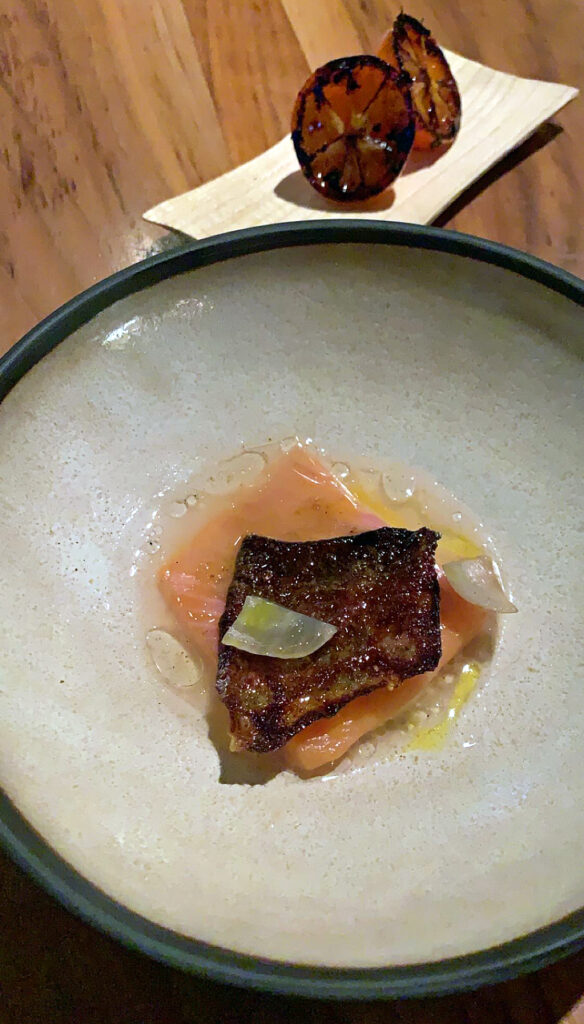
Shields lines the bottom of his trout dish with the juices—and some golden slivers—of the cloudberries. To that, he adds slivers of burnt onion, reduced cream (also something of a holdover from the “caramelized halibut”), and hazelnut oil. But wait, there’s more! The dish is finished with a bit of rhubarb root—a sour, bitter powder sometimes used in medicine or liqueur production—and a squeeze of mandarinquat—a cross between a mandarin and a kumquat—which patrons apply themselves.
When eating the dish, you crack through that top layer of crispy fish skin then continue to the bottom of the plate, scooping up a matching portion of the trout’s flesh and, perhaps, one of those burnt onions or cloudberry slivers. The real key, however, is sopping up the liquid at the bottom of the bowl—a brew that, in essence, combines the cream, hazelnut oil, rhubarb root, mandarinquat juice, and cloudberry juice into multifaceted “sauce.” The combination is slightly sweet, a bit nutty, a tad bitter, and resounding with its cornucopia of tangy, tart flavors. These serve not only to contrast the charred notes of the crispy skin, but, principally, to dress the trout’s flesh. In that sense, the sweet and nut components present in the dish merely boost the fish’s savor. It is the cloudberry, mandarinquat, and rhubarb root—fruits and roots guests likely have never tasted before—that define the preparation. And they succeed in enriching the rainbow trout’s flavor without unduly sweetening its delicacy—quite an accomplishment for what must be a novel combination!
Following the fish course arrives but one more indulgence of seafood. The focus, at this later portion of the meal, is on shellfish too fatty, too decadent to appear earlier on the menu. That means, first and foremost, lobster.
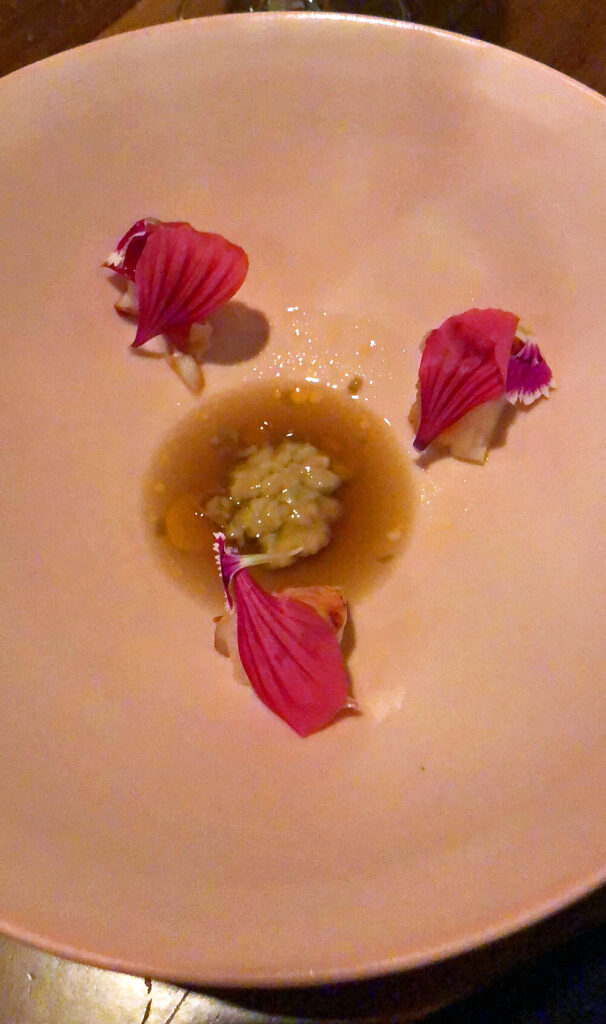
You have witnessed no less than four different lobster preparations across your visits to Smyth. They, in the same mold the restaurant’s previous shellfish dishes, embrace a colorful array of complementary flavors in order to unleash the sweet, succulent notes promised (but so rarely delivered) by high-priced crustaceans. Here, however, contrasting notes like citrus are eschewed in favor of more decadent designs—the goal being to ease customers, at long last, towards the bonafide “beef” section of the meal.
The first of the four dishes combined the lobster with spring onion, pickled roses, lavender, and tomalley—that essence of essences that all but guarantees flavors of stratospheric intensity. The second, more simply, featured “barely-cooked” morsels of the crustacean served under a mound of shaved almonds with a cream-based, jus-enriched sauce. The third preparation—reminiscent of one of Shields’s dishes from Town House—matched lobster with both lobster oil and lobster sabayon (a light custard made from egg yolks, sugar, and wine). It was then topped with dashi chips and “reinforced” by the addition of some king crab. The last of the preparations—and perhaps the most minimalist—dressed the crustacean (again barely-cooked) with kelp vinegar and a lima bean miso.
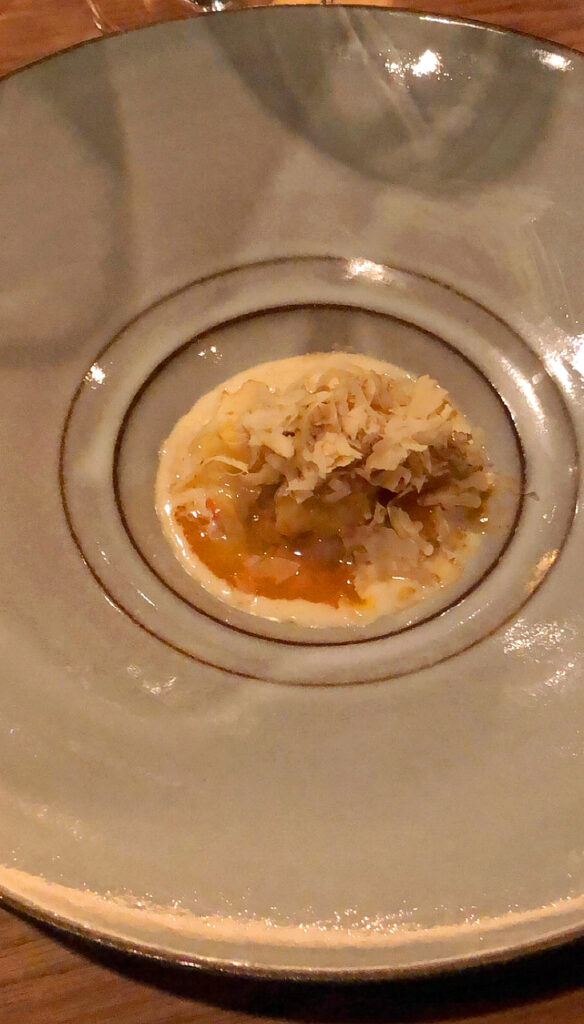
Though each of these dishes is, undoubtedly, distinct, they all are united by a sense of precision that seeks to celebrate the lobster’s quintessential quality. That quality, it must be said, is not “butter.” No, neither in texture nor in flavor should lobster smack of butter. But, unfortunately, it often does so, being one of the most pervasive of all totemic luxury ingredients and, all the more, a bit boring—a bit hard to prepare—to boot. So, while malpractitioners boil and baste away—sure that the rubes in the dining room will be delighted with the former prison food—it is worth considering just how Shields perceives this crustacean relative to all the others he serves.
Smyth’s lobster comes from Maine, and it is never the sort to regale you with its size. For, while gargantuan tails are trotted out at some of Chicago’s steakhouses, a larger lobster yields no better meat than a smaller one. Furthermore, diminutive crustaceans can more easily be shipped and prepared, individually, at their freshest—the real secret to securing the most tender and flavorful flesh.
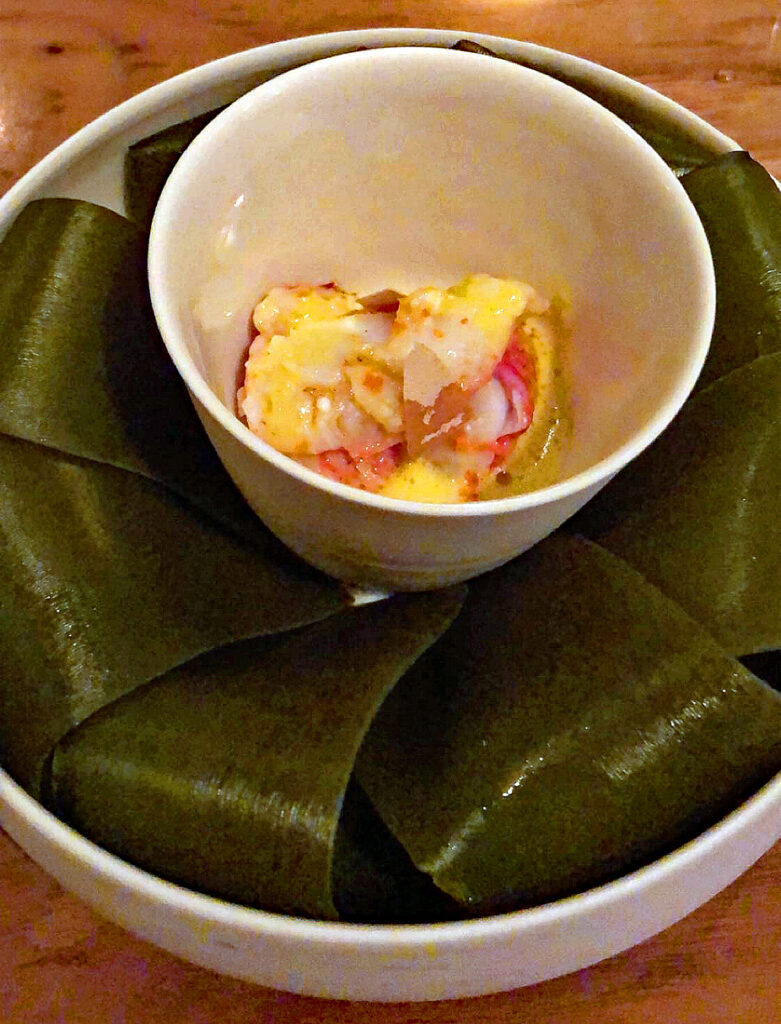
When it comes to cooking the lobster, Shields smartly imparts only a light touch. Too often, even at such rarefied establishments as Per Se, the crustacean’s tail—served halved—has displayed a firm chew. With plenty of butter and a helping hand from some other coveted ingredients, such a miscue can be obfuscated. But one is left wondering, bite after bite, just why any restaurant would charge a $75 supplement for a piece of seafood that does little to surpass a bucket of shrimp, let alone any king crab or langoustine preparation. The presentation of the lobster’s tail—you’ll go ahead and say it—is largely a needless throwback.
Smyth, instead, “barely” cooks their meat and divides it neatly into small chunks (the tip of the claw, a nub of the tail) and shreds. Those who have tasted lobster sashimi will know that the crustacean, prepared in such a fashion, maintains a certain gelatinous quality also sensed when one eats raw scallop or shrimp. Barely-cooked, the lobster retains that mouthfeel on the inside while its outer flesh develops a pleasing plumpness. Thus, one can bite down into a morsel without it bouncing back against one’s teeth. It breaks cleanly and spreads seductively across the palate, offering—without question—lobster’s most superlative, “best of both worlds” mouthfeel. The restaurant’s careful selection of the crustacean’s prime pieces ensures that any and every bite offers unparalleled textural pleasure.
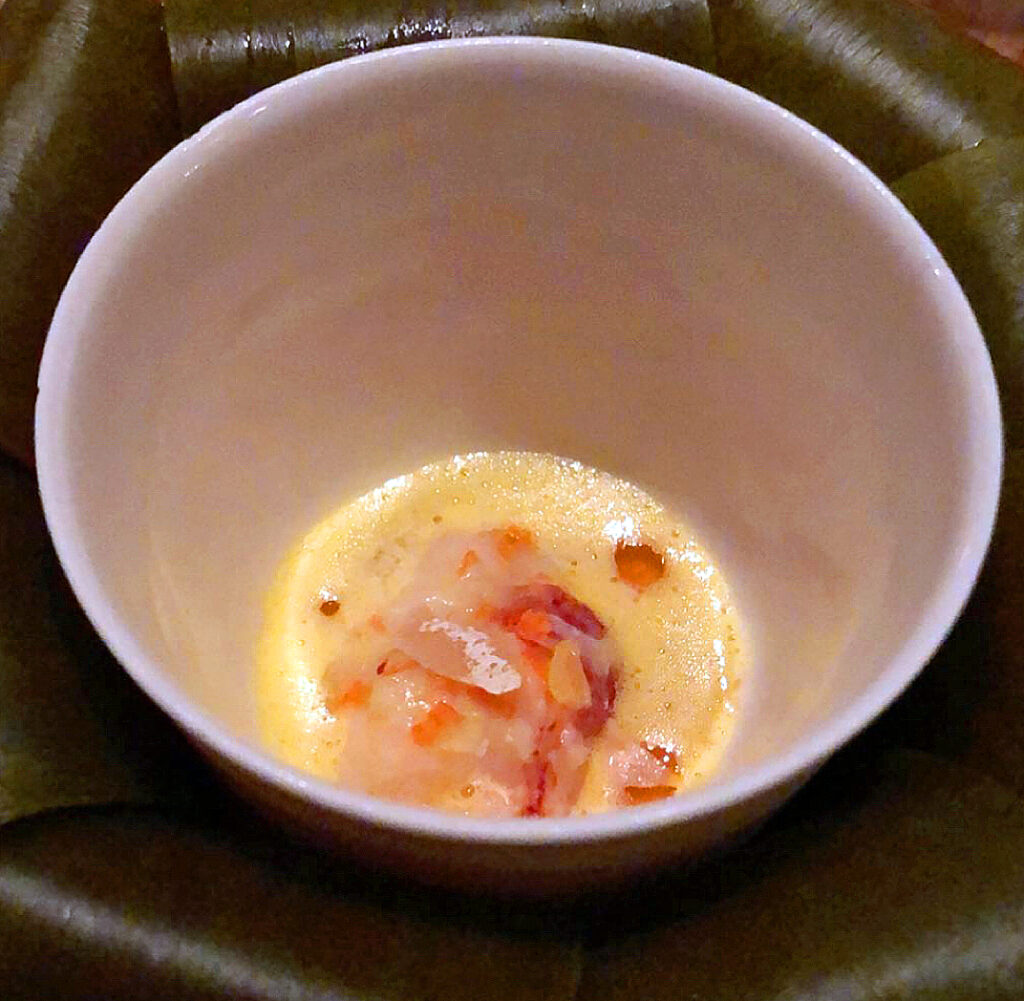
With that settled, the lobster needs only strut its stuff. Spring onion, shaved almonds, dashi chips, and lima bean miso—seen, respectively, across the four preparations—work to bolster the sweet, nutty, and umami notes the crustacean displays at its very best. Of course, elements such as the tomalley, lobster oil, lobster sabayon, and even the addition of king crab buttress the ingredient all the more by imparting a further expression of its essence (or that of a kindred piece of shellfish). Only the pickled roses, the lavender, and the kelp vinegar can be said to bring contrasting flavors to the party. But, in such minor roles, they really only work to gild the lily: accentuating the richness on offer with a sour twang and a tinge of floral or sea-vegetal flavor. Smyth’s lobster dishes, at the end of the day, are rather straightforward in their composition yet demonstrate a rare understanding of the pleasure the crustacean can offer. Moreover, they make some of the prized presentations served at other establishments look positively tortured by comparison.
Perhaps the most exciting piece of seafood that Shields lays his hands on during the course of the menu is unagi. Readers may recall the exposition on eel which accompanied this previous piece of criticism; however, you will provide a brief refresher. Unagi refers to the richer, fattier freshwater eel (often grilled in sweet soy sauce and served near the conclusion of an omakase) while anago denotes the more delicate saltwater conger eel (that is often lightly simmered or fried for tempura). The former’s popularity as a fixture of any sushi meal—irrespective of quality—has led to a predominance of farm-raised unagi in the United States. Moreover, many restaurants are more than happy to use precooked, vacuum-sealed, and frozen product that has been overwhelmed by its glaze of sauce.
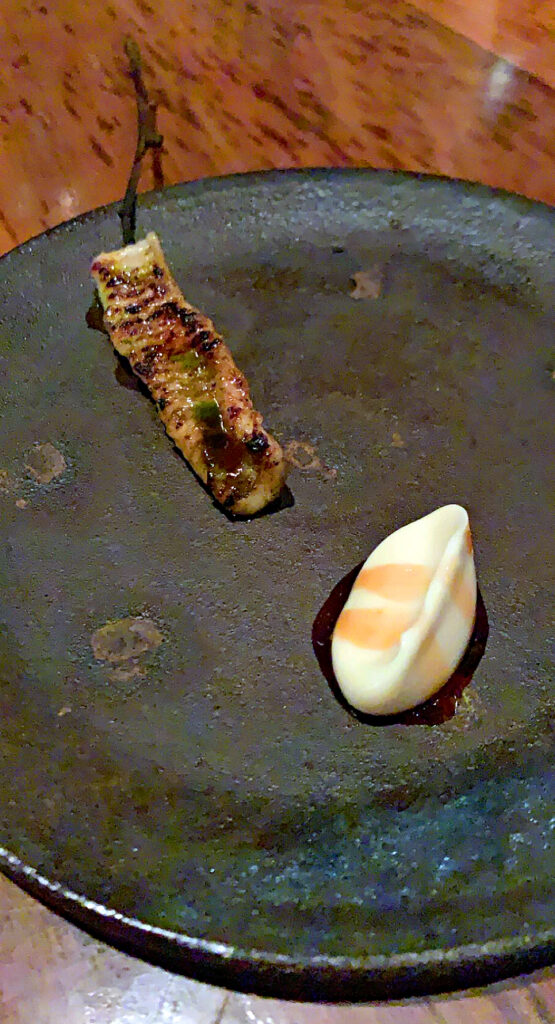
Not so at Smyth. The restaurant sources live glass eels from Maine—the sort that, until recent times, would be exported to Asia and imported again years later after being grown and processed there. These fresh eels—cultivated by American Unagi—are sustainably farmed without the use of hormones or antibiotics. That might seem like a big to-do for such a niche product, one that might even largely be off-putting (at least in theory) to the average American diner. However, the development of domestic eel fisheries—perhaps for the first time ever—empowers the country’s best chefs to utilize the fish in good faith. That is to say, no longer must they serve an imported, derivative product but, instead, can shape for the ingredient an American canon of its own.
But Shields, certainly, can be forgiven for looking to Japan when preparing the fresh eel himself. The first step for any domesticated luxury ingredient being, of course, to show its worth relative to the classic preparations for which it is known. And yet, Shields would not be the chef we know him to be without putting a bit of a stamp on that slimy, slithering fish. This occurs, across two distinct preparations, by way of apple.
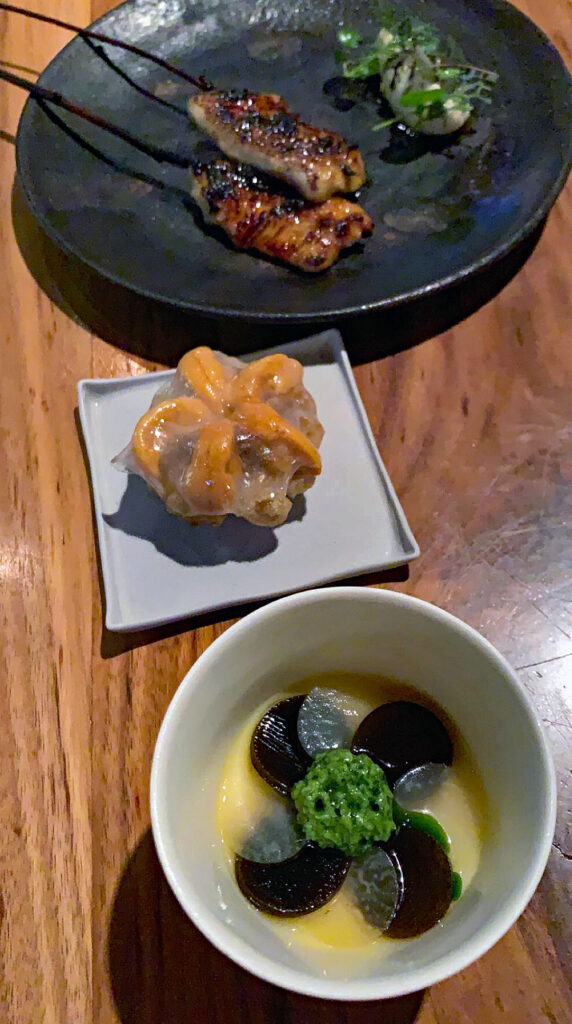
The first version of the restaurant’s eel preparation—titled “unagi, apple & cream”—presents the fish on a skewer. It arrives lightly glazed, nicely charred, and at the ready to be dragged into its accompanying two flavors, which sit one inside the other as a sort of double condiment. The second variant of the dish takes much the same form: skewer paired with condiment. However, the eel is labeled a “barbecued unagi” and paired—as part of a three-dish sequence that includes a chawanmushi, an uni biscuit, and a pour of sake—with a cream made from apple kombucha.
Immediately, in both preparations, you notice that the color of the eel is far lighter than usual. This is not due so much to a difference in the American species, but to the fact that the fish is normally coated in so much sauce as to obscure its natural tone under a sea of brown. Smyth’s eel is an appetizing off white studded with attractive ribbons of char and a gleaming brushstroke of glaze. The “skewer” it appears on seems to be a twig taken from The Farm—a nice means of connecting sea to land. Taking a bite—sans sauce—you are immediately struck by the softness of the eel. Yes, the charred outer ridges accentuate a certain flakiness, but that quickly gives way to a pleasing gelatinousness that coats the palate. The fish’s flesh possesses light sweetness that is striking in its purity. The glaze, of course, amplifies that sense but does so to balance the charred exterior as much as anything.
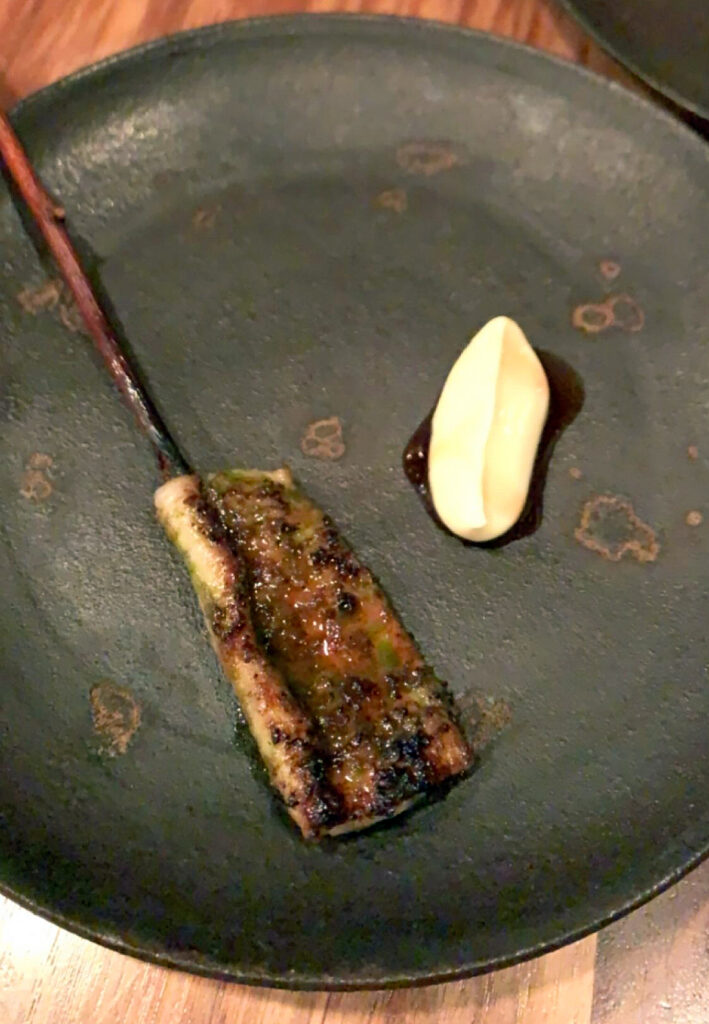
The eel would be impressive enough if it were merely served as a skewer; however, the condiments Shields has chosen ensure that the fish is given the same “Smyth treatment” as the rest of the menu’s seafood. In the first case, the apple reduction applies an added layer of sweetness with enough acid to avoid any cloying sensation. The cream, set inside that reduction, melds beautifully with the eel’s unctuous texture and works, further, to round out the dish’s more assertive elements. In the second preparation, cream and apple combine in the form of an apple kombucha cream. This condiment works to the same effect while also providing a heightened tartness that contrasts the fish and accentuates its richness.
While Smyth’s eel dishes—relative to the crab, lobster, halibut, and trout on offer—present diners with a new experience, they are worthy, wonderful additions to the menu. In fact, they stand among both the restaurant’s most unique offerings and the most delicious. It certainly has something to do with the latent sweetness such fresh eels possess, and you look forward to seeing the ingredient develop even further on future menus.
Approaching—bit by bit—the savory pinnacle of the meal, guests are by now amply primed to sample some of Smyth’s most indulgent vegetable preparations. These dishes do not merely demonstrate the manner in which an individual piece of produce—freed from its life sentence as a “side dish”—may actually anchor a particular plate of food. For that intention, by this point in the meal, has been well served by prior courses such as the barbecued cucumbers with yuba or sweet peas cooked in dashi (to say nothing of that entire asparagus sequence).
No, by now you hope that guests are convinced that fine dining need not look far beyond the humble field to satisfactorily feed them. You hope they have realized that the contrived appearance of all their favorite luxury ingredients throughout a menu does more to constrict—rather than channel—creativity. Yes, the guests, by this point, should stand convinced. They should stand ready for what amount to Chicago’s ultimate expressions of the vegetable kingdom. Call it “Shields unleashed” or “Shields gon’ wild” if you must: the chef’s most decadent preparations of produce—his most vivid expressions of Illinoisan terroir—assert, more than anything, the national caliber of his cooking.
Where better to begin than with the humble potato? The tuber in this case, of course, is grown for Smyth on The Farm. Yet, despite coming of age in local soil, this cultivar is a new transplant in town. The “Upstate Abundance” potato it is called, a “creamy, nutty and buttery (even without the butter)” variety grown by second-generation potato breeder Walter De Jong in Upstate New York. Though long considered “unmarketable” due to their golf-ball-sized girth, the tubers achieved a “quiet cult following” for their superior culinary qualities and found their way into Dan Barber’s kitchen at the Stone Barns Center for Food and Agriculture. There, they became a part of Blue Hill and Cornell’s larger program to refurbish the national food system, one of many standard-bearers for agricultural “best practices” and the depth of flavor that can only be developed—without genetic engineering—through careful seed selection and cultivation. That is to say, rather than breeding plants for “yield, shelf life and uniformity,” why not reorient towards once-ignored varieties that are both more nutritious and delicious?
This thought process yielded, among many exceptional ingredients, the habanada peppers (a heatless, fruity version of the habanero) already featured in one variant of Smyth’s uni preparation. You think it bears being said that Shields and The Farm’s adoption of Barber’s seeds for their own terroir amounts to a kind of activism. It represents a new level of ownership that goes beyond terms like “farm to table” or “organic,” establishing chef and farmer as peers in pursuit of the land’s most exceptional products.
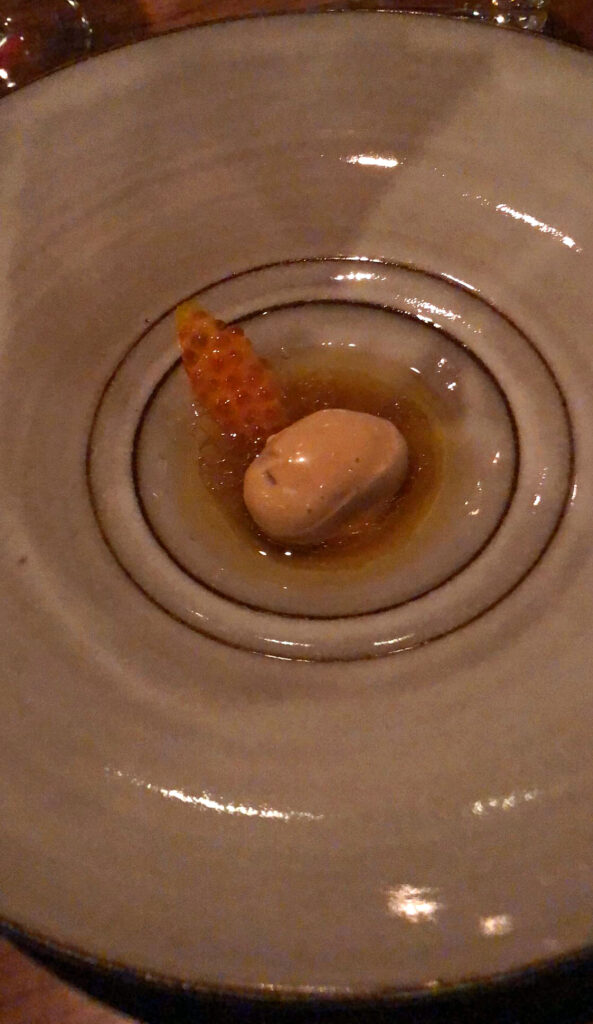
In that sense, Shields and Elliott Papineau (the proprietor, with his wife Rebecca, of The Farm) are not looking to squeeze the soil for all its worth, but to treat it with care and appreciate its full range of products: moment to moment and season to season. Heritage varieties like the Upstate Abundance, while not natively planted, demand a return to the practices known before the promulgation of factory farming. Their planting is an expression of the farmer’s care to cultivate the very best via natural, sustainable processes that allow for no shortcuts.
Papineau could only devote his land to lower yields of exceptional produce with the knowledge that Shields and his customers are willing to pay for them. The two men, thus, form a very short chain from the soil to the dish placed before you, one that demands the ultimate in trust between chef and purveyor. This is the true creative center of Smyth as a restaurant, and it undoubtedly makes the Shieldses and Papineaus kindred spirits to those toiling away in Tarrytown. The work they, like Barber, are doing—rooted essentially in the land—works to define Midwestern cuisine as never before and lends Smyth much of its national and international consequence.
Well, that’s all fine and dandy—but is the potato any good?
The Upstate Abundance’s first appearance on Smyth’s menu, during the fall of 2018, quickly formed one of Shields’s signature preparations. No doubt, he must have been excited to get his hands on one of The Farm’s most unique—yet undeniably “simple”—ingredients. For, how many restaurants have the opportunity to debut a “new” variety of potato? And how many chefs are granted the rare opportunity to champion a whole range of forward-thinking agricultural practices should they prove “the juice is worth the squeeze”? Yes, Shields’s use of the tiny tuber was consequential, and he knocked it out of the park. The dish would appear on three successive menus with nary a change: a testament to how well the combination was conceived from the start.
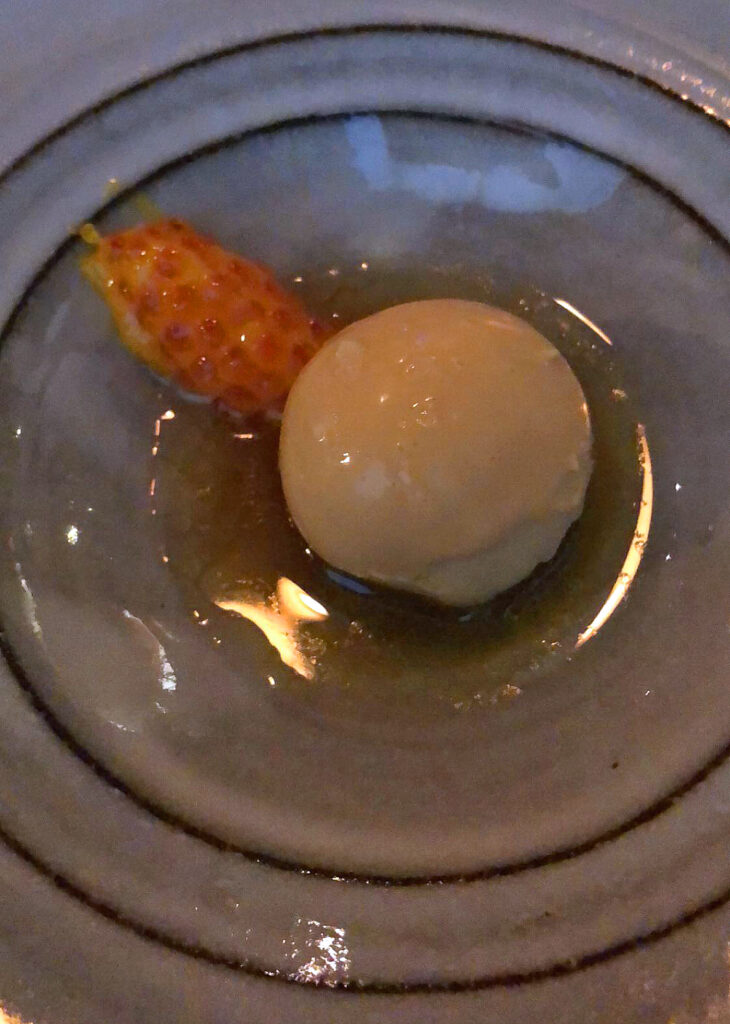
The dish places the Upstate Abundance at center stage of a shallow bowl. It is peeled, pale white, and about the size of a golf ball (though not of the sort Shields can often be seen striking on social media). The potato is flavored with yeast and paired with both spring onion and trout roe, which function more as seasonings than out-and-out flavor components. Because the star, of course, is that humble potato—that sole, lonely, starchy sphere served in a city known for heaping helpings of French fries (with some of the best, as it happens, being served just downstairs).
As you first plunge your utensil into the tuber, its smoothness arrests you. If it did not offer just the slightest resistance, one could be forgiven for thinking they were pricking into a perfect mound of mashed potato. But no, the Upstate Abundance marries an intense creaminess with just enough structure to hold its shape. It is nutty—made more so by the yeast—with natural flavors of butter. The spring onion, reduced into a jus, accents the potato with a tinge of vegetal sweetness. Meanwhile, the trout roe serves as a sort of gourmet salt flake: imparting a wonderful contrasting texture along with a touch of brine. Taken together, the dish condenses the full pleasure of a baked potato into a mere one or two bites. And it unleashes the tuber’s creamiest, nuttiest facets without the slightest hint of fat or dairy—a total inversion of starch’s prototypical role as a sponge for other flavors.
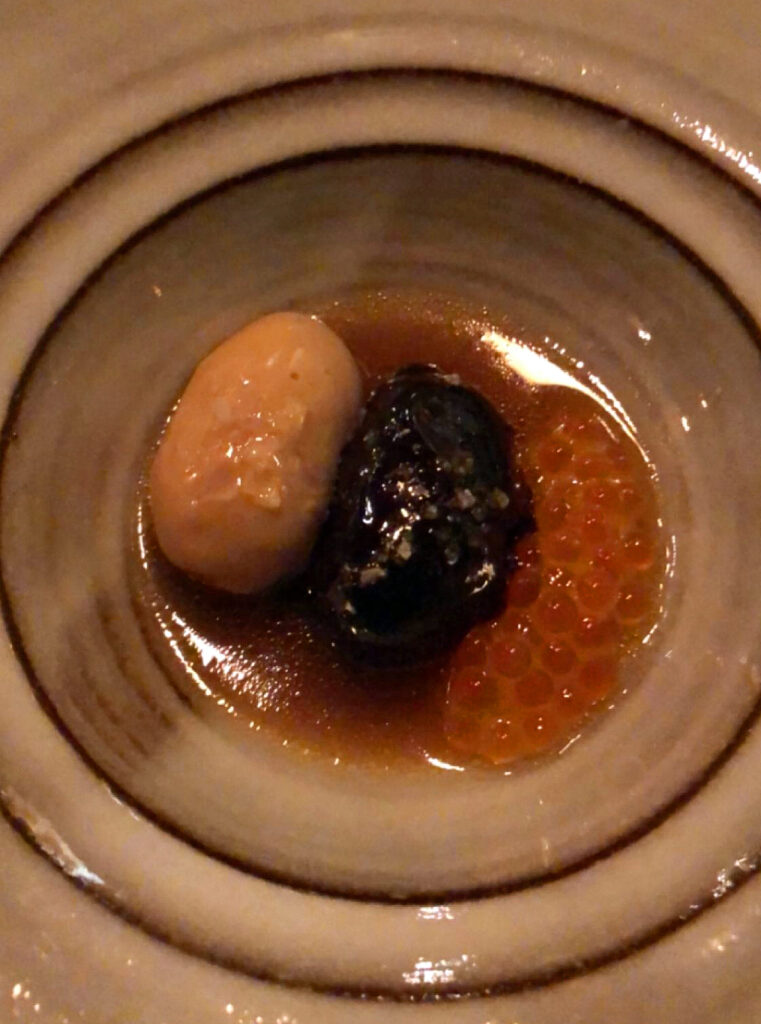
One later variant of this potato preparation retained the yeast and the trout roe but, instead of spring onion, paired the Upstate Abundance with a “potato skin bouillon.” Given the dish’s intention to showcase the tuber, seasoning the ingredient with the concentrated essence of its own discarded peelings is nothing short of genius. Rather than draw on another vegetable for added complexity, this second version supplements the smoother flavor of the whole potato with the earthier notes drawn from its skin. Thus, potato seasons potato, yeast (roasted in this case) enriches that flavor, and the trout roe provides an all-important, contrasting “pop.” It all amounts to a reverential treatment of the ingredient that demands diners take notice of its quality, one that absolutely proves its worth relative to conventional crops.
Around the same time of year, in 2019, the Upstate Abundance appeared once more on Smyth’s menu. Not content to rehash the recipe that had been a smashing success, Shields looked at how he might feature a different expression of the potato. The answer arrived not through further manipulation of the harvested tuber but, instead, at the point of cultivation.
Relative to the fully-mature potato, which demands approximately 100 days to grow, Upper Abundance’s new potatoes can be cultivated after only 75 days. They are even smaller, even sweeter, than the fully-grown “finished product,” with a negligibly-thin peel and a higher water content to boot. The new potatoes also appear at the very tail end of summer, allowing the diminutive (but still hearty) tubers to shine particularly bright as the cooler autumn weather sets in.
Whereas the mature Upper Abundance took center stage on the plate in its inaugural presentation, its new potatoes arrive at the table under a cloak of opaque foam. You can just barely make out slivers of spud rising from the frothy maelstrom when the server lets drop those magic words: “hazelnut praline sauce.” And, in truth, they need say no more. Though the yeast, spring onion, trout roe, and potato skin “bouillon” did a fine job studding the full-sized potato with a burst of added flavor, the combination of new potatoes with a sweet sauce made from hazelnuts offers the most extreme savory pleasure imaginable.
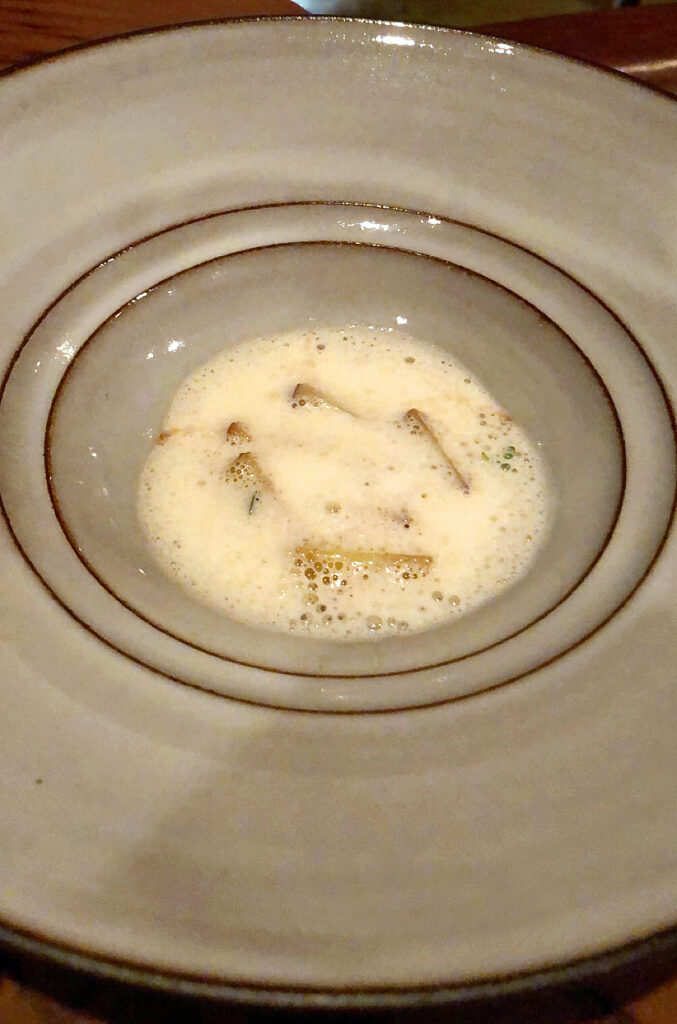
Yes, the new potatoes are buttery, and, yes, they are sweet. However, opposite the praline sauce, the spuds actually evoke a sense of earthiness. That is to say, while the sweet and nutty notes meld perfectly, they also unveil something of the Upper Abundance’s latent character. The dish not only offers a most-decadent expression of potato, but also reminds guests that it is a product of the soil. Yes, countless tubers are roasted, fried, or sauced into submission. Yes, in many cases, the ingredient forms a sort of anonymous “starch” substance more than it does a “proper,” nutritious vegetable. Yet here, in its youth, the potato sings a song of striking beauty. It shows—underneath the flourish the hazelnuts provide—the essence of the soil from which it came. And the tuber, in the midst of remitting so much pleasure, demands some of the respect granted to the other denizens of the vegetable kingdom.
In this dish, Shields marks the potato’s transition from mere “cash crop” to something which retains an untapped culinary potential. His use of the Upper Abundance, in both new and mature forms, offers the project estimable support and a real credit to its gastronomic appeal.
One more piece of produce has made its way from Dan Barber’s Blue Hill to Smyth. In some sense, you consider the ingredient an “anti-totem” of fine dining. That is to say, while classic totemic luxury ingredients like caviar, foie gras, and truffle are sure to impress guests, this “anti-totem” stands a good chance of provoking disdain, even disgust. Further, while the classic totemic luxury ingredients suffocate chefs’ creativity via artificially raised expectations, the “anti-totem” empowers chefs to surpass all expectations. For, those expectations are so low to begin with, and the kitchen can apply the full weight of their know-how to making an “ugly duckling” taste damn delicious. This “anti-totemic” ingredient is a fixture within the New Nordic movement of restaurants, and it is one—once you develop a taste for it—that ranks among the most pleasing of all root vegetables.
Of course, you speak of “nature’s treat” the beet. It’s a bloody, earthy, perplexingly-sweet root vegetable that, until recent times, has terrorized generations of Americans—alongside broccoli and spinach—as one of a cadre of unpalatable “health foods.” In that sense, it was nearly an altogether forgotten vegetable until the appearance of “baby beet salads” over the past decade. Such preparations seek to moderate the beet’s earthy qualities by way of blue cheese, candied nuts, tangy dressing, and bitter greens. In short, the ingredient demands quite a bit of help if it is to go down Americans’ gullets, and few amateur fine diners would ever expect to find it featured—or afforded respect—on a pricey tasting menu.
And Barber, being the proprietor of two of the country’s most esteemed fine dining restaurants, knows—as well as any chef—the work to be done in refurbishing the lowly beet’s image. Enter the “Badger Flame,” a variety of the root vegetable selected and cultivated by Professor of Horticulture Irwin Goldman at the University of Wisconsin-Madison. Goldman sought not only “to create a visually striking beet,” but to “take on the beet’s dirty reputation—the earthy flavor that many blame for their beet aversion.” He isolated the compound—geosmin—that produces that earthiness and, over several years of trial and error, struck upon a variety of the vegetable that is mild, sweet, and delicious raw. The seeds were then grown at Stone Barns across multiple seasons, further refining the Badger Flame until such a point that it found its way back home—not far from Madison—in The Farm’s Midwestern soil.
Like the Upper Abundance potato, which has only appeared on Smyth’s menu over the past couple years, the Badger Flame beet is also a recent addition. In truth, Shields has made excellent use of traditional beets from the very beginning—even as far back as Town House. For, while some chefs see the vegetable’s earthiness as an impediment, it actually offers an incredible asset in building the most powerful, savory vegetal flavors imaginable.
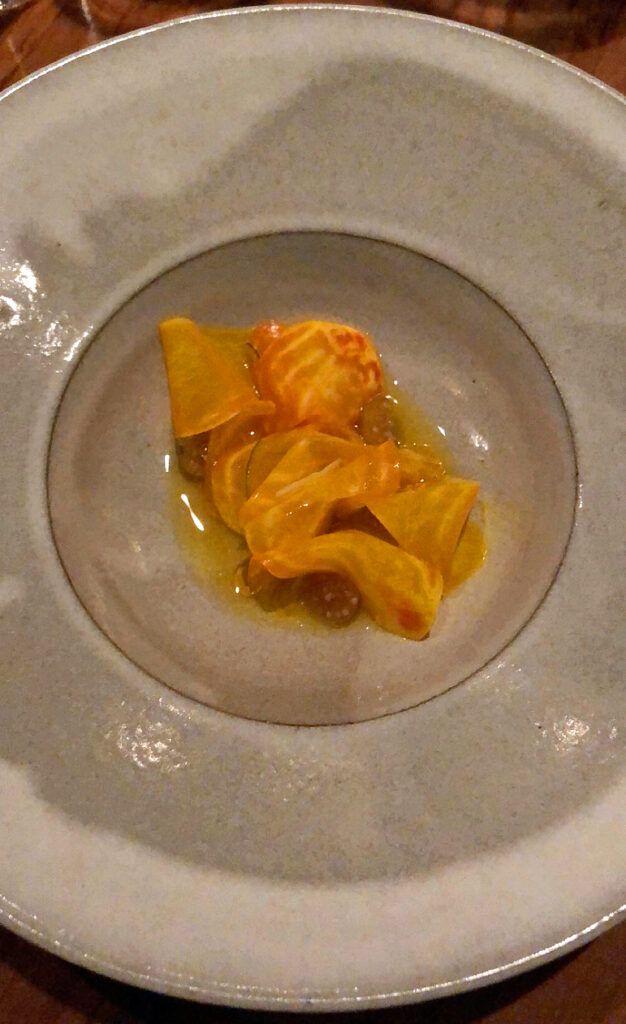
Thus, during the spring, the Badger Flame may appear on the menu anchoring a salad of heirloom tomatoes, smoked togarashi peppers, and marigolds. Or, instead, it may be paired with a yuzu brine, black walnut (that “old chestnut”), and a dollop of yogurt made from The Farm’s own dairy. In such preparations, the mild nature of Goldman’s cultivated variety allows the beet to form a robust textural element on the plate. Guests can appreciate its pleasing crunch, its bit of sweetness, without any earthy character overwhelming the more delicate floral, citric, and spice components on display. These dishes, more or less, amount to salads. And, as with the Upper Abundance, they form a worthy showcase for the Badger Flame’s unique characteristics.
However, it must be said that Shields’s best utilization of beets occurs during the depths of fall. At that point in the year, the Badger Flame’s brighter characteristics are snubbed in favor of the sinister, standard red beetroot. Of course, the vegetable is still grown with care by The Farm. But there is no effort to obscure the ingredient’s earthiness. Rather, that quality is indulged fully with a masterful touch, and the subsequent dishes form the very crescendo of all Smyth’s vegetable offerings throughout the meal.
Shields’s classic expression is titled “slow cooked beet,” which makes the manner of preparation rather obvious. The root vegetable, treated not unlike a roasted meat, stews in its own drippings for an extended period of time. In some cases, as many as twelve hours. This concentrates its sweetness—and, yes, its earthiness—while also melding the two and rounding out the ingredient’s rough edges. The beet’s texture, of course, is anything but “rough” when prepared in such a way. Its flesh may be likened to a well-roasted carrot or parsnip, but the vegetable’s “bleeding,” moist quality resists any direct comparison. It possesses the juiciness and mouthfeel of a bonafide steak while, at the same time, retaining a sense of structure as it is sliced into smooth, glistening chunks. This is a root vegetable that has been dressed to the nines, its vegetal qualities ditched long ago in favor of deeper, darker expression of the soil.
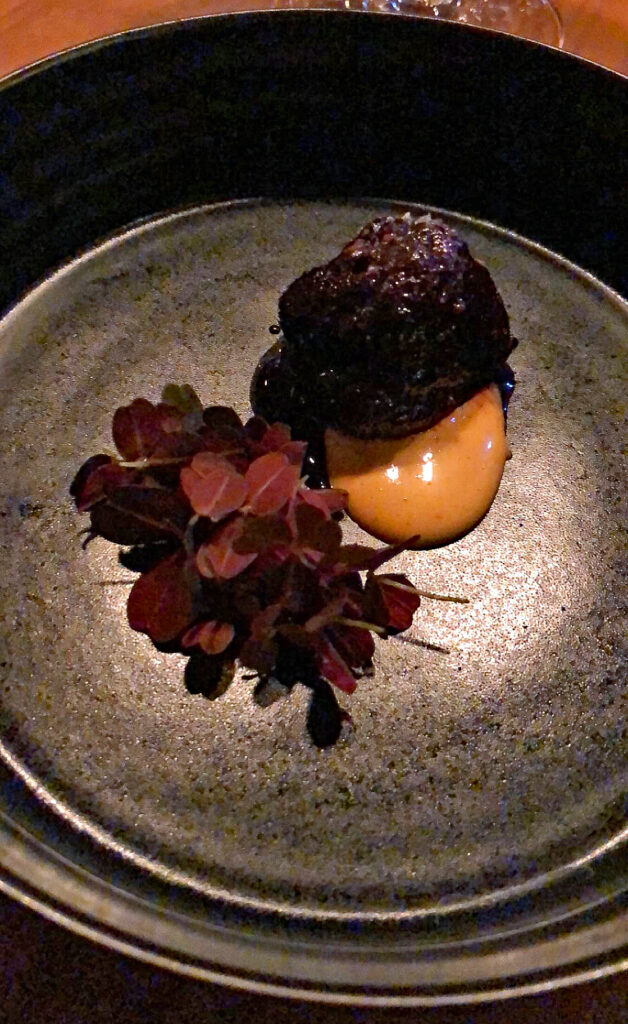
And, in that sense, Smyth need be careful. Adrian Kane—loathsome critic for Chicago’s obnoxious “The Infatuation” outlet—warns (with regards to the dish), “If you don’t like beets, though, you’re f*cked.”
But what, really, is not to like? Yes, beets are an “anti-totem” within dining; however, any claimed aversion to the ingredient is merely irrational. For, mind and body are simply incentivized to retain negative food experiences. There is an evolutionary advantage to avoiding, in the future, substances that were judged as unpalatable in the past. Thus, poor preparations of a given item remain particularly (and disproportionately) salient. And, perhaps, few American ingredients have been wielded as irresponsibly as beets.
Yet their flavor profile—sweet and earthy—is unquestionably valuable. Ask anyone with a taste for fine Burgundy if they are bothered by traces of “earth.” (To wit, it is those fingerprints of terroir that absolutely define the enjoyment of great wine).
So, no, Smyth’s beets really should not be stereotyped as being related to legions of lousy beet preparations foisted on poor souls at dinner tables throughout the land. The question, as always, is how does a given chef balance the qualities of a given ingredient? Any baggage—rooted in negative experiences at the hands of cooks who do not possess one iota of Shields’s talent—should have been left with the hostess. For, the slow cooked beet provides Smyth with one of its most captivating canvasses.
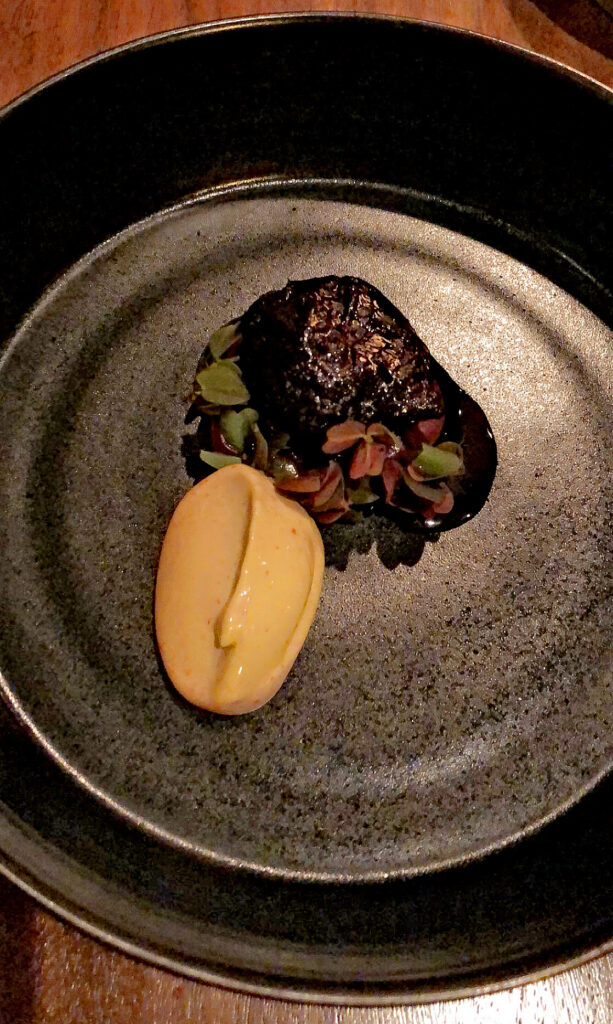
In the first iteration of the recipe—which landed somewhere between roast duck and beef tongue courses—Shields paired the beet with a “beet boudin noir” and a cream made from coral (a term used to refer to a lobster’s deep red roe). The second iteration of the recipe, served in between miso crab and lamb preparations, instead paired the vegetable with “pork & beet blood” as well as black currant. (The latter dish, you also might add, came accompanied with a lovely glass of Luciano Sandrone’s 2013 “Le Vigne” Barolo)
For all intents and purposes, both the “beet boudin noir” and “pork & beet blood” components accomplish the same goal. The slow cooked beet, though its texture approximates animal protein in some ways, is undoubtedly the star of the dish. There is little room to drape or pair the vegetable with meat in such a way that would avoid it taking center stage. Thus, a wee bit of pork—invigorated with pork blood and the “blood” of the beet—forms a most powerful background note. While the pork itself adds to the illusion of the beet’s meatiness, the harsher flavor of the blood actually serves the dish even more. It, perhaps more than anything, neutralizes any errant earthy notes that may overshadow the richness and sweetness Shields works so hard to build.
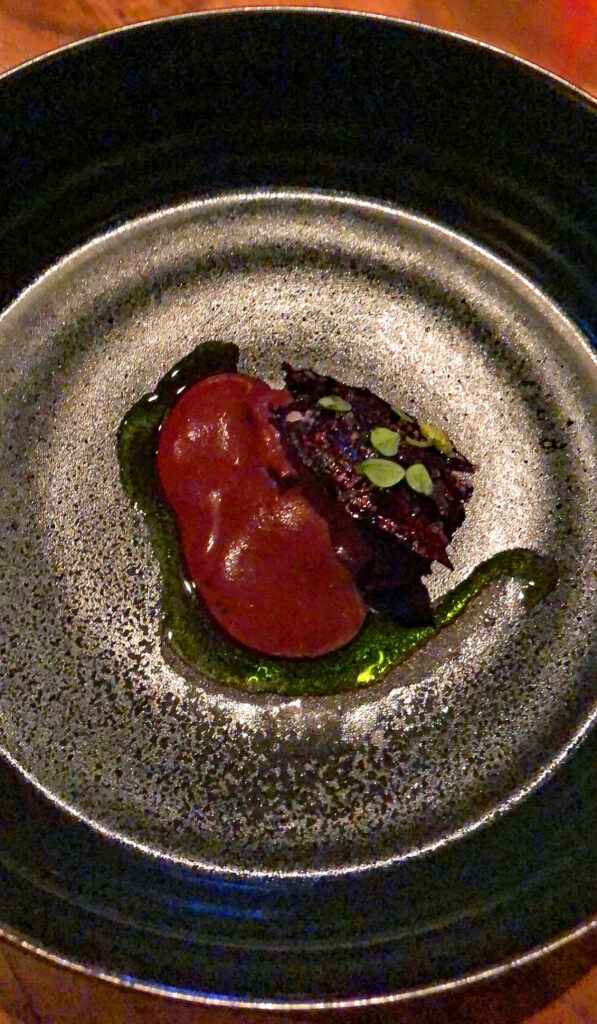
The coral cream—yet another ingredient the chef made use of back at Town House—not only lends the dish a crustaceous element of fat, but the cream coating itself elongates the beet’s luscious texture and further serves to salve struggling palates. It, in many respects, is an olive branch for the earthy-averse. The black currant element in the second iteration, by comparison, doubles down on the beet’s sweetness in order to unleash a still-deeper savory character. There, an intelligent wine pairing like Nebbiolo—replete with tar, tannin, cherry, and acid—accentuates the dish’s supreme sense of balance and its capability as a stand-in for steak.
As is so often the case at Smyth, classic preparations like the slow cooked beet inevitably bid adieu only to be replaced by something that is—against all odds—even better. Rather than slow cooking the root vegetable as a means to build flavor, Shields—in 2020—opted for a new manner of treatment. Handling the beet even more like a piece of meat than before, he began dry-aging it for a period time. This technique does not only concentrate the ingredient’s flavors over time, but the manner of slow decay develops a whole host of funky, fungal, intensely savory, and unsurpassably umami notes to boot. The vegetable’s earthiness, in this case, is no longer something to tiptoe around—to “balance” or otherwise obscure in a halfhearted gesture towards remedial palates. Dry-aging, instead, embraces the beet’s essential character to an even higher degree: the gloves are off and no holds are barred.
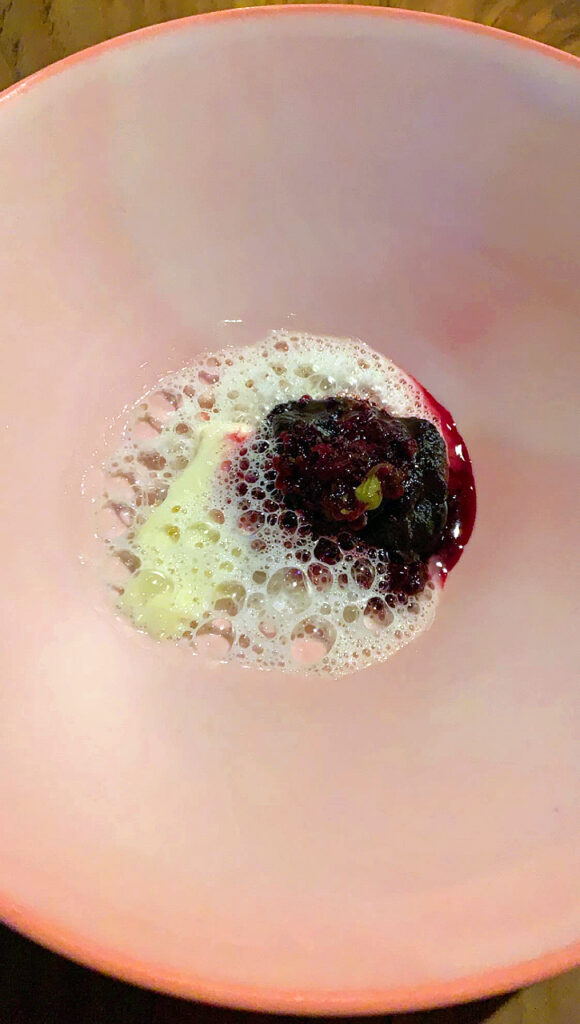
And yet, when the dish arrives at the table, the beet has abandoned its porcine honor guard. Yes, despite the promise of an unparalleled intensity of flavor, the vegetable is paired only with a frothy sauce made from The Farm’s milk and a schmear of white asparagus cream. The beet itself stands in stark contrast to these tones of white. It is a dark crimson with a seemingly jellied consistency and some brighter red “bricking” of beet “blood” running off of it. When compared to the slow cooked beet’s “boudin noir” accompaniment, to the coral cream and black currant accents, this iteration of the vegetable is positively minimalist.
That is due to the fact that the aged beet, presented so, achieves something close to perfection. The vegetable’s exterior is sappy, yielding to a smooth interior and the slightest remaining structure—which offers the most minimal resistance as you take one or two mouthfilling bites. The ultimate sensation on the palate is one of superlative tenderness married with the most pleasing, multidimensional sauce. Really, with eyes closed, you could be forgiven for thinking it a morsel of filet mignon with sauce bordelaise in your mouth. Shields has found a way to distill the deepest, sweetest, and darkest essence of the soil into one mere vegetable. The beet is not just “meaty,” but the sort of meat that begs for (and completes) fine wine. (Of course, Smyth’s chosen pairing of 2016 Guiberteau “Les Aroibses” Cabernet Franc certainly fits the bill). But it is no surprise that the milk sauce and white asparagus serve only to lend shape to the beet’s uncompromising power. There can be no question that, in this aged form, the ingredient attains a unique pinnacle within the entire plant kingdom.
With all the talk of shellfish, finfish, roe, and produce (of all shapes and sizes) thus far, you would be forgiven for thinking Smyth’s menu has little to do with the preparation of any “proper” meat dishes. (Actually, given the avalanche of Chicago’s best cheeseburgers being served downstairs at The Loyalist, such an assumption seems foolhardy). But the point stands: dish after dish after dish—many excellent, and some already incorporating animal protein as a supporting element—just what is there left for Shields to showcase? Would some standard, meager helping of A5 wagyu really elevate the experience on the back of countless innovative creations?
Of course, dinner at Smyth is not so simple. Shields isn’t the kind of chef to bow before totemic luxury ingredients like wagyu in a bid to please his guests. Such sterling cuts, at this stage in the game, simply lack interest. They lack any sense of story, not to mention any opportunity to transform the ingredient—whole cloth—into something unforeseen and utterly delicious.
The “main courses” (which is to say the meat dishes) at Smyth follow the same rules as every other plate. That is to say, animal protein is not given special status—it is not treated in any precious manner—but empowers the same cornucopia of texture and flavor as the many humble roots and tubers that made up the menu thus far. These dishes are carefully crafted to impress, to push the boundaries of their respective ingredients, and not to ingratiate themselves towards diners seeking a shallow reprieve from the intelligent cookery that has, thus far, defined the meal.
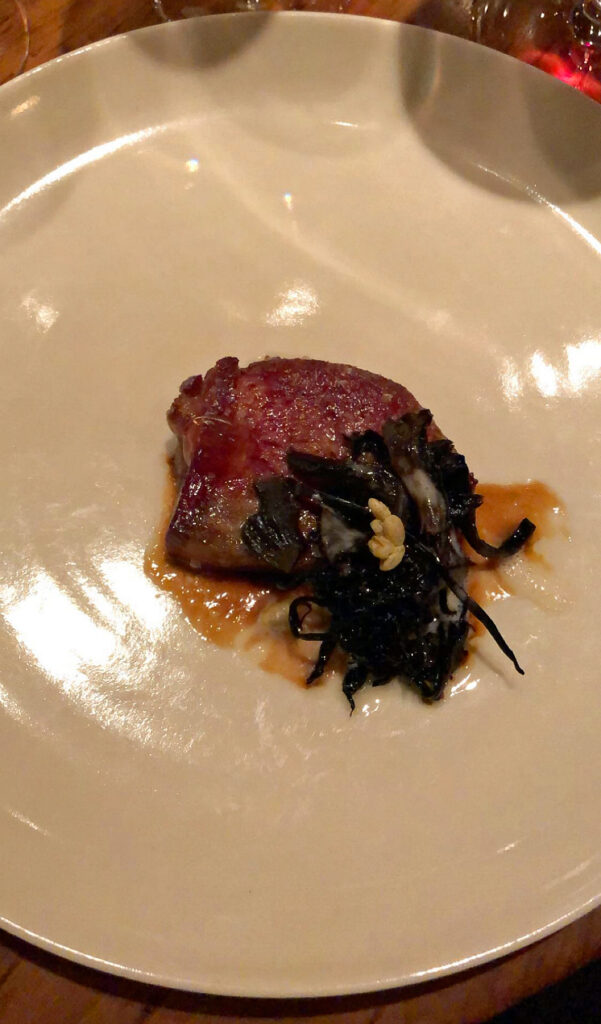
Preparing meat, in Smyth’s case, reflects the same sense of identity imbued into each treatment of every ingredient across the menu. It is, at is core, a “farm” identity where animals are beloved and their flesh, on those occasions when it is butchered, is treated with reverence. Thus, you should expect to see a variety of cuts treated with precision and seasoned with an eye towards the unexpected. In this fashion, the dishes resist becoming the mere fulfillment of a carnivorous expectation and, instead, really break new ground within their category.
Squab, more than any other animal, has stood as the restaurant’s defining protein for many years. Shields, of course, does serve beef. It comprises the patties of those famous burgers served downstairs, and it also appears on two of Smyth’s three tasting options. Typically, the five-course “Classic” menu will feature a main course of aged beef ribeye. The eight-course “Smyth” experience, instead, bravely serves guests beef tongue. However, the twelve-course “Omaha” menu has always showcased squab. The game bird, on later occasions, has been joined by preparations of lamb. However, the statement Shields is making is clear—and, quite frankly, it is a genius way of shaping the various options.
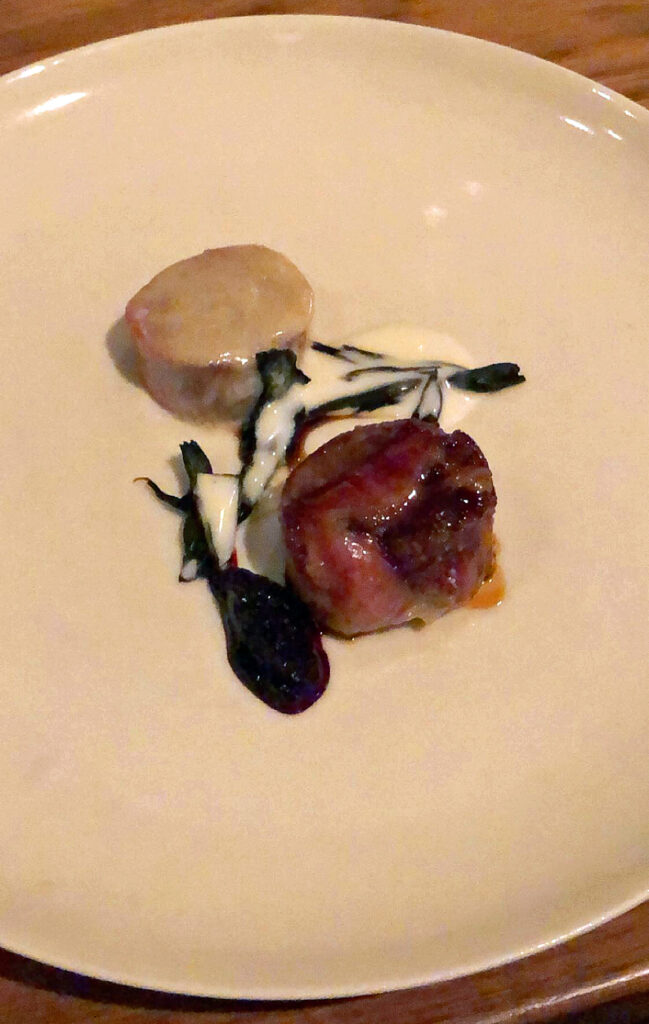
You see, that “Classic” menu is also termed a “tasting vignette.” It’s an abbreviated experience for those short on time, short on money, or—otherwise—squeamish about the prospect of surrendering themselves to the machinations of the chef. These diners will only scratch the surface of what the restaurant has to offer, yet Shields ensures they go home happy: he’ll pair a portion of aged ribeye with reduced cream and oyster mushrooms in a manner that forms something of a facsimile of the flavor combinations that define the most exciting dishes on the extended menu. The chef, to his great credit, is not too proud to aim at offering pure pleasure. Still, the composition of his ribeye plate indelibly bears the markings of his personal style, one that you hope guests are sold on after opting, for whatever reason, for the five-course menu.
(As an aside, is there anyone more detestable than the “fine dining aficionado” who is content to critique a restaurant based solely on their experience of an abbreviated menu? You recall meeting several aspirational “foodies” who judged Blackbird—that legendary Midwestern restaurant which, lamentably, closed—solely on the basis of its prix fixe lunch. Of course, during the evening, executive chef Ryan Pfeiffer served one of Chicago’s most exciting tasting menus. But these diners were all too happy to indulge in a “Michelin-starred lunch,” check the restaurant off their bucket list, and pretend they have the slightest idea of the team’s talent. Smyth’s shortened menu offers such people an olive branch, and, thankfully, it represents the Shieldses’ vision well. But nobody should dare comment on the overall quality of an establishment where they elected to experience the bare minimum. In fact, no critic should pass judgment based on a “first impression” alone. Yet the “foodies” of which you speak certainly betray that they have no interest in sincerely engaging with the restaurants whose prestige they seek to commandeer for the sake of portraying a “luxurious” lifestyle).
The eight-course “Smyth” menu, relative to the “Classic,” can be said to offer guests a full experience. Of course, the selection of dishes does not abandon itself fully—as with the “Omaha”—to the latest and greatest creations to come out of the restaurant’s kitchen. Rather, the experience revolves around the signature dishes and sequences the Shieldses really hang their hats on. It’s a perfect menu for first-time guests of all stripes, as even experienced gastronomes may not commit themselves to a longer meal until they familiarize themselves the restaurant’s cuisine.
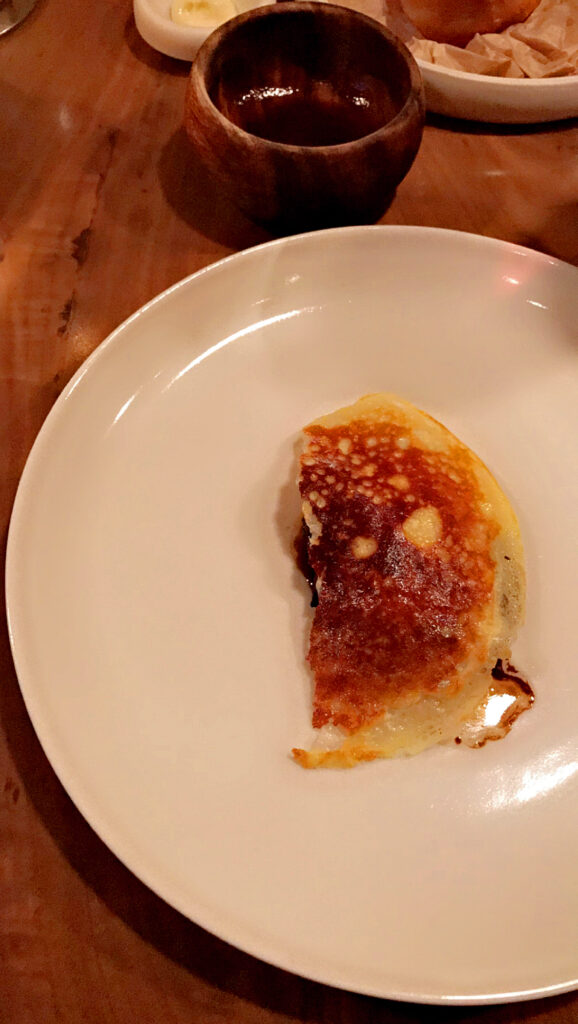
With this in mind, Shields’s decision to serve beef tongue at the crescendo of the eight-course menu is rather consequential. Though many diners might figure that a piece of ribeye is more “luxurious” than a slice of beef lengua, it is the latter that the chef chooses as the fuller expression of his vision. In this respect, Shields opts for distinction and depth of flavor rather than appearances. The beef tongue, of course, is helped by the fact that diners indulging in the “Smyth” menu will have sampled (and, hopefully, been satiated by) several more courses. But there is no question the chef is taking a risk. However, pairing the tongue with accents like marmite, koji, and a sauce made from cow’s milk—those familiar tools in Shields’s toolbelt—ensures skeptical guests are greeted by a bum-rush of intensely beefy flavor. On some occasions, the lengua even features as the filling of a savory crêpe—a playful take on the cut’s typical appearance within tacos.
Squab, ranking above both ribeye and tongue as the pinnacle of the twelve-course “Omaha” menu, clearly represents something special. To wit, if the lengua offers a greater sense of identity and intricacy than the steak, then this wee game bird must be the ultimate expression of Smyth’s ethos. And, truly, it is.
Just as The Farm’s produce privileges freshness and flavor over the yields of factory farming, squab—the first domesticated poultry (even preceding chicken)—demand careful nurturing if they are to be cultivated for food. Relative to birds like duck and goose, the squab—actually a type of young pigeon—is characterized by flesh that is far more tender and equally as rich. They are primarily raised in covered pens throughout central California and South Carolina, with the species’s “notorious sensitivity” demanding the use of high quality feeds and small-scale techniques. By the time it is harvested, the squab weighs only one pound. The meat, then, is certainly precious, but Shields has utilized it since his days at Town House—South Carolina not being all that far from Chilhowie after all.
Though guests indulging in the “Omaha” experience may have no idea what to expect when it comes time for the “meat course,” they might actually have already spied their special bird. The spindly carcasses—one for every two guests enjoying the extended menu—are strewn up above Smyth’s woodfired hearth. Diners, at a certain point in the evening, might witness one of the cooks literally fanning the flames of the hearth’s embers, upon which their eyes are drawn upwards towards the succulent squab sitting three, four, or five in a row. Still, others will excuse themselves and venture to the set of bathrooms positioned behind the kitchen. That short walk will bring them directly adjacent to the wood fire, which smokes and smolders with every dribble of drippings that drops from the bird.
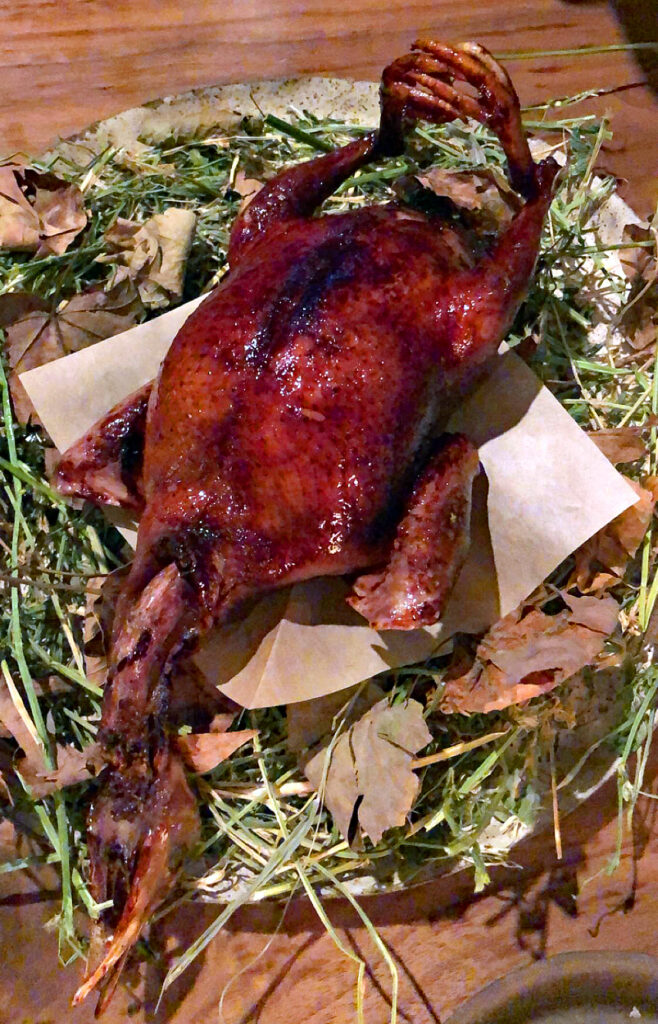
This manner of preparation, however, does not only make for an engaging ambient element within the restaurant space. Positioned well above the fire, the squab is slowly imbued with the flavor of smoke while its skin achieves an attractive golden brown hue. But fear not! There is no chance that the temperature of the bird’s most-delicate flesh will progress past medium rare. (In fact, the 1997 edition of The Joy of Cooking warns that squab cooked past that point develops a “distinctly ‘livery’” flavor). When the time finally comes for the squab to set flight—into guests’ waiting gullets—a member of Smyth’s team retrieves it from its lofty perch. It is given a quick, final fry to crisp its skin. Then, the carcass is then presented to the lucky table on a “nest” made of leaves and straw before being absconded to the kitchen for a final bit of butchery ahead of being plated.
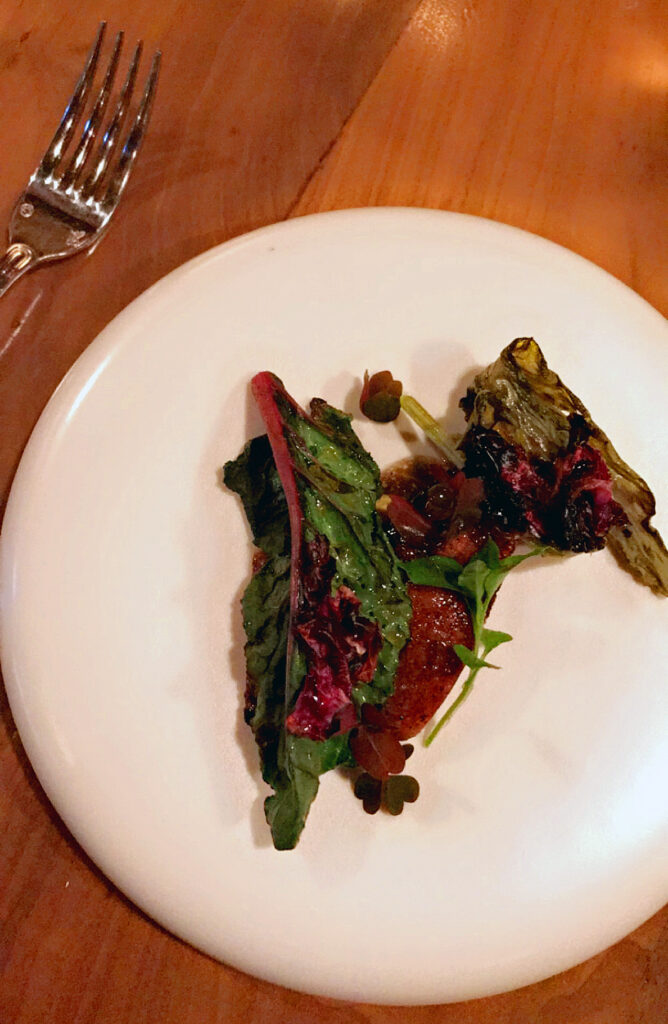
Shields’s squab compositions have taken a wide variety of forms, yet they all center around the breast (little surprise, given the bird hardly has a surfeit of meat). On your very first visit to Smyth, the squab was dry-aged for three weeks and served with fermented corn, huitlacoche (an earthy corn fungus), swiss chard, and a foie gras/squab jus. By the third visit, the bird was being paired with foie gras mousse, popcorn, and hickory nut (a type of dense, sweet nut similar to walnuts). For the meal after that, the foie gras transformed into a full-blown ganache. The squab was then paired sorrel, a lemony spring green that would become something of a signature garnish for the dish.
Just one meal later, the squab arrived “wrapped in sorrel” with an accompanying sauce of burnt honey and a garnish of roses. After that, the bird was simply “lacquered with The Farm honey” (though also served with sides of melon, corn, and johnny cakes). The next rendition followed in the same vein—albeit in a simplified form that retained only the corn, the johnny cakes, and the lacquered squab (now served as a halved carcass that includes a sort of “drumstick” along with the breast meat).
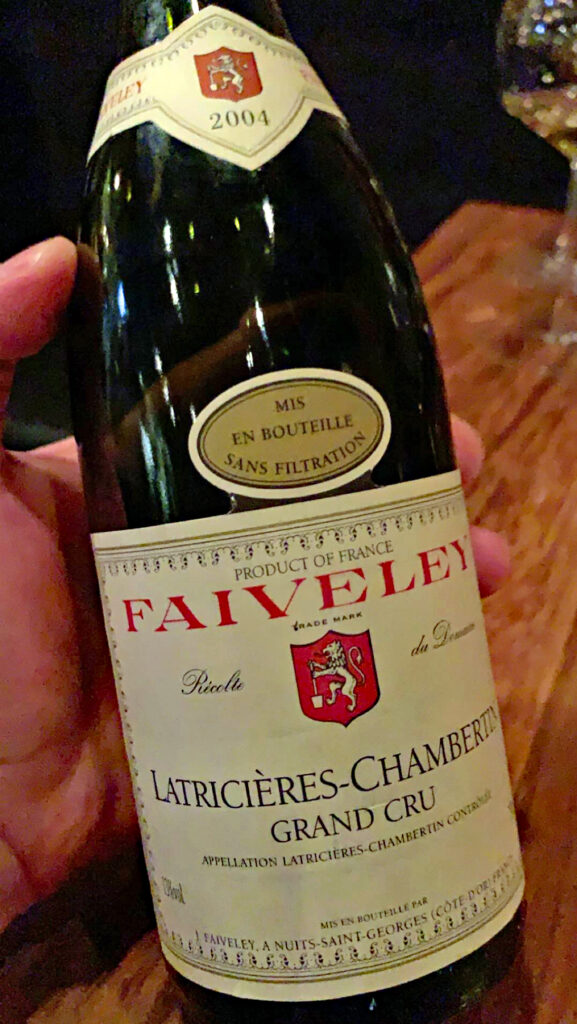
Lacquering, as it so happens, would prove to be Shields’s preferred preparation. (And it is no wonder, given legendary preparations like Eleven Madison Park’s “honey lavender duck” that make use of the technique). Later variants of the dish would pair the lacquered breast meat with ingredients like liver pâté, cherrywood, and black truffle—or, perhaps, a bit of blood sausage and a 2004 Domaine Faively Latricières-Chambertin. The squab leg, meanwhile, would be given its own attention: served either as a separate meat “lollipop” or, on one occasion, as part of a “salad” made from flowers and a dressing of guinea hen jus. This list encompasses the majority of the bird’s preparations you have witnessed—an assortment, you think, that speaks to how little “help” the squab’s superlative flesh needs to shine.
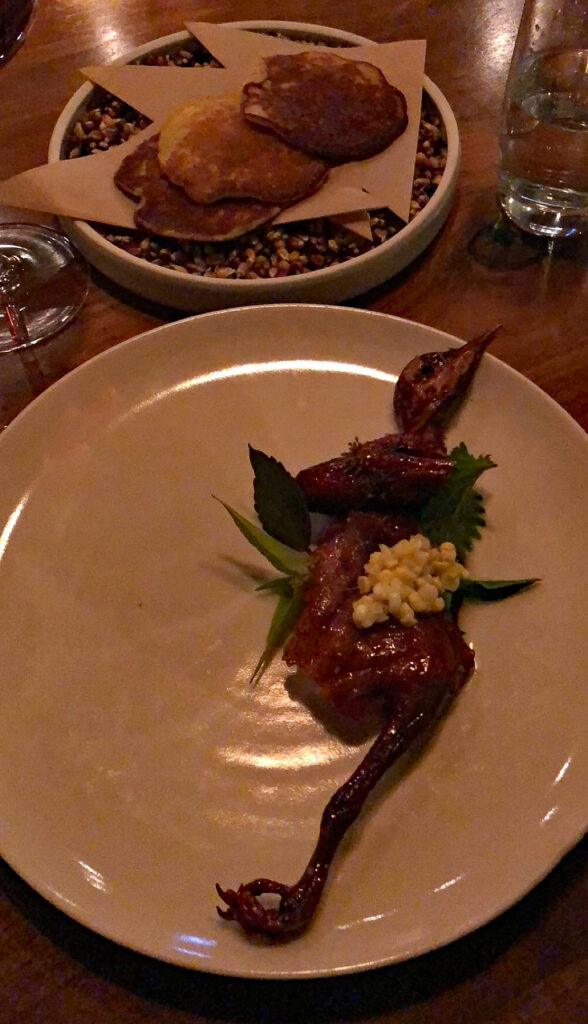
For corn—be it fermented (that is to say, tangy), fungal (like the earthy huitlacoche), or popped—accents the squab with a measured dose of sweetness and texture. Smyth does sit in the center of the Corn Belt, after all, and, while the ingredient’s reputation has suffered due to its refinement into corn syrup, it still stands as the region’s quintessential grain. Both fermentation and cultivation of the corn fungus (itself an absolute delicacy in Mexican cuisine) complicate the kernels’ straightforward flavor and contrast the richness of the accompanying bird. The techniques—which, in truth, are merely the spurring of natural processes—make for an intriguing combination of grain and game that you can imagine being done hundreds of years ago. (Chicago’s early reputation, of course, was as a “frontier city” where game of all shapes and sizes—even up to bear—was proudly prepared at the finest restaurants and banquets),
Shields, as you have seen, initially chose Swiss chard as his green of choice to pair with the squab before tending reliably towards sorrel. The chard—lightly draped over the bird—retained its stem and made for a leafier, crunchier green with trace bitter notes that were well-matched to the richness of the breast meat. However, since the portion size yielded by the squab is so slight, it is right to wonder whether the chard’s presence on the palate was really necessary or if the bitterness it lent might undermine the meat’s intensity. The sorrel, by comparison, was cooked until completely tender and wrapped flush around the bird. This ensured the leafy herb would have little impact on the dish’s texture while imparting a milder contrasting note both tangy and sour. Further, whereas the chard was accompanied by the aforementioned corn elements on the plate, the sorrel and squab stood together alone (save for a drizzle of jus). Such parsimony—both in flavor and texture—speaks to the sorrel being a superior ingredient for the preparation.
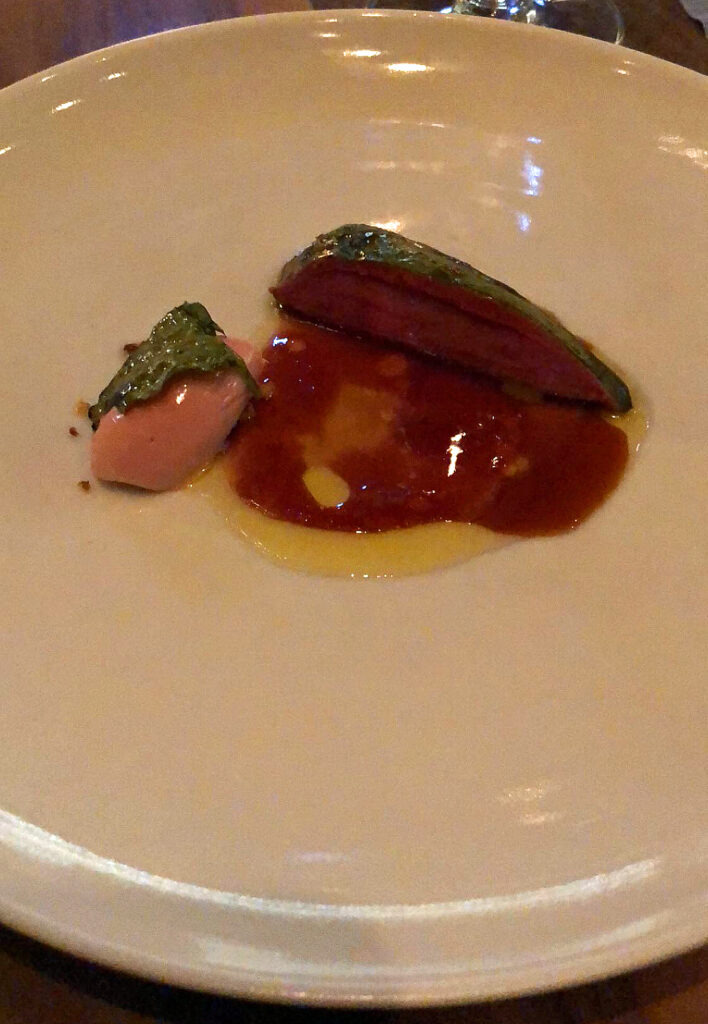
Foie gras in various forms—be it a jus, a mousse, a ganache, or a pâté—has featured in Shields’s squab preparations since as far back as Town House. There, “poached squab breast” was paired with Thai basil, root beer consommé, and a “golden egg” of liquified foie gras. At Smyth, the same savoir faire reigns. Given that the flavor of well-cooked squab is already likened to that luxury totemic duck-or-goose liver, it makes perfect sense to stack richness on top of richness and allow the two to define themselves via subtle shades of contrast. Principally, of course, that comes down to texture: good liver is perfectly smooth while the succulent squab breast maintains a bit of chew. Placing one flavor atop the other, predictably, sends the dish’s richness into overdrive without—and this is key—indulging in any harsh gamey notes. Rather, again with reference to the size of the squab’s portion, this extends the ingredient’s mouthfeel and its ultimate impact in a manner that fortifies the pleasure offered.
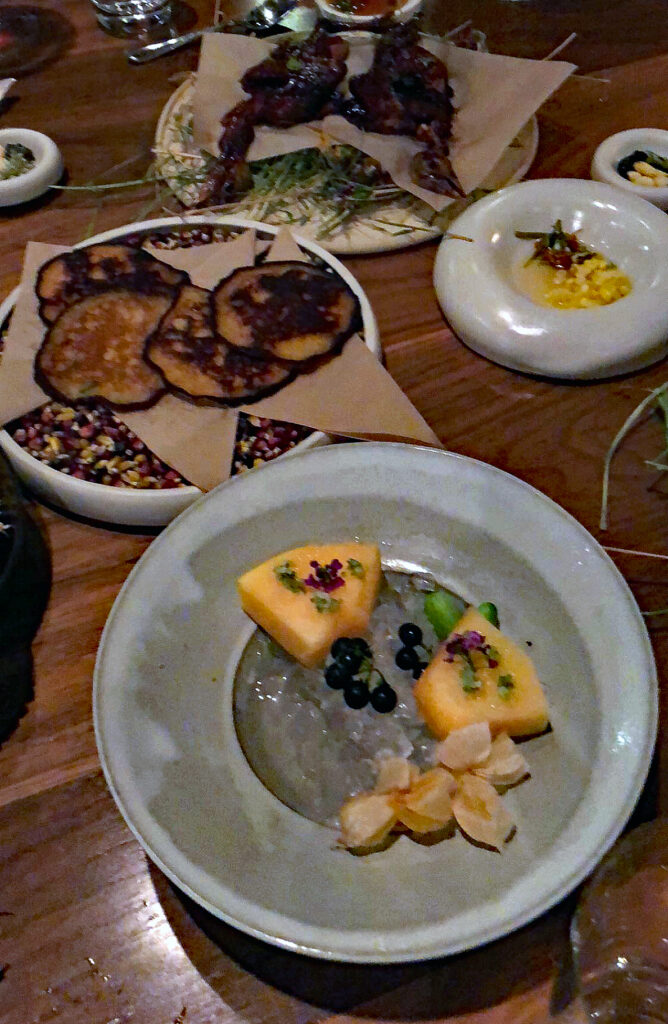
Other accompanying elements like hickory nut, black truffle, burnt honey, and melon bring—in their respective preparations—familiar, pleasing notes to the party. The “johnny cakes” (similar to pancakes but made solely from cornmeal) are both playful and genius. Wrapping a piece of liver-coated squab inside of one makes for a Bizarro World version of a Peking duck pancake (or, you should say, the pairing channels the Mandarin technique in a uniquely American manner). Of course, you choose to believe that the “johnny” referred to by the cakes, in this case, refers to “Johnny” Shields himself.
However, the real story with regards to Smyth’s squab is undoubtedly the lacquering technique. Other than demanding some prior planning, it’s not a difficult process. The squab is brushed head to toe with The Farm’s honey then allowed to stand for a short time. It is brushed once more, generously salted, and refrigerated overnight. The next day, the bird gets painted one more time and refrigerated, overnight, one more time. The day after that, the squab is finally ready to cook.
Simple, no? The technique—which Smyth likely tailors to their particular needs—ensures the squab develops a crackling crisp skin replete with notes of—you guessed it—The Farm’s own honey. Whereas the many wonderful ingredients Shields pairs with the bird work to unleash its latent flavor, the lacquering technique actually imbues the bird’s skin with a most complementary sweet note. Moreover, it takes the squab’s texture—a small cut of meat with little room for error—to the peak of perfection. Lacquering, combined with a slow roast over the hearth, amounts to a reverential treatment of the animal that ensures—time after time, no matter what else finds its way onto the plate—the bird arrives in superlative form. To say that this dish, in any of its forms, screams for wine is an understatement. And yet, to a teetotaler, drinking is in no way required to take immense pleasure from the honeyed breast meat. Shields’s work with squab over the years has been nothing short of a revelation and an immense credit to the kind of cooking that has defined the Midwest historically.
If there is one critique you would make regarding Smyth’s squab preparations, it would be that the ultimate amount of meat served falls a bit short of satiation. Many a diner, of course, will be quite full by the point in which the bird appears. And, truthfully, you would hate to see the squab replaced completely by something more cookie-cutter. For there are bigger birds in the sky but few with such transcendent flavor. Fine dining, as opposed to the excellent (but more approachable) cuisine served downstairs at The Loyalist, should certainly privilege the intricate over the filling. (Nearly every other restaurant exists—to some degree—to shove a satisfactory amount of food down your gullet). So, you would hesitate to tip the balance of Shields’s menu towards a greater sense of substance at the cost of his artistic vision.
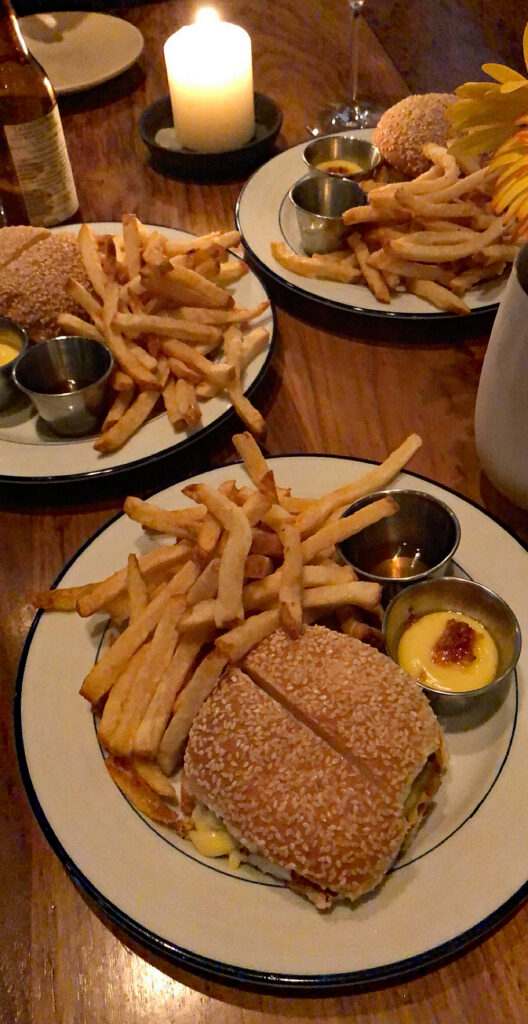
Smyth, being the bellwether of superlative hospitality that it is, always had a solution ready. On many occasions, moving the needle from peckish to perfectly content required only an extra helping of brioche doughnuts (more on those to follow). Other times, your ravenousness (perhaps a consequence of imbibing a bit too much throughout the meal) was remedied by the arrival of two or three of the famous cheeseburgers served downstairs—with fries. It goes without saying that few establishments could or would indulge guests in such a way, to such an extreme degree of quality. The pleasure one feels from such a quick transition—stunning small plates accompanied by sips of wine, quickly followed by barbaric chomps into a juicy beef patty and glugs of wine—is something like the apotheosis of dining. It’s the best of both worlds offered by the same restaurant without any trace of guilt. And it sure as hell beats rushing for hot dogs mere minutes after Alinea’s “table dessert” wraps up.
While the restaurant has been incredibly accommodating of your outsize appetite over the years, it should come as no surprise that an elegant solution presented itself. Alongside that succulent squab, Shields added to the “Omaha” menu—not beef, not chicken or pork—but a preparation of lamb. Yes, despite Greektown’s sprawl being situated a mere mile to the southeast, the meat of young sheep is conspicuously absent from the menus of Chicago’s greatest restaurants. Of course, those classic Greek restaurants stand ready and waiting to serve it to you, but the ingredient offers Smyth’s menu much of the same potential as the squab.
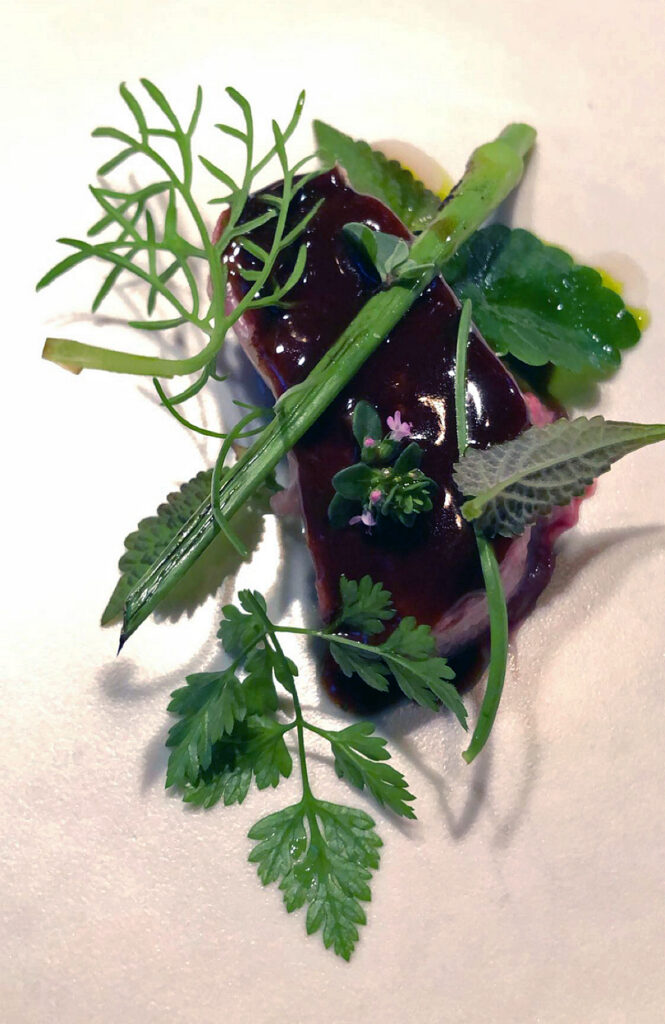
Lamb, when cooked perfectly, possesses all the heartiness and mouthfeel of beef but, on top of that, offers its signature grassy, gamey, or shall we say “rustic” notes. Which is to say, the meat offers a far greater canvas for a talented chef to fill with flavor than the milder flesh of other animals. Like the squab, the lamb’s robust character invites all sorts of powerful, decadent savory notes to the party. It only demands a bit of care to achieve a perfect medium rare temperature—not exactly a challenge for a kitchen of this caliber.
At the end of the day, when it is always so easy to thoughtlessly serve one of those familiar cuts of “A5 wagyu,” Shields’s pairing of squab and lamb in a protein double billing is commendable. He’s a chef who seems to consciously avoid the tropes indulged by his peers—even the very best of them. But, you think, there’s really nothing concocted about the selection. Shields ceaselessly challenges himself, he seeks ever-newer flavor combinations, and new means of providing satisfaction to his guests. Lamb, removed from a traditional “Easter” context, certainly fits the bill. Is it any surprise the chef was serving a 36-hour confit of lamb with licorice gelée back in Chilhowie? And, even then, it was so good that The New York Times could not help but take notice!
At Smyth, the lamb has appeared in two principle preparations over the years. The first iteration appeared fleetingly during 2018—you believe it was only served to you once—before the ingredient—in its second form—became a fixture the tasting menu throughout 2019 and 2020.
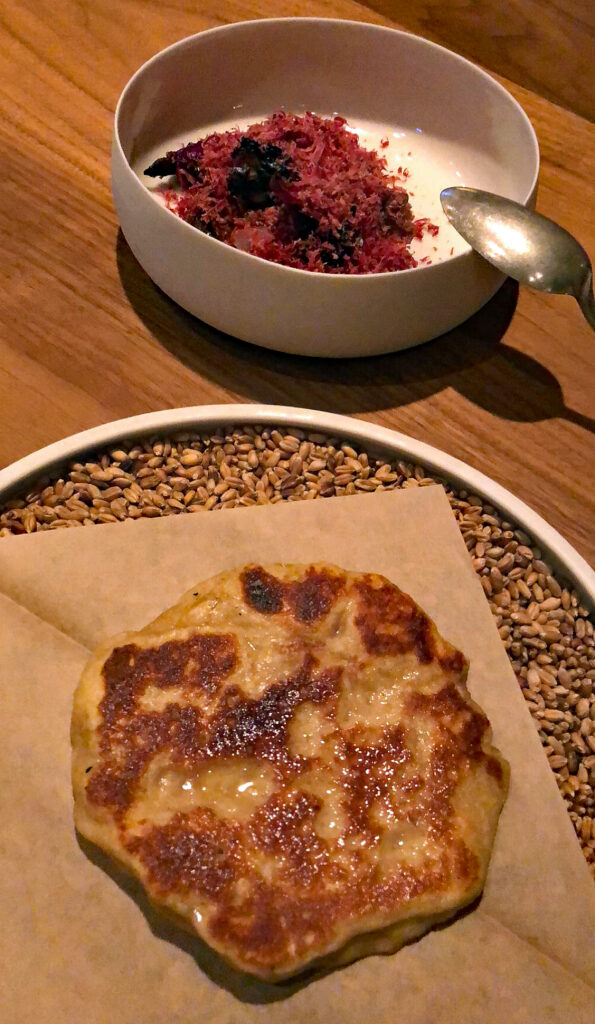
That inaugural dish featured lamb “breast” (a butcher’s cut taken from the young sheep’s lower spare ribs, rather than the upper ribs from which racks of lamb are formed) paired with soured cream, a shredded “jerky” made from the lamb’s heart, and a flatbread made from Anson Mills Trigo Fuerte wheat flour. This flour is an exceptional blend of two heirloom wheat varieties from the early 1800s, characterized by nutty, spicy notes and a robust texture that is perfect for tortillas, crackers, and other thinner breads. Here, the flour lends itself to a wonderfully crisped receptacle for the tender slices of breast meat.

Of course, the sensation provided by the soured cream makes the package akin to something between a “lamb pita” and “lamb taco.” The cleansing effect of the dairy serves to moderate the sharp, intensely meaty flavor of the butcher’s cut, which itself is bolstered by the shreds of offal. It all sounds like it might be too much, but the combination is immensely satisfying despite forming no more than a few bites. The flavor derived from the flatbread’s heirloom wheats, it bears mentioning, really does provide an extra buffer against any perceived “gaminess.” An accompanying cup of “Jeanette’s Lamb Tea,” flavored with cardamom and cinnamon, serves to extend the pleasure drawn from the breast meat with a purer, cleaner expression of lamb. This averts any need for additional garnishes and, all the more, allows for the excellent wine pairing—a 2014 Ogier Côte-Rôtie—to really shine.
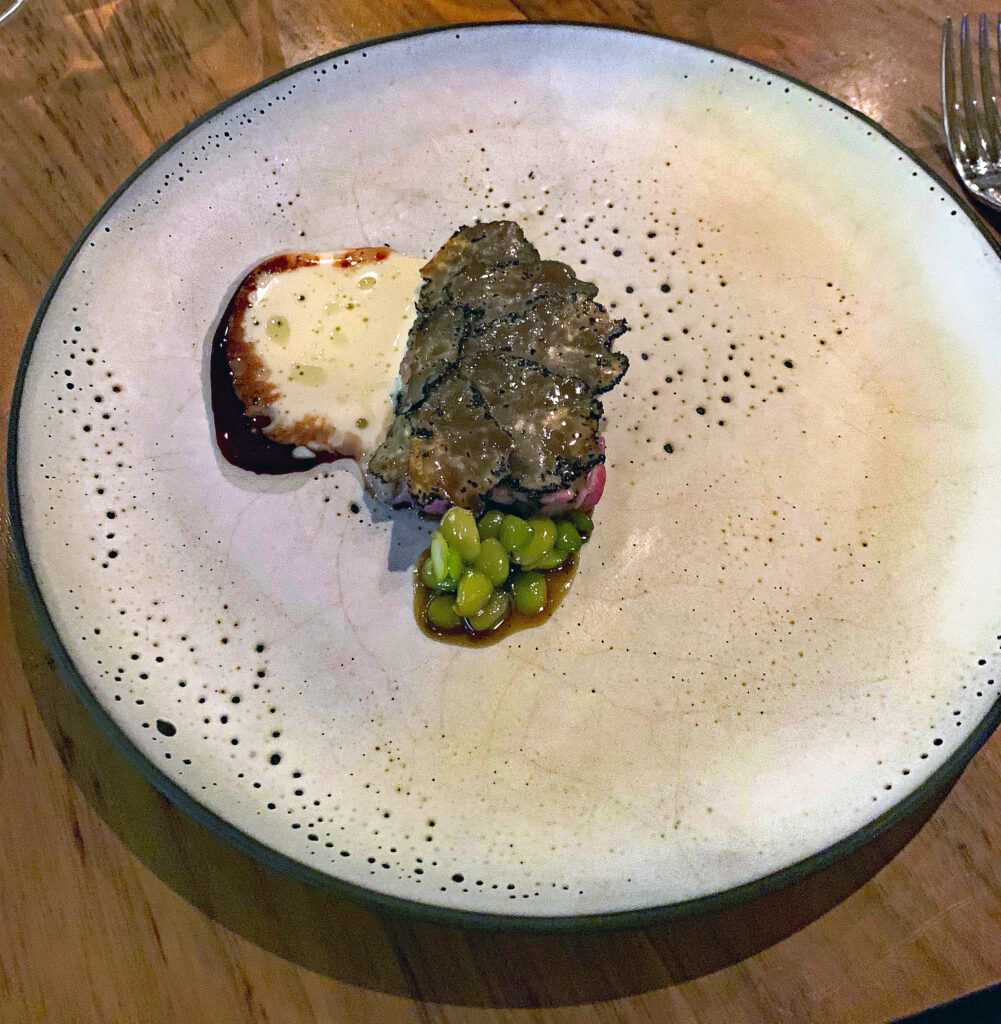
The second preparation of lamb, which has established itself as a fixture across several tasting menus through the present day, revolves around “aged lamb.” Though the exact cut is not clear, the meat arrives as a small-sized loin that surpasses the typical chop. This lamb anchors the plate as a steak would, and it makes for a far more direct presentation of the ingredient than the flatbread “set.” Aging a meat whose ordinary flavor some already find polarizing is surely bold. It represents yet one more “doubling down” by Shields on the aspect of an ingredient you might term “characterful.” And, as always, the wholehearted embrace of distinct, delineated flavors inevitably empowers a creative supporting cast.
The “aged lamb” has been paired with accompanying elements such as spring garlic and kombu, braised kelp, and fermented black truffle, new potatoes, and rosehip. These configurations, though distinct, reflect some of the same principles. The braised kelp, kombu (also, of course, kelp), and fermented truffle all amount to umami boosters, a doubling down on the aging’s own doubling down. As always, this has the added benefit of extending the satisfaction one takes from a smaller portion. The spring garlic and rosehip, by comparison, work to counter that sense of richness with their respective piquancies. And the new potatoes—processed into a purée—absorb some of that richness with a creamy, buttery quality that stands toe-to-toe with the intensity of the lamb.
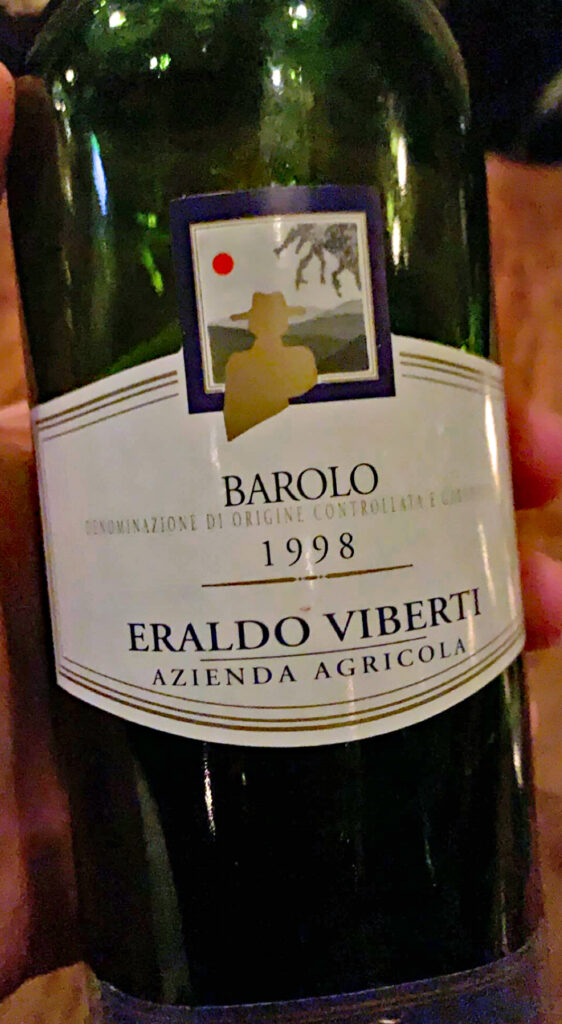
All in all, the “aged lamb” preparations offer guests an onslaught of flavor to close out the savory portion of the meal. Shields still, certainly, achieves a sense a balance. You are not overwhelmed by the power with which the meat expresses its essential “lamb-y” flavor, but, rather, struck by its sense of clarity. It possesses a slight chew that—through slow cooking and the aging process—quickly yields to a mouthfilling texture. There, the heightened sense of umami the chef unleashes through the dish’s garnishes takes root. The palate is smacked by a concentration of carnivorous pleasure. And is it any surprise that past wine pairings like a 1998 Eraldo Viberti Barolo or a 1999 Flaccianello offer plenty of tannin—and perhaps even an “animal” quality—to match? If the squab course—as the principle protein of the meal—seemed a bit delicate, the lamb—in just the way you wished for—undoubtedly delivers.
As a coda to this submergence (a “deep dive” if there ever was one) into the savory portion of Smyth’s tasting menu, you think now is the best time to dwell on an aforementioned and most magnificent creation.
While many of the restaurant’s signatures undergo tiny tweaks from meal to meal—a changing of the “window dressing,” so to speak, that leaves the dish’s fundamental structure the same—this hallowed offering has proven entirely resilient. And this is all the more impressive given that the gem of which you speak is nothing like fixtures such as the dainty “sea lettuce cookie” or its accompanying black walnut (whose appeal is more thematic than filling). It even surpasses the shima aji sequence—with its myriad forms—in terms of utter timelessness. For this bite appears at the same point, presented in the same unmistakable way, to consciously provoke memories of your last meeting. To prompt that tiny voice in the back of your head to wonder, “was it really that good?”
You speak of something—served alongside the squab, the lamb, or whatever principle protein corresponds to a given guest’s menu—substantial. You speak of something that may be called the best in its class, “the best ever” in such a cutthroat domain as the art of breadmaking. And, is it any surprise that—at this point in the meal—John Shields takes his bow and entrusts care of his guests to Karen?
You speak, of course, of Smyth’s brioche doughnut: the crown jewel of all Chicago bread services and, bite for bite, the very best singular expression of dough offered in the United States.
What can it really be compared to? You love the elaborate bread baskets served at such esteemed establishments as Daniel, Le Bernardin, Per Se, and Bouley. Yes, staring at the five or six or seven loaves on offer and declaring “I’ll have them all!” delivers you unerringly to hog heaven. But can any individual creation from those overflowing baskets dare compete? No, you must declare, for the essential variety of the selections suppresses any chance of offering a singular, extraordinary loaf.
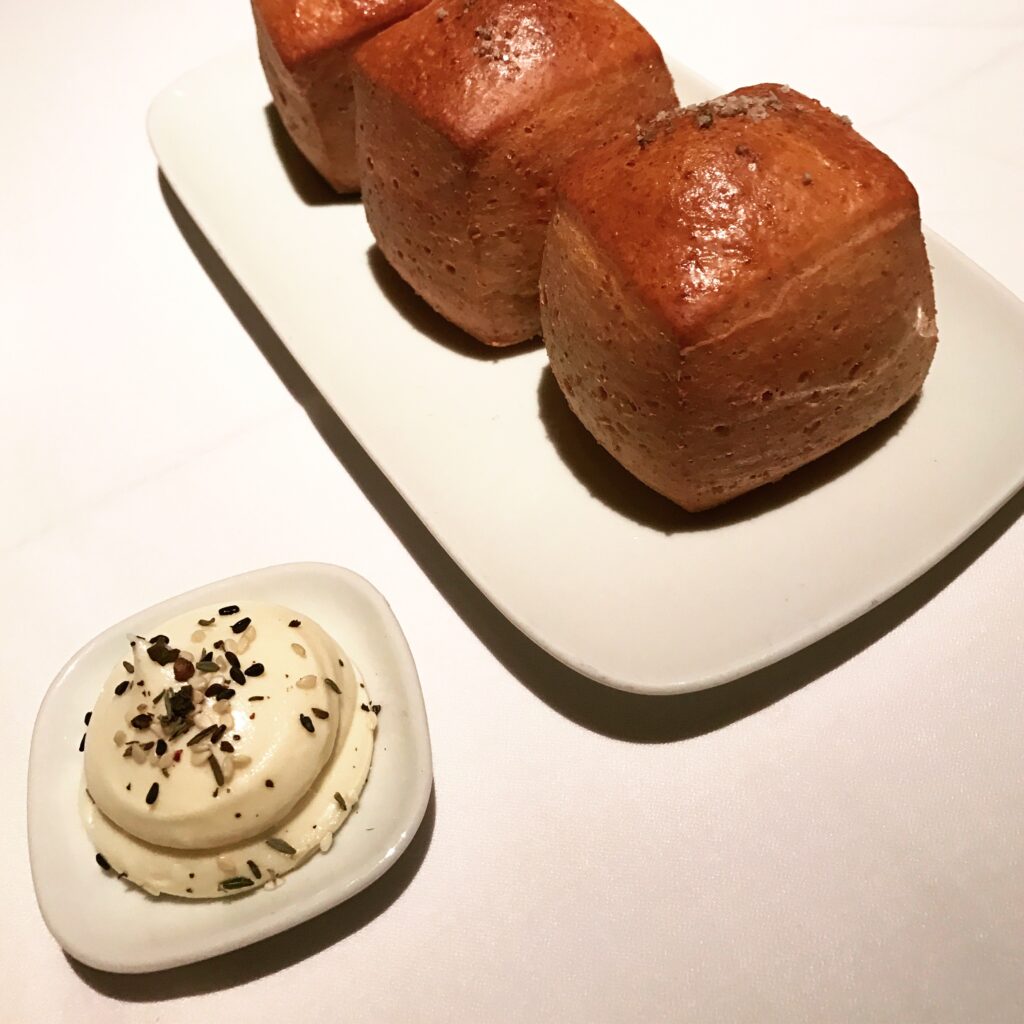
Instead, perhaps, your mind wanders to Eleven Madison Park’s laminated (there’s that word again!) butter rolls. They arrive warmly tucked into their canvas blankets, combining an impossible crispness with an ethereal lightness. And yes, the kitchen will happily bring you another round upon request.
You must also consider a most wonderful oddball, the fresh baked pizza dough served at two Michelin star Blanca in Brooklyn (the restaurant being nestled, of course, on the grounds of the famous Roberta’s pizzeria). The humble round of crust—sans cheese or sauce—served to guests has no business being so impressive. Yet, perfectly charred, served piping hot, and smeared with salted butter, chef Carlo Mirarchi’s take on the bread course has long formed a benchmark. But, while these two examples—as individual expressions of leaven goodness—come a bit closer to the prize, they simply cannot hold a candle to Karen Urie Shields’s brioche doughnut.
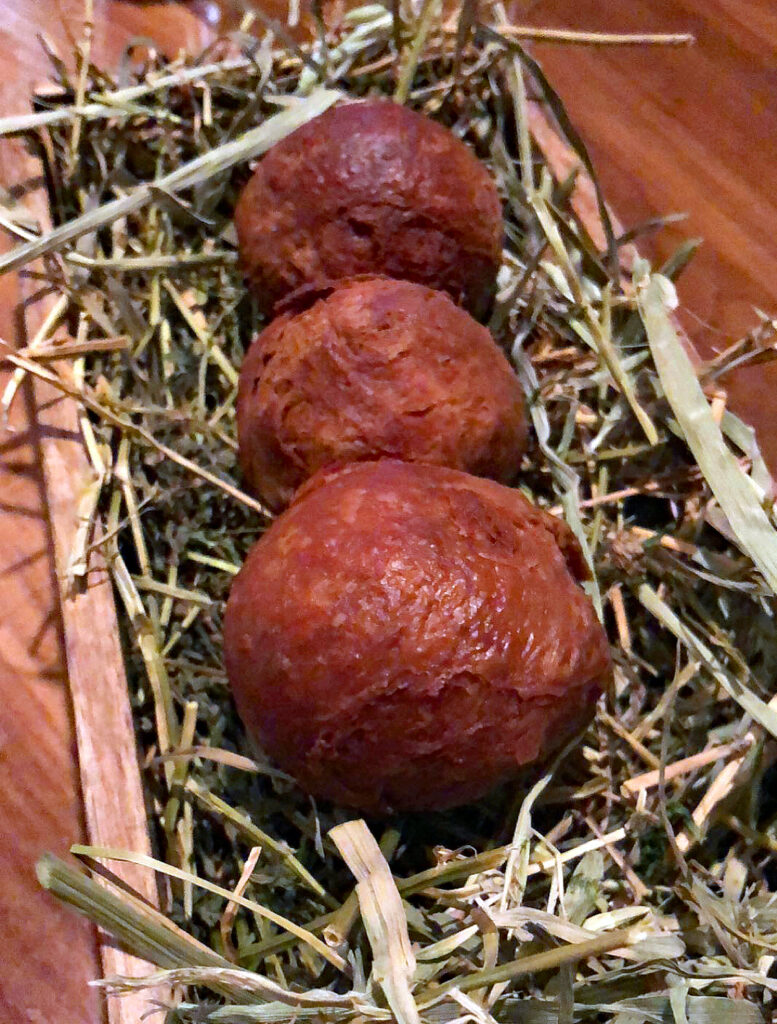
That bread, which appears much like a bun at first glance, arrives alongside Smyth’s entrée resting on its own bed of hay. The donut’s outer crust displays an attractive shade of dark brown—without a single trace of black—and a smooth sheen that speaks to the heft of the flaky layer that has formed. Grasping the brioche greedily, your fingertips revel in its pleasing warmth. And yet—how light, how soft you find it. This is not “old fashioned” cake donut, but an exploration in subtlety of texture.
You see, that outer crust is hard enough to hold its form in your hand and, later, to pleasingly crumble against the weight of your palate. But the donut’s interior possesses no further crispness or chew. That inner crumb is a sort of soft, sweet cloud—the stuff dreams are made of. Following the crust, the bread’s interior dissolves in the blink of an eye, striking the tongue with the slightest tinge of sweetness that makes the donut pleasing enough to eat on its own.
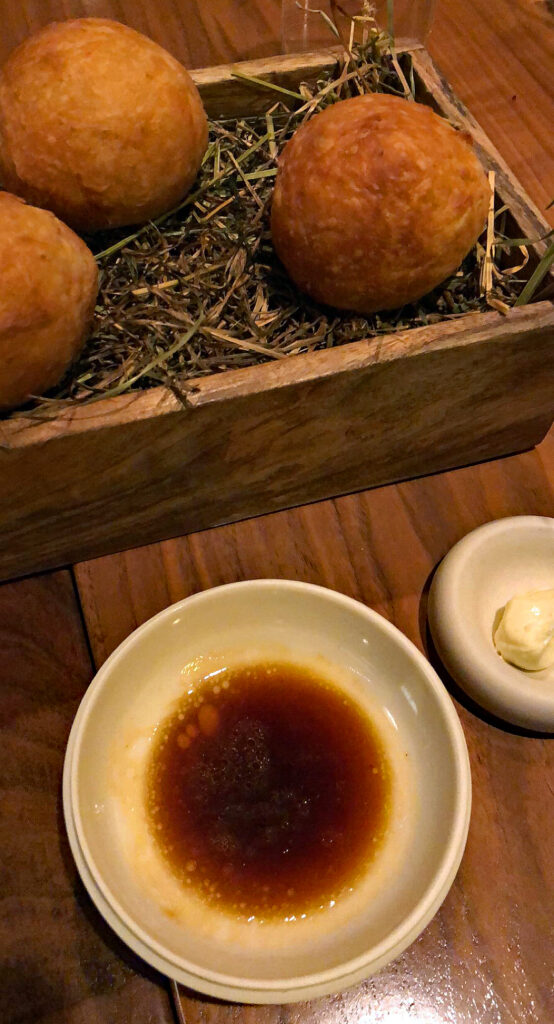
But, while you certainly haven’t been able to stop yourself from doing so at times, that would be a shame. For the brioche doughnut is invariably served with a dipping sauce of aged beef jus, and that accompanying flavor sends the creation into the stratosphere. All the lightness found in the bread’s interior suddenly transforms into a delivery system for the most intensely “beefy” flavor imaginable. The crispness of the donut’s crust, then, yields to a dripping dipped-Italian-beef sensation that marries the brioche’s latent sweetness with a powerful dose of salty fat. It’s a stunning maneuver, unquestionably on the savory side but so close to being a dessert that it reveals a characteristic of the beef that is hitherto unknown.
In the same manner that the lamb worked to supplement the satisfaction guests derive from the squab, Smyth’s brioche doughnut forms more than a “bread course.” Consider, particularly, that some of the guests receiving the item will not be indulging in the beef ribeye or beef tongue served on the “Classic” and “Smyth” menus. The donut, for guests indulging in the “Omaha” experience, becomes, then, a lone vehicle for flavors of beef that will not be appearing in any accompanying dish. And, to that extent, it absolutely succeeds.
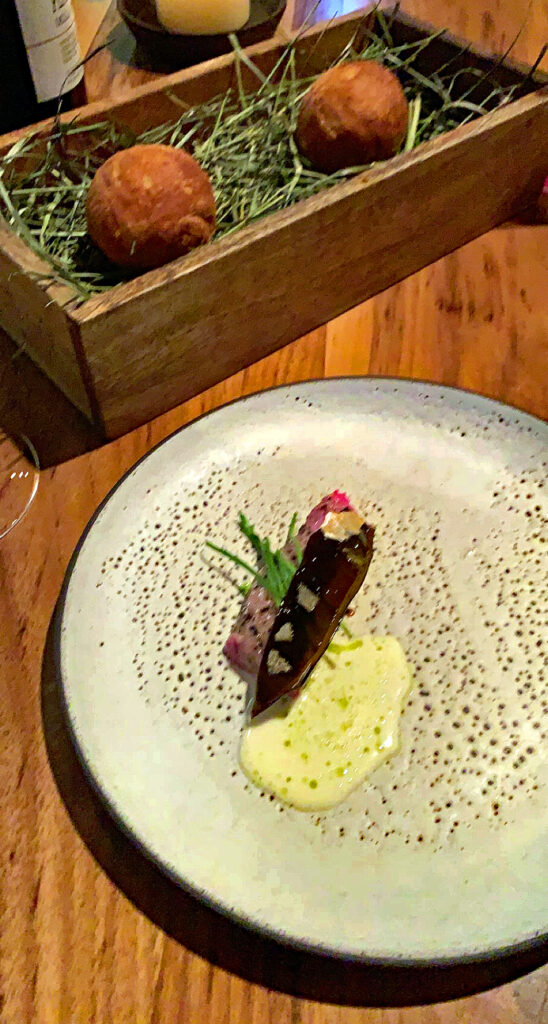
Yes, the bread’s texture is marvelous in its own right, yet the decision to flavor it so powerfully (via the jus) transforms the donut into an expression of beef and not just bread. It amounts, in that manner, to an additional “savory course” in terms of the satisfaction yielded—not to mention one of the rare occasions where a provided dipping sauce truly partners its bread to form something greater than the sum of its parts. And, it goes without saying, the notion of a savory brioche doughnut is simply fun. It offers direct, hedonist pleasure with the utmost precision and unerring technique. It’s just one of those items that is guaranteed to put smiles on the faces of everyone at the table, and—thus—it is a testament to Smyth that the restaurant, on this occasion, aims so squarely and consistency to please. Plenty of places rely on a strong bread service to “smooth over the cracks,” but how many can truly say it forms the “cherry on top”?
Dessert at Smyth, in your mind, must always begin with chocolate. But, as you might expect if you have made it this far, the bite in question is far from any ordinary bonbon. The savory portion of the meal—under John Shields’s command—attains higher and higher expressions of umami until topping out with the trio of squab, lamb, and brioche doughnut. While the latter item—as designed by Karen Urie Shields—treads the line between savory and sweet, one cannot just up and serve the real sweet stuff right away. Some kind of denouement is demanded, and chocolate—that most cherished, most decadent of sweetened delights—doesn’t seem to fit the bill. Chocolate is a “closing” flavor and not a transitional one, right? Certainly, no pastry chef would jar guests’ palates with a candy bar while they’re still licking their lips clean of any residual aged beef fat jus.
Yet Karen, as if it could ever be doubted, continues the genius sort of flavor bending plied by her husband thus far. As at Town House and Riverstead, her work refines and completes the work done on the savory side of the menu through combinations of ingredients that are often just as shocking. Just the same, they are sure to please, making Smyth one of those rare restaurants where dessert embodies a real continuity of the philosophy seen through the preceding chapters of the tasting menu.
The pleasure yielded, as before, will be immense, but patrons must remain ready to think through and engage with creations that push the boundaries of “pastry” beyond the relative safety seen at many a Michelin-rated restaurant. This is where the Shieldses’ partnership really shines, transcending the usual dynamic wherein a pastry chef works only to soothe palates recovering from the ride they have taken. Instead, in a manner that must be called kindred, Karen continues to up the ante—ensuring that the meal closes with a series of sweeter dishes that are every bit as memorable and enlightening as any served before them.
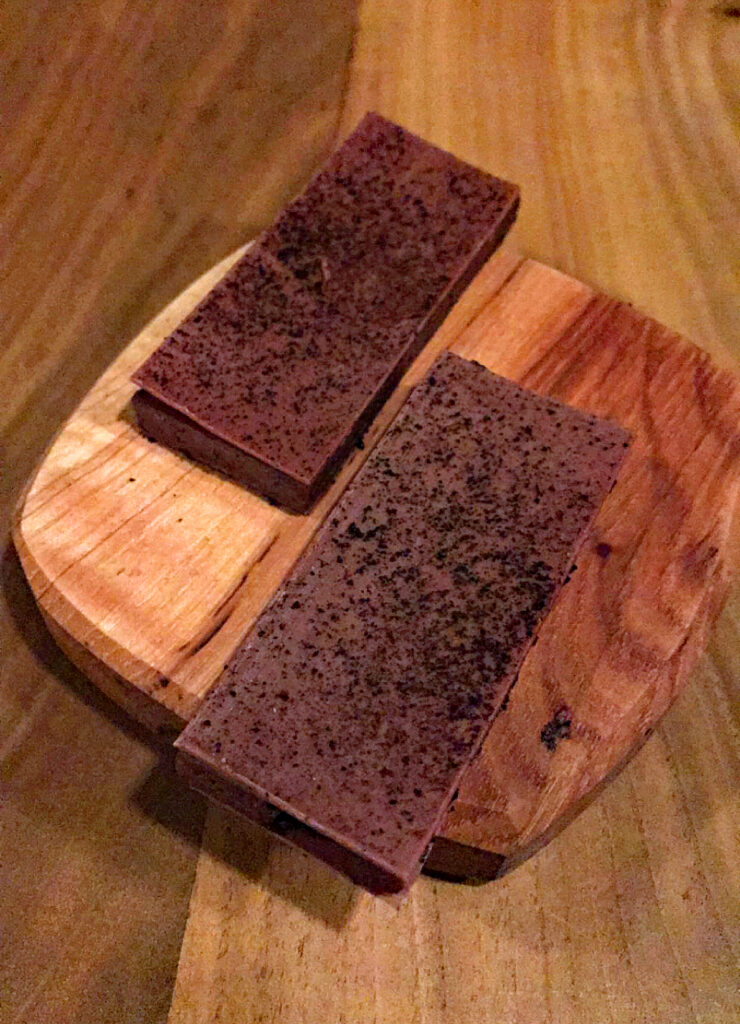
Which brings us back to the idea of chocolate, the first salvo fired in the menu’s closing campaign. The bite of which you speak, in many ways, is Smyth’s creation of all creations. You may not rhapsodize on it with the same fervor as Urie Shields’s brioche doughnut, but there can be no doubt that it has proven to be the restaurant’s stalwart. Yes, it simply has always been served. For even the “sea lettuce cookie” and black walnut amuse-bouches were phased out on a few of the most recent menus, as was the shima aji sequence (in favor of the king crab trio). Even your most beloved brioche doughnut—you hate to say it—has here and there been sacrificed in favor of the johnny cakes, the flatbread, and even a take on sourdough. (But, don’t worry, Smyth has always endeavored to keep the donut on its shorter menus, so it may still be delivered upon request).
This chocolate bite’s staying power has something to do with the perfection of its flavor combination, as well as its manner of referencing the umami notes that characterize the preceding savory courses. Thus, just as the brioche doughnut was a bit sweet, this chocolate is a bit savory—and so it gently leads patrons towards the other desserts to come.
The chocolate displays a thin, rectangular form that is only slightly bigger than a standard Hershey’s “pip” (the company’s name for the breakable sections of their bars). Smyth’s bar, much like Hershey’s standard bearer, is made from milk chocolate. It’s a decision that privileges the immediate pleasure of a familiar, nostalgic flavor over the endless complexity of darker cacao blends. But that is not to say that the bite is in any way simple. The milk chocolate forms two gossamer-thin strips between which a thick filling made from raspberry preserves, kelp, shiitake mushroom, and more milk chocolate is placed. This form is flush, smoothed, and altogether compact so that it has some of the feel of an actual candy bar. A further dusting of powdered shiitake forms an attractive finish on the top strip of chocolate.

The bite typically arrives as part of a pair—one piece for each diner—resting on small wooden blocks that match the grain of the table itself. The edge of the “chocolate bar” just barely juts off of the end of the block, inviting guests to grab it with little risk of shattering the outer layers. Grasping the rectangular sweet and bringing it in for a nibble, you are struck by its delicacy. The sheets of chocolate shatter cleanly, meaning that—once the bite hits your palate—they yield pleasantly to the filling within. The combination of tart raspberry, vegetal kelp, and earthy mushroom—processed into a texture not unlike a ganache—fills your mouth while standing toe-to-toe with the milk chocolate’s more familiar flavor.
The end result is shockingly similar to the luxury chocolate bars crafted by chefs like Eric Ripert and Thomas Keller, but with the complicating notes being drawn from the filling rather than mixed into the cacao blend itself. The bitter notes, typical of darker chocolates, are missing—but to great benefit in this case. The resonant flavor is of the shiitake, followed by the added umami of the kelp and the twist of tartness and sweetness that carry the bite through to the end. In this way, the “chocolate bar” starts off highly savory and only finishes with the luscious twang of raspberry and chocolate as the all-encompassing mouthfeel of the mushroom subsides. In truth, it’s the perfect kiss of sweetness that gently shepherds the tongue from the depths of meaty goodness towards the desserts to come.
The subtlety of Urie Shields’s “chocolate bar” serves not only as a transition but, also, as a reset. Her subsequent offerings do not immediately aim at deeper expressions of sweetness than the milk chocolate. Instead, they embrace cleansing, refreshing notes that amount to a new beginning from which the pastry chef may later, yet again, careen towards more decadent flavors. You particularly enjoy the nature of this movement: obscuring a hint of chocolate under a blanket of umami only to return to the same note—no holds barred—later down the line. This meta-menu continuity may not quite qualify as a “sequence” (of the same order of the shima aji or king crab), but it weaves a thread throughout the meal that makes for a rather cohesive culinary expression.
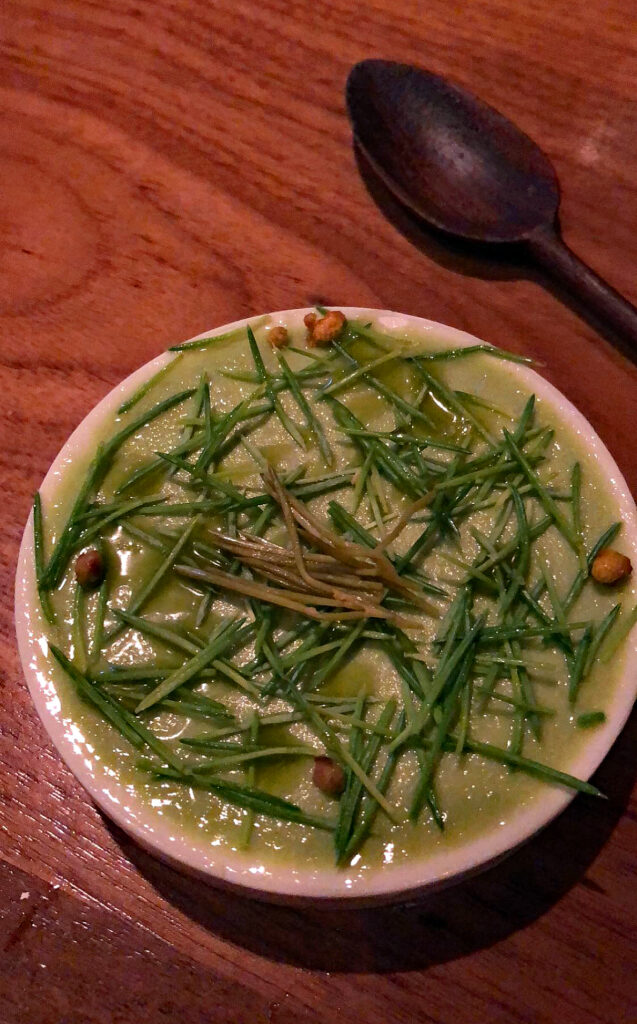
Dessert proper, thus, typically begins with something light. Like a sorbet made from hay and sorrel that is garnished with The Farm’s own honey and a topping of “conifer” (which, in this case refers to a heap of pine needles and a couple pea-sized pine cones). Wait, pine needles? Pine cones?! Surely, many diners are surprised to learn that these portions of the conifer are edible, let alone desirable or worthy of showcase at a fine dining level. But their presence is a testament, yet again, to Urie Shields’s embodiment and continuation of Smyth’s boundary-pushing philosophy. Desserts are meant to challenge, not simply to please (let alone to play it safe for the sake of redeeming faulty savory dishes). And please this unconventional combination certainly does.
While the hay undergirds the sorbet with mildly grassy, earthy notes, the sorrel serves to enliven the frozen ice with more pleasing tart, tangy, and sour flavors reminiscent of green apple or lemon. This interplay between the hay and sorrel—buffered by way of The Farm’s honey, which serves to round out any hard edges—forms the heart of the dish. The combination, in this form, could be served alone as an intriguing “palate cleanser” or perhaps even an intermezzo somewhere within the preceding savory section. However, the addition of conifer adds a forager’s touch that is both beautiful and clever. It transforms the dish into something of a natural “sundae”—with the needles of pine strewn over the top like so many green sprinkles. The needles bolster the dessert with their crisp texture and minty, fresh flavor that adds yet one more dimension to the “green” notes of the hay and sorrel. The tiny conifer cones, meanwhile, provide a more powerful crunchy element along with a mild nuttiness. These contrasting textural notes—along with their complementary flavors—elevate the sorbet into the kind of stupefying combination that simply works.
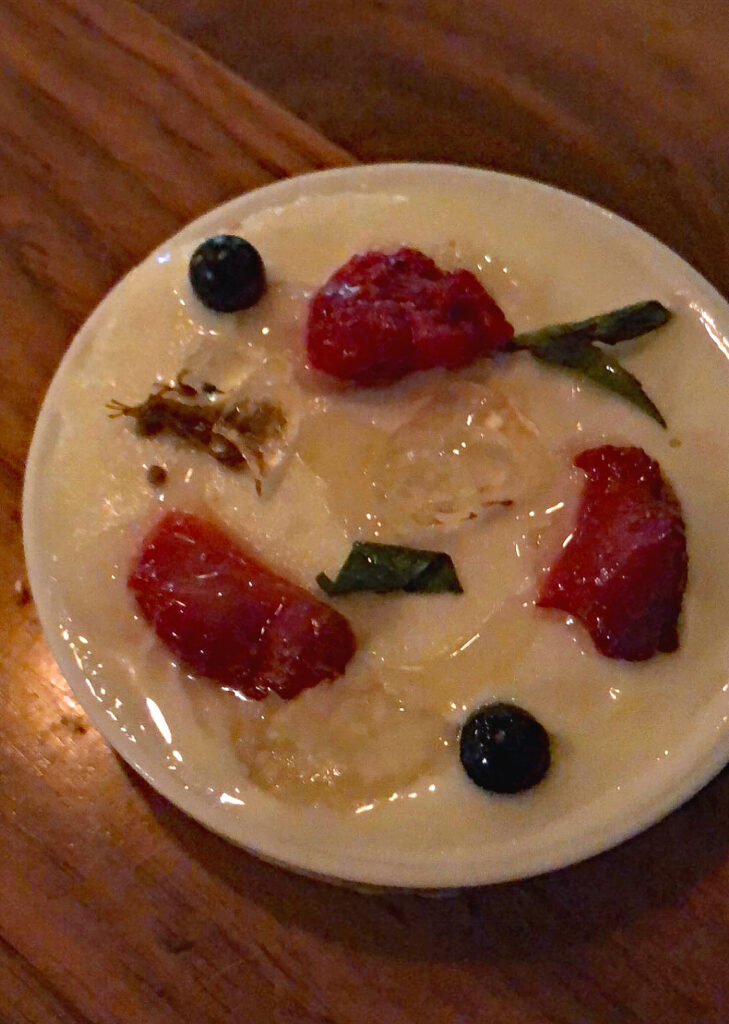
A later dish on the menu—titled milk sorbet with The Farm summer preserves—takes a more orthodox approach towards achieving the same cleansing sensation. In this case, flavoring the ice with milk (which technically changes the spelling from “sorbet” to “sherbet”) imparts a creamier mouthfeel along with mildly sweet dairy notes that are accented via a dash of salt. This frozen dessert lacks some of the intrigue of the hay-sorrel combination, but it forms a fitting canvas for the preserves—which may include raspberry, strawberry, and blueberry.
This fruit, which features a stewed texture and a deep, concentrated flavor, speaks—like so much guests witness at the restaurant—to the lifecycle of The Farm. That is to say, while Americans are fortunate to find any type of fruit at any time of year, Smyth’s cooking is rooted in making the most of their own products, in season, and saving what they can for later. Thus, while the pairing of sweet milk sorbet and berries might seem more basic than what Urie Shields did with the conifers, the dish deserves special credit for a minimalism that draws attention to the all-important craft of preservation. In this manner, the fruits can really be said to transport guests to The Farm at a past moment in time.
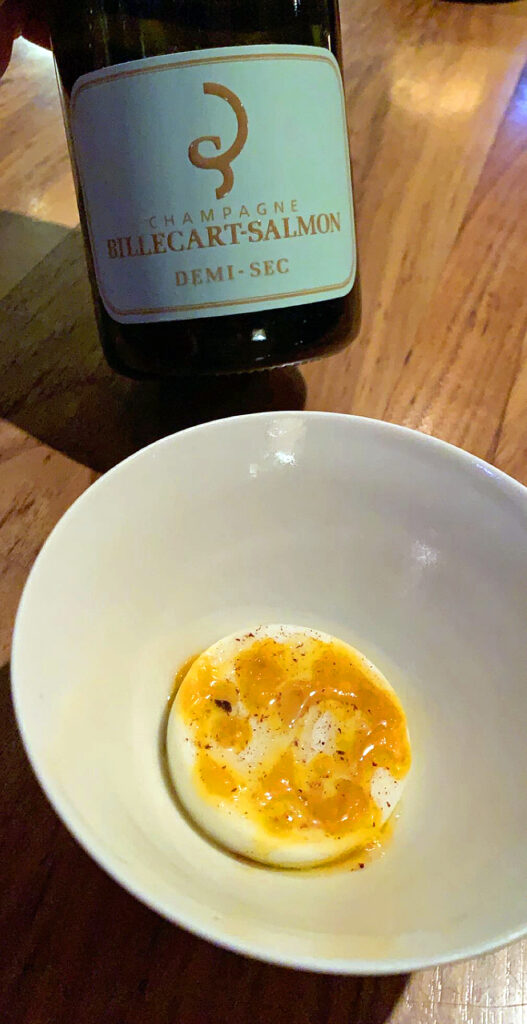
One more recent dish, which fills somewhat of the same role as these sorbet preparations, focuses—instead—on yogurt. That base of yogurt, perched simply at the bottom of a bowl, is dressed with a bright orange “sauce” made not from butterscotch, but coveted chanterelle mushrooms. A dusting of bee pollen possessing a dark red tint completes the presentation. Here, as with the milk sorbet, minimalism is the name of the game. The yogurt, itself, is tangy and sour, which serves as a perfect foil for the peppery, earthy, and apricot notes drawn from the chanterelles. Processing those mushrooms into a “sauce,” further, complements the yogurt’s smoothness while retaining some of the ingredient’s rich, umami mouthfeel. Finally, while the bee pollen has no bearing on the dish’s texture, it accents the other ingredients with a floral, slightly honeyed lift. The ultimate sensation is one of mild sweetness and impressive depth. By choosing a demi-sec champagne by Billecart-Salmon to pair with the dish, Smyth’s sommelier imparts an added element of residual sugar (from without) that allows the ingredients within to express themselves more clearly.
Following these cleansing sorbets—or, on some occasions, flowing directly from Urie Shields’s superb shiitake chocolate bar—the pastry chef serves what has become not only one of her signatures, but a signature of the restaurant and one of Chicago’s most eminent desserts spanning the past decade. Like so many of the establishment’s most wondrous creations, there’s a story involved. And it’s a rather simple one.
Back at Town House, during the period in which Urie Shields was pregnant and unable to cook, the torch of the pastry program was passed to John Shields. In that unusual role, he would cavalierly “dump” sugar on egg yolks when creating custards, upon which “the yolks would cure and begin to form a skin,” prompting him to “get yelled at” by his better half. Though unintended, the yolks’ intriguing texture prompted further investigation and inspired—all the way back in 2009—the creation of a “crude cured egg dessert in Chilhowie.”
Shields’s thinking was that the humble egg is “in every dessert,” so “why aren’t people showing it off?” (One senses, in this statement, an expression of the chef’s minimalist streak through which he crafts such a wide variety of savory dishes that regale guests with the purity of their flavors). In April of 2016, when the Shieldses partnership with The Farm’s Papineau family was in full swing, the chefs found themselves with “access to eggs that were worth showing off.” Urie Shields, back in the saddle, took flight with her husband’s idea of showcasing the egg. She combined the curing technique Shields had stumbled upon with the preserved black raspberries that were available during the spring. Starting from these two elements, Urie Shields achieved perfection, crafting an iconic dessert that still appears—and has even been remixed—on menus more than a decade after its original, hapless iteration.
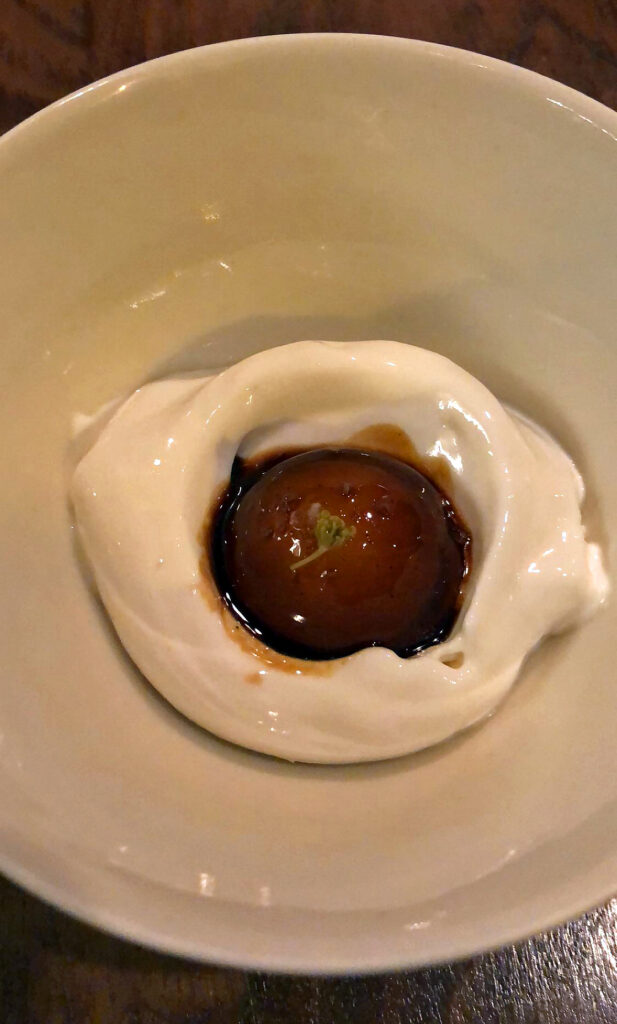
In the dessert’s classic form, Urie Shields cures the yolks of The Farm’s eggs with salted licorice for twenty-four hours. The eggs’ whites are combined with sugar to make a meringue, which is then blended with yogurt to add an element of sourness and a smooth dairy mouthfeel to the thickened protein. When it comes time to plate the dish, the cured yolk is placed atop the meringue-yogurt mixture. It is dressed with a vinegar made “by a friend from Virginia,” and berries—be they black raspberries or blueberries, be they fresh or preserved—are hidden at the bottom of the bowl. A small flower—placed at the very center of the egg yolk, itself at the center of the plating—provides an elegant final touch.
Plunging into the dish, you are immediately struck by the texture of the egg yolk. (Sensibly so, for it forms the raison d’être of applying the curing technique itself). The chewy exterior layer—flavored with salted licorice—comes to replicate a bite of licorice itself. Patrons are instructed to puncture the yolk and whip its custardy interior layer into the meringue-yogurt mix. This has the added benefit of circulating the vinegar topping and the fruit component lining the bottom of the bowl. Fully incorporated, a given bite might start with a sticky, chewy sensation then become smooth, rich, sour, tart, and sweet in turn. You are typically ambivalent about black licorice, but Urie Shields’s combination is so well balanced as to make a believer out of anyone.
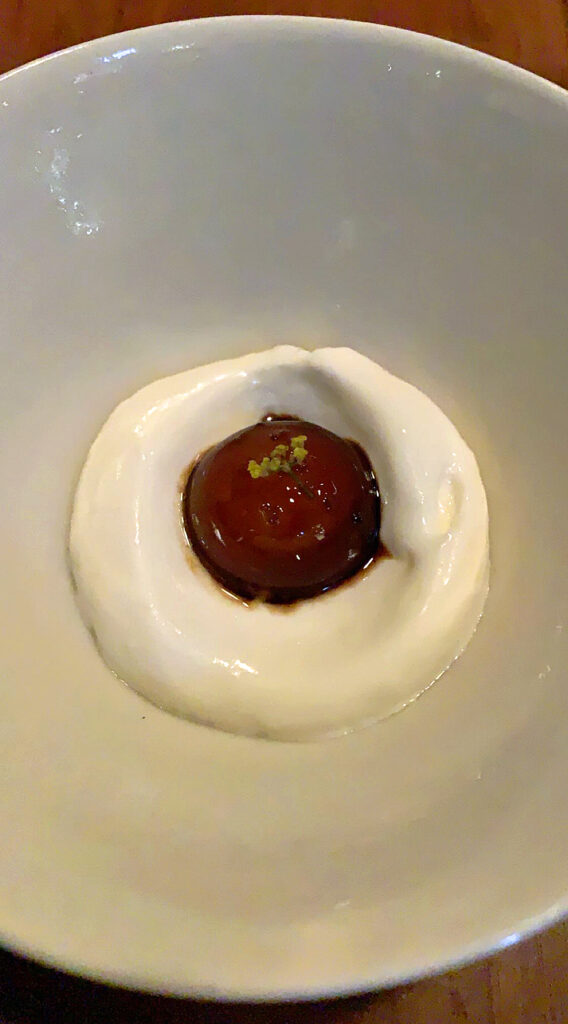
So, what came first, the squab or the egg? The Shieldses, surely, were serving the game bird at Town House before the latter preparation fortuitously took shape. Yet both dishes only realized their full potential at Smyth. The squab—outside of the enduring manner in which the meat is prepared—has been served in myriad compositions. In contrast, the licorice-cured egg yolk has retained a consistent—perhaps even timeless—form for nearly five years now. Sure, the fruit element may change from black raspberry to blueberry depending on the moment. But substituting one for the other does little to upset the Urie Shields’s fundamental balance of flavors and textures.
The dish, really, is something of a totem for the restaurant at this point, but the Shieldses—to their immense credit—certainly do not shy away from killing their “sacred cows.” Across your experiences, the licorice egg was reliably dropped from the “Omaha” menu to make way for new and exciting desserts. Of course, it would be safely stowed away on the shorter menus as a means of guaranteeing the pleasure of first-time guests. And it would reappear, from time to time, as a welcome dose of nostalgia set against the steady torrent of novel creations. But the success of one or many dishes has never stood in the way of Smyth’s growth.
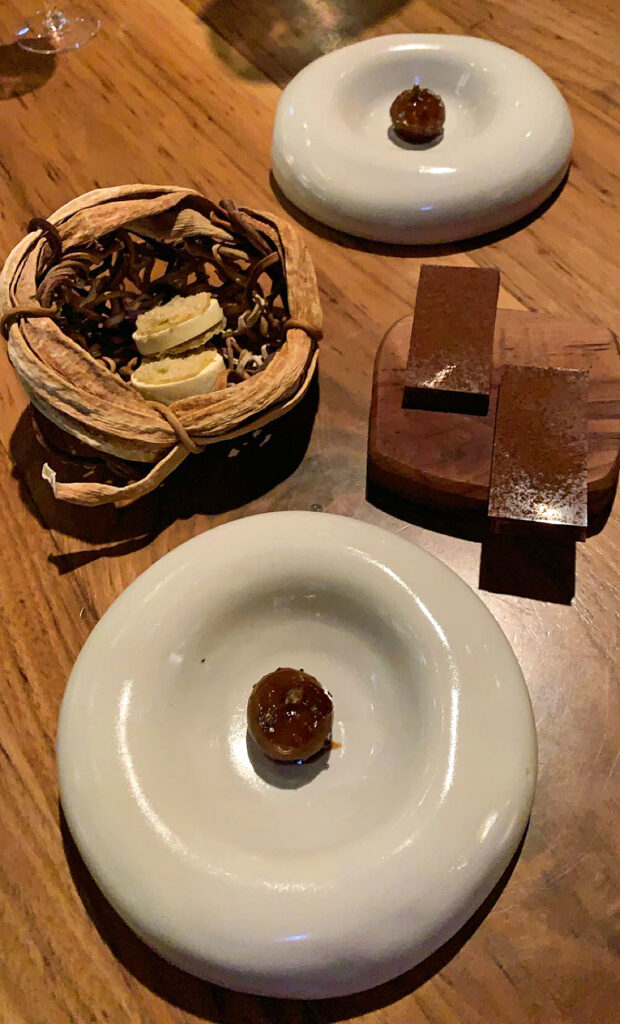
In fact, your very last meal there before the start of the pandemic featured a cured egg that—for the first time—had absconded its usual coating of yogurt and meringue. Dressed with nothing but a dash of that Virginian vinegar, it was served alongside the shiitake chocolate bar and a kombu ice cream sandwich as part of a closing trio of mignardises. Presented in this fashion—a lonely orb set within a shallow bowl—the yolk is more striking than ever. And, all the more, it fulfills Shields’s original intention of showcasing the egg’s inherent majesty with minimal obfuscation. This form presents a new chapter for a creation that is woven into the very fabric of the restaurant, allowing it to redefine the sweet side of the menu without abandoning the genius of the curing technique altogether.
During the peak of summer—when fresh fruit is at its finest—Urie Shields has composed desserts that, in their intelligence and intricacy, rival her husband’s most thought-provoking compositions. One such example appeared in two distinct forms across subsequent menus in late July and August. The first featured peaches; the second plums. And yet, the supporting cast of characters—a provocative bunch—remained the same.
Both fruits—each portioned into a couple small chunks—sit at the bottom of a shallow bowl. And each receives a simple garnish of roses (in the form of petals), kombu (in the form of cream), and blackcurrant wood—which has been broken open and confited to yield a flavored oil. While the former two ingredients should be familiar by now, Urie Shields’s use of the blackcurrant wood is quite interesting.
Blackcurrants themselves, of course, are small grape-sized berries that predominate in Europe after having been banned by U.S. authorities in the early 1900s as a means of protecting the country’s pine trees from a pernicious form of rot. In 2003, New York was the first state to overturn its ban as a result of lobbying. This has empowered small farmers to cultivate the berries throughout the Hudson Valley—as well as Connecticut, Oregon, and Washington too. Americans can hardly be blamed for lacking any reference point for the fruit; however, they may be surprised to hear how flavors of blackcurrant—also labeled cassis—abound in wines made from Cabernet Sauvignon. Unbeknownst to them, the tart, tannic notes of blackberry, gooseberry, earth, and rose gracing their favorite cult bottles from Napa actually reference one of the country’s “forgotten” ingredients.
Much like the peaches and plums they look to complement, blackcurrants reach their peak during summer. But Smyth is certainly not content with simply using the unique berries as “fruit” per se. It is the shrub’s wood that has caught the pastry chef’s eye—a particular part of a particular plant that, at first glance, appears to have no culinary use. But leave it to Nordic chefs—those shining lights of foraged, terroir-driven cuisine—to prove otherwise. Kristian Baumann—of noma’s 108 in Copenhagen—has utilized blackcurrant wood oil in a dessert of kombu ice cream with a cream of toasted barley. And Eric Vildgaard—of Copenhagen’s two Michelin Star Restaurant Jordnær—has paired the oil with nothing less than Beluga Sevruga caviar and a simple sauce made from white miso, milk, and cream.
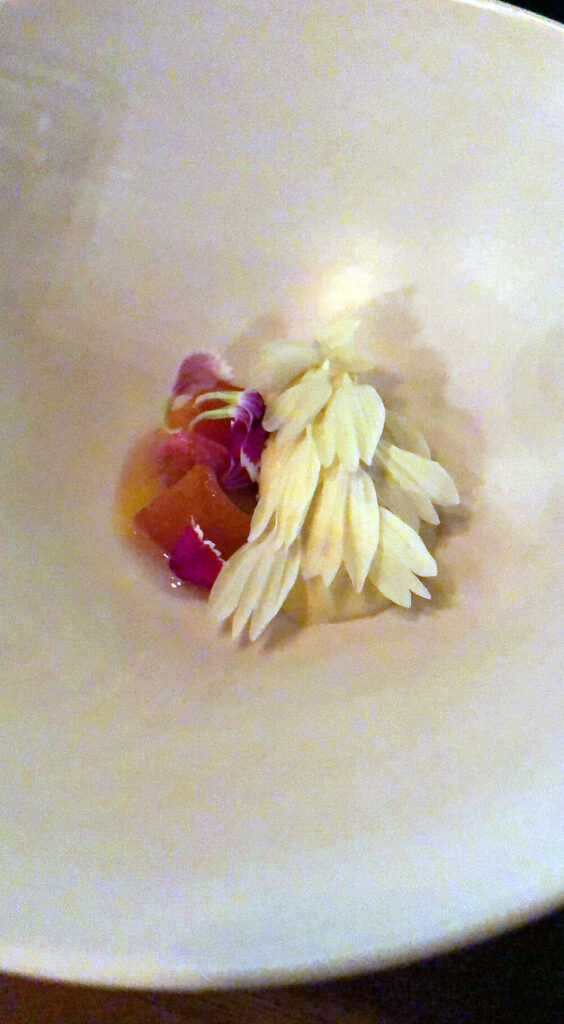
This is all to say—despite offering a combination of flavors that are seemingly opaque—Urie Shields’s peach and plum preparations are in good company. While the principle elements—served at their peak—impress with the purity and intensity of their characteristic flavor, the decision to opt for the blackcurrant’s wood rather than the berries ensures neither the peach nor plum will be overshadowed. Instead, the oil made from the wood imparts a restrained sense of “green” acidity—as well as a floral element—that avoids any of the darker, sappier flavors more reminiscent of cassis. In this manner, the blackcurrant wood works alongside the roses and the richness of the kombu cream (itself not at all unlike Baumann’s kombu ice cream and Vildgaard’s miso sauce) to provide mild, complementary accents to a dish that prizes the pristine essence of the peach or the plum above all else.
As in some of John Shields’s most notable savory creations, an altogether unfamiliar ingredient is introduced for the sake of developing captivating tertiary flavors. These notes—of seaweed, flowers, and the bark of a berry shrub itself—are not presented as ends in themselves. They surprise, they provoke, but only in service of some ultimate, legible goal. Urie Shields draws on these interesting flavors to deliver jewels of peach and plum that shine more brightly than ever before. She wields the blackcurrant wood wisely and imparts it precisely. And she manages to showcase her chosen fruit with the same masterly flourish, the same remarkable intelligence her husband might apply to a piece of seafood earlier in the meal. Few restaurants possess the talent or motivation to bridge the same philosophy across the savory and sweet portions of the menu in such a way. Doing so amounts to something of a declaration: a leveling influence that paints all ingredients—not to mention the pastry department itself—as proud equals. Brava!
There are times, though, where fruit need not be dressed to the nines. Where fruit—freed from the complexities of the fine dining oeuvre—can simply repose as “fruit.” Perhaps appreciating the peak of the season is no longer a concern, and that certain fruit has stewed in a jar of its own juices for a few months. Perhaps the name of the game is no longer purity but, rather, a kind of candied decadence that only rears its head in the depths of Chicago’s December.
Bosc pears—that classic bronze-colored variety with the elongated neck—ripen during early October in Illinois. The variety, which was brought to America from Europe in the early 1600s, is characterized by its firmer flesh and a juicy, honey-sweet flavor that can be appreciated earlier in its ripening process than other types like the Anjou or Bartlett. The Bosc’s density, additionally, lends the fruit an intensity of flavor when fully ripe: it can both hold its shape and its own when baked or poached and paired will all manner of autumn spices. For chefs who may think to make use of the pear well into the winter season, this hardiness has the added benefit of making the fruit well-suit for preservation. And that is exactly what Urie Shields set about doing.
It is December, and the deep chill that has set upon the city erases any sense that any fruit may have been hanging from the trees just a couple months ago. Smyth, of course, feels warm and toasty. The squash, lobster, beef tongue, and brioche doughnuts have put a fire in your belly. The licorice-cured egg yolk—with accompanying meringue-yogurt mixture—has served to put it out. But what else can the restaurant hope to offer from the native soil? What might possibly be pried from Mother Nature’s icy grip?
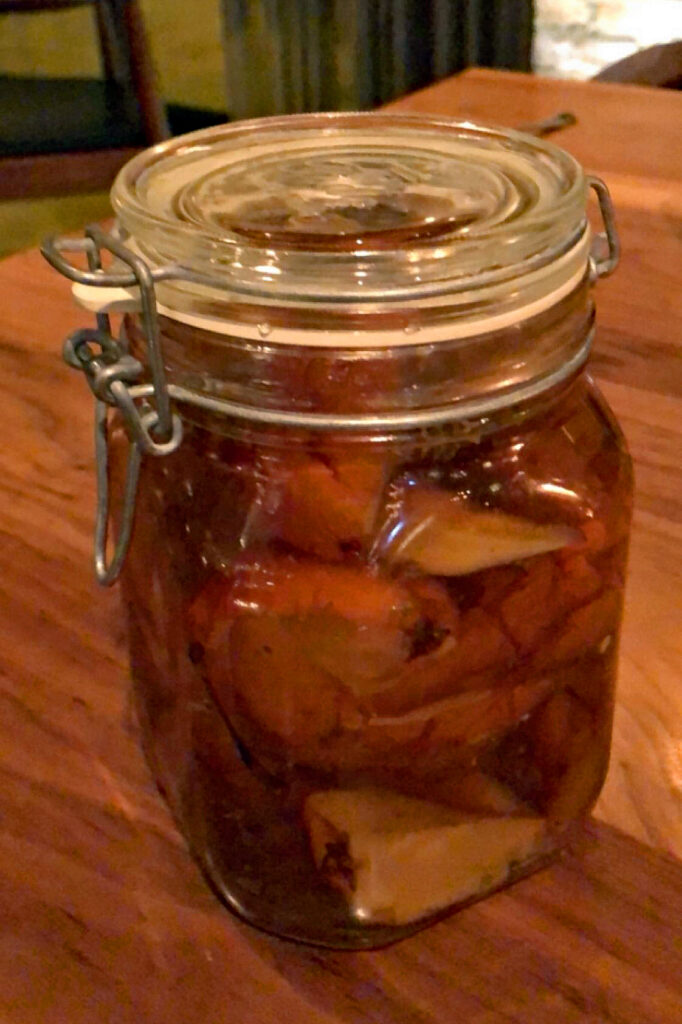
Suddenly, the Bosc pears arrive at the table preserved in a heaping pickle jar. Therein, the fruit has been sliced into large segments and allowed to stew in a sugar syrup—along with tufts of hay—for some period of time. Your server delicately removes one slice of pear from the jar for each customer at the table, depositing each—in turn—at the bottom of a small bowl. Rather than the bronze shade for which the fruit is known, the segments display more of a burnt orange—bordering on dark brown—tone. Moreover, the Bosc’s distinctly firm flesh looks positively sappy, attractively candied, or—in a word—luscious.
The pear is joined in its bowl by a scoop of hay ice cream and some drippings of quince nectar. (Why the quince? Well, pears grown in Illinois are actually grafted onto hardier quince rootstocks that can withstand the bacterial disease known as fireblight). The dish is finished with an accompanying slice of pound cake that has been buttered and toasted on both sides to achieve an impressive outer crust.
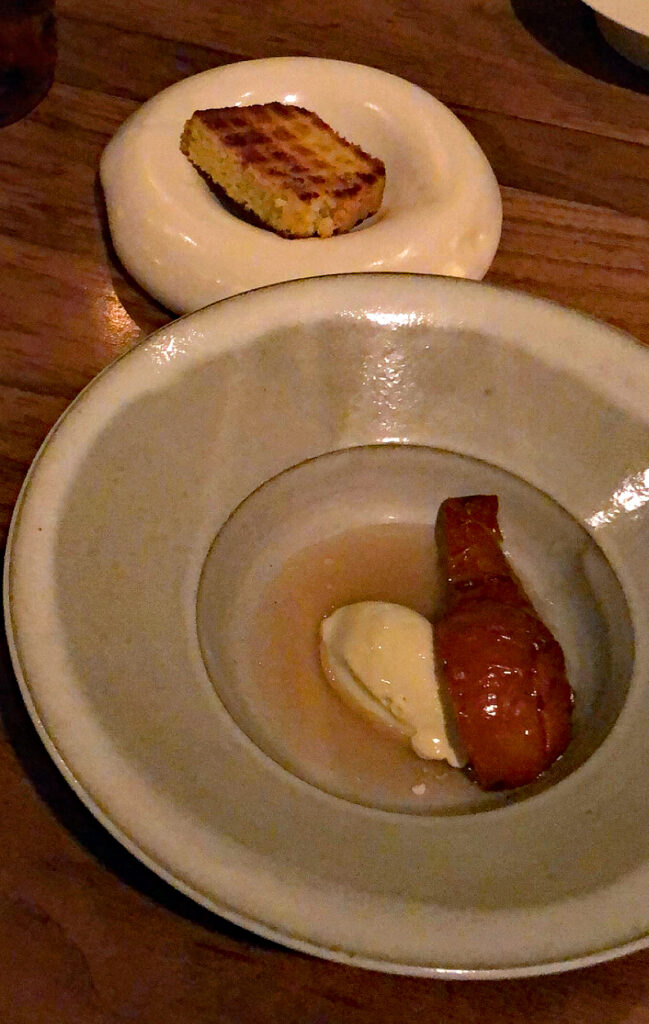
Digging in, you hardly know where to start. First, a sliver of the Bosc pear by itself: smooth, wet, honeyed, and floral by way of the preserve’s companionate hay with additional notes of cinnamon and nutmeg. The hay ice cream itself is principally a vehicle for flavors of sweetened cream, yet there’s a grassy note at play that prevents it from being too one-note. The quince nectar, meanwhile, imparts the bowl’s contents with a power dose of tartness, a wee bit of sweetness, and the wonderful contrasting mouthfeel that only syrup can provide to the contents of a “sundae.”
The interplay between the pear, the ice cream, and the quince—when they are eaten in turn or combined into the same bite—would be satisfying enough. But that unassuming slice of pound cake must have its say. Alone, it is impressively dense, delicately sweetened, delightfully crumbly, and characterized—most of all—by the crunch of the outer crust that lends the cake a charred note and, more importantly, a sense of structure. Thanks to the heft of that layer, guests are free to coat the pound cake with slices of the Bosc pear and dip it into the combined drippings of the ice cream and the quince. The crumb swells due to the additional infusions of sugary liquid and yields a complete bite that is tangy, creamy, green, stewed, and altogether elongated through the medium of the cake. Yes, it all looks deceptively simple, but the dish speaks principally to Smyth’s predilection for preserved ingredients and the deep pleasure that simple combinations—fine-tuned by masterly hands—can deliver.
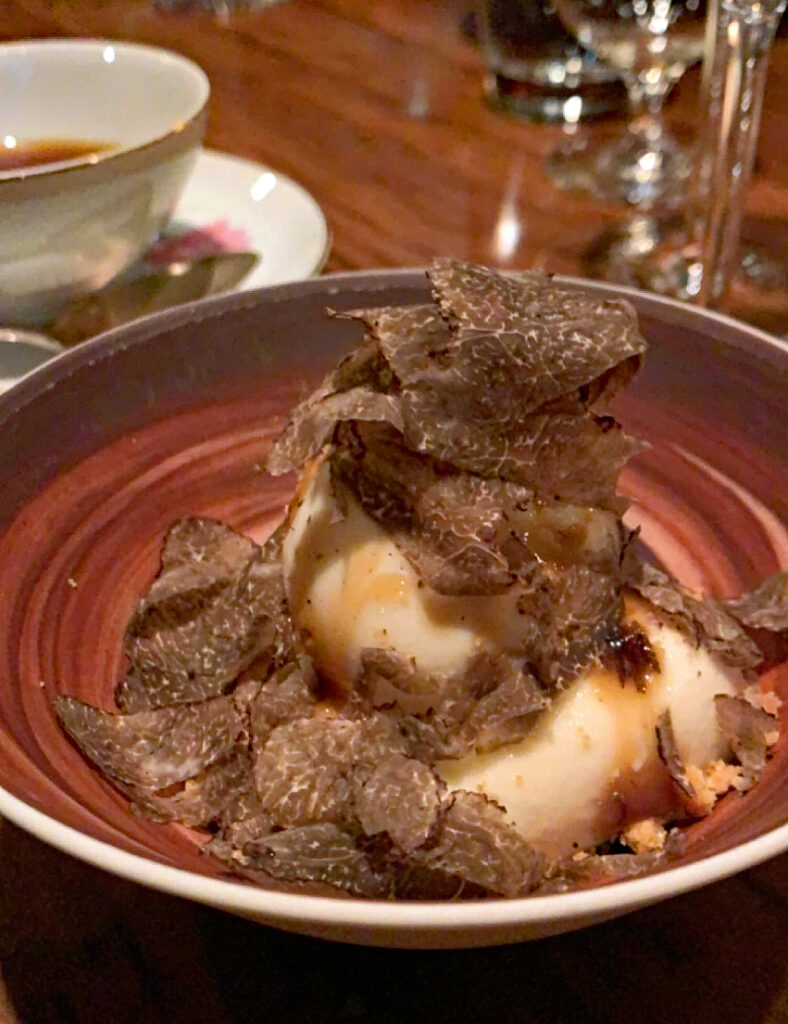
(Now, you think, might be the time to reference a one-off dessert in the same vein: vanilla ice cream with white truffle. Smyth served this treasure—the boldest, simplest usage of the very best type of truffle—on New Year’s Eve of 2019. There’s not much else that, in good faith, can be said. But the Shieldses’ sense of restraint, their desire to merely serve the most delicious food possible, should never be doubted—despite how utterly impressive their more intricate preparations are. What can be more special than letting the resounding flavor of those truffles unleash themselves against such a generous canvas? Why, such a dish seems to say, must truffles be so complicated? Why can they not simply yield pleasure? As much as you enjoy a shaving set atop risotto or tajarin, vanilla ice cream truly lets white truffles take center stage. Such a dessert provides untold space for the mushrooms’ haunting aroma and nuanced earthiness to strut their stuff. And only a chef of superb confidence and generosity would only dare serve that totem of all totemic ingredients in such an unostentatious way).
Before turning towards the final bites of Smyth’s menu, you would like to share an anecdote about Urie Shields that has stuck with you as emblematic both of her and, by extension, the restaurant’s very ethos itself. The year was 2017, and you were hardly the “regular” of the present day. Still, you had indulged in the extended “Omaha” menu a few times—supplemented by wine pairings—and, thus, found yourself seated in one of the dining room’s plush corner booths. While one of these booths is positioned opposite the kitchen—adjacent to the windows that form the restaurant’s façade—the other sits opposite that booth, abutting the counter of Smyth’s pastry kitchen.
As so often happens during extended tasting menus, your party of four found itself among the last of the guests in the building. You had just finished the savory portion of the meal—having imbibed plenty—and perched yourselves comfortably along the expanse that the booth’s curve offered. In scanning the dining room’s goings-on, one of your friends set upon a member of the staff who was scooping chocolate chip cookie dough onto trays destined for the oven. The sight of such a classic American indulgence piqued your friend’s interest: would they be served? Could they be served? Just who is going to eat several dozen baked cookies in a nearly-empty restaurant that late at night?
With all the usual pomp that a detestable “foodie” might muster, you explained that these chocolate chip cookies must be destined for the Smyth staff’s “family meal” the following day. Intoxicated by the opportunity to trot out that trite “insider knowledge,” you beckoned the party to turn their attention away from the pastry kitchen. For the employee—whom you now know was Urie Shields—preparing the cookies stood only a few feet away on the other side of the shared counter. And then, as now, you endeavored to treat the back of house staff as more than mere zoo animals: paying respect to their hard work by minimizing any disturbance your attention may cause.
You thought that was that—and the moment had passed. But not before the enraptured friend announced something to the effect of “oh, I would love a chocolate chip cookie!” “Oh, how gauche,” you thought to yourself. Was she really speaking to your table or to “someone” else she hoped might hear? Cringing, you averted your eyes from the pastry kitchen and took refuge in a glass of wine.
The first few courses of dessert followed without further incident. You felt you had slipped the noose: that your friend’s unseemly outburst had gone unnoticed, that no manner of polite refusal of the request would be necessary. Finally, you reached Smyth’s closing service of petit fours—the very same point you, dear reader, have reached in your own respective narrative. Out came the macarons, the black carrot licorice, and those signature canelés. They were followed closely, of course, by a plate of fresh-baked chocolate chip cookies. Yes, they were rather thin—the only way the cookies could be prepared in sync with the meal—but beautifully crisped and characterized by a combination of salt and chocolate that struck you with its intensity. Though this might be the context speaking, they could very well have been the best example of the form you can remember tasting.
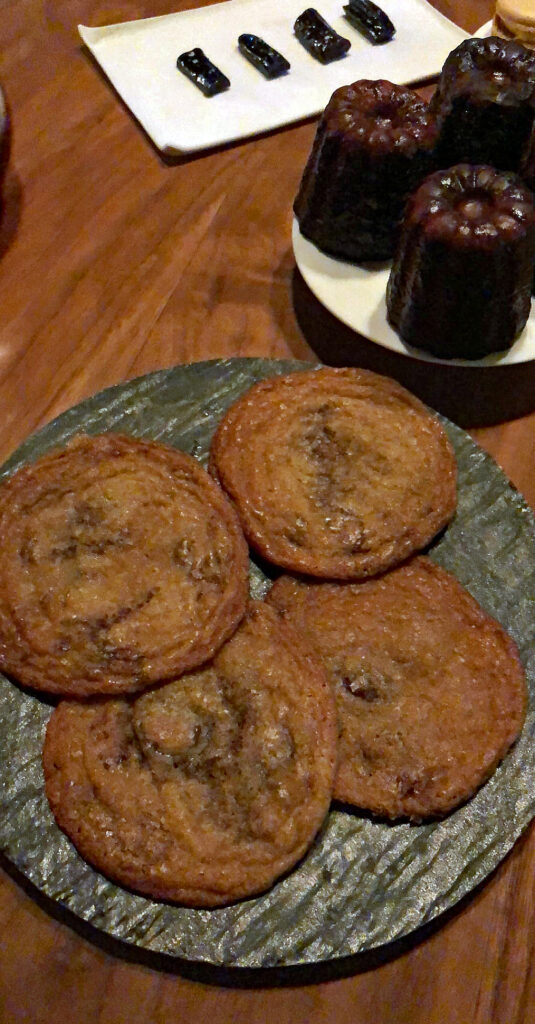
While you give Smyth immense credit for allowing its legendary Loyalist burgers to satiate appetites upstairs, the circumstances surrounding those cookies are exceptional. Though simple, they were certainly not a menu item. Urie Shields was certainly no longer “on the clock,” and no sort of formal request or appeal was made to divert the family meal’s resources towards some (already well-fed) guests. Your friend’s comment could have easily been ignored—you feel bad for initially having wished it was. At the very least, some cookies may have appeared as part of a take-home treat. But no, Urie Shields spied an opportunity and kicked into action. She incorporated the superfluous request into the very flow of the meal, and allowed those cookies to drop on the table like a hospitality atom bomb.
If the gesture seemed understated, it is only because it was entirely, utterly natural. For Smyth does not acknowledge an “on” or “off the clock.” Just as your mother or grandmother does not wipe their hands of your care at a certain hour of the day. Guests are at home so long as they are situated within the restaurant’s four walls. Anything and everything that might make them happy offers not the slightest imposition. Because service at Smyth is not a delineated, craven exchange but a coming together of kindred spirits, the formation of a “restaurant family” in the spirit of humble devotion, eternal presence, and complete appreciation.
Just as the sea lettuce cookie and black walnut bites ushered in the start of the meal, Smyth has struck upon a few signature creations that end the meal with their characteristic blend of technical expertise and farm flavor. Bookending the sea lettuce cookie in particular is the seaweed caramel tart, a gossamer-thin pastry shell filled with a supremely sticky filling and circumscribed by a garland of crispy, flaky sea lettuce.
Of course, there is an implicit beauty in ending the meal—in some sense—where you began. And the tart, just like the opening cookie, is defined by its textural experience. While the latter’s lettuces added a green flavor and leafy mouthfeel to the crumbly, cream-coated cookie, the tart is characterized by a firmer chew. Guests crunch through the delicate shell and find themselves masticating a rather boldly thickened caramel, unto which the crisped seaweed flakes add a nice bit of relief. Crumbly, chewy, and crisp—thus is the combination, and the seaweed has the added benefit of “salting” the caramel with a touch of its saline, umami quality.
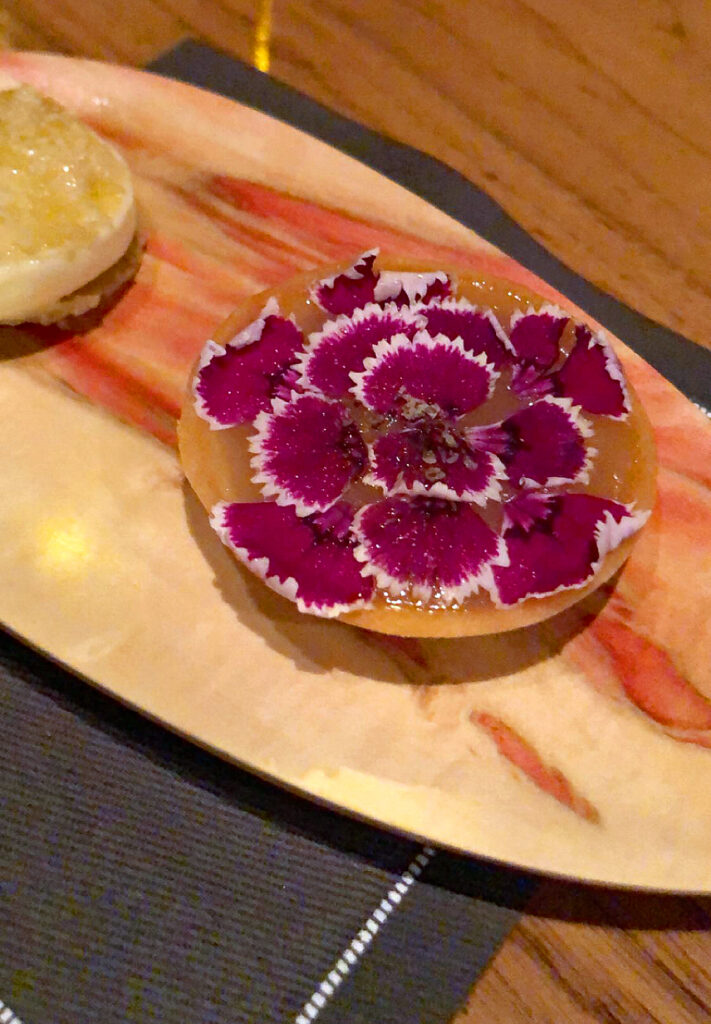
But still, like the sea lettuce cookie, there’s something challenging about the bite: rather than oozing like the caramel filling of a Twix bar, the tart chews as if a classic caramel “cube” had been placed inside it. Guests must expend an unexpected amount of effort to process the bite, during which they may ruminate and, ultimately, better appreciate the character added by the seaweed. Surely, that element would get lost otherwise, and you must say that the experience is still not just pleasurable, but memorable. One variant of the tart that appeared on later menus substituted the seaweed for striking rugosa rose petals. The flowers—grown on the coastal beaches of Japan—sits atop a toffee filling that forms a fitting substitute for the original caramel. As before, the chewy sensation accentuates the delicacy of the roses and transforms the tart from a tasty bite into something more thoughtful.
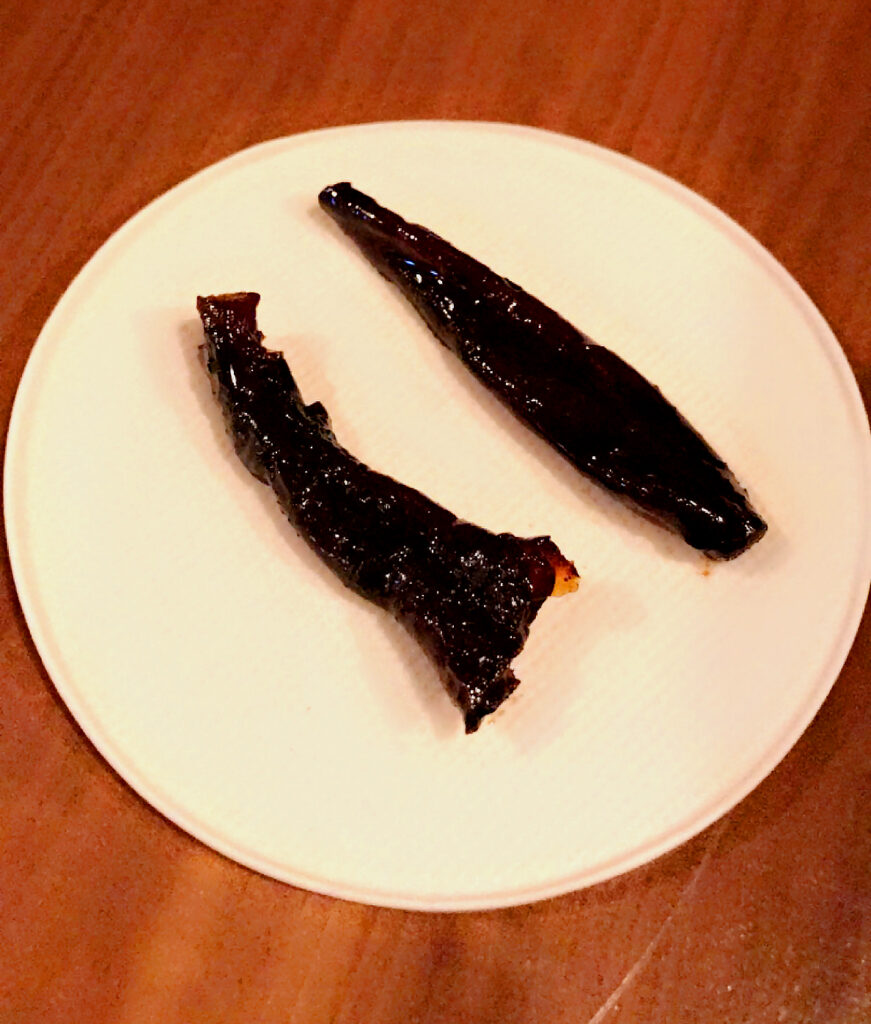
Those with fragile jaws beware: Urie Shields often presents still something else to chew on. This bite, relative to the sea lettuce cookie and the tart, has more in common with the black walnut. It is not quite so much a raw bite, but a pure expression of a humble ingredient that is presented, more or less, as it itself. Of course, who can say they have ever seen a black carrot before? But Urie Shields, yet again demonstrating her mastery of all things licorice, reduces the orange vegetable down to a tiny, concentrated form and coats it in sappy black syrup. The resulting carrot possesses the chew of dehydration and the sweetness of caramelization. It blends elegantly with the licorice coating, which serves to augment the vegetable’s own sweetness with a blend of bitter, salty, and sour notes. This makes for a playful bite and one of the purest expressions of produce that could ever feature as a “dessert.”
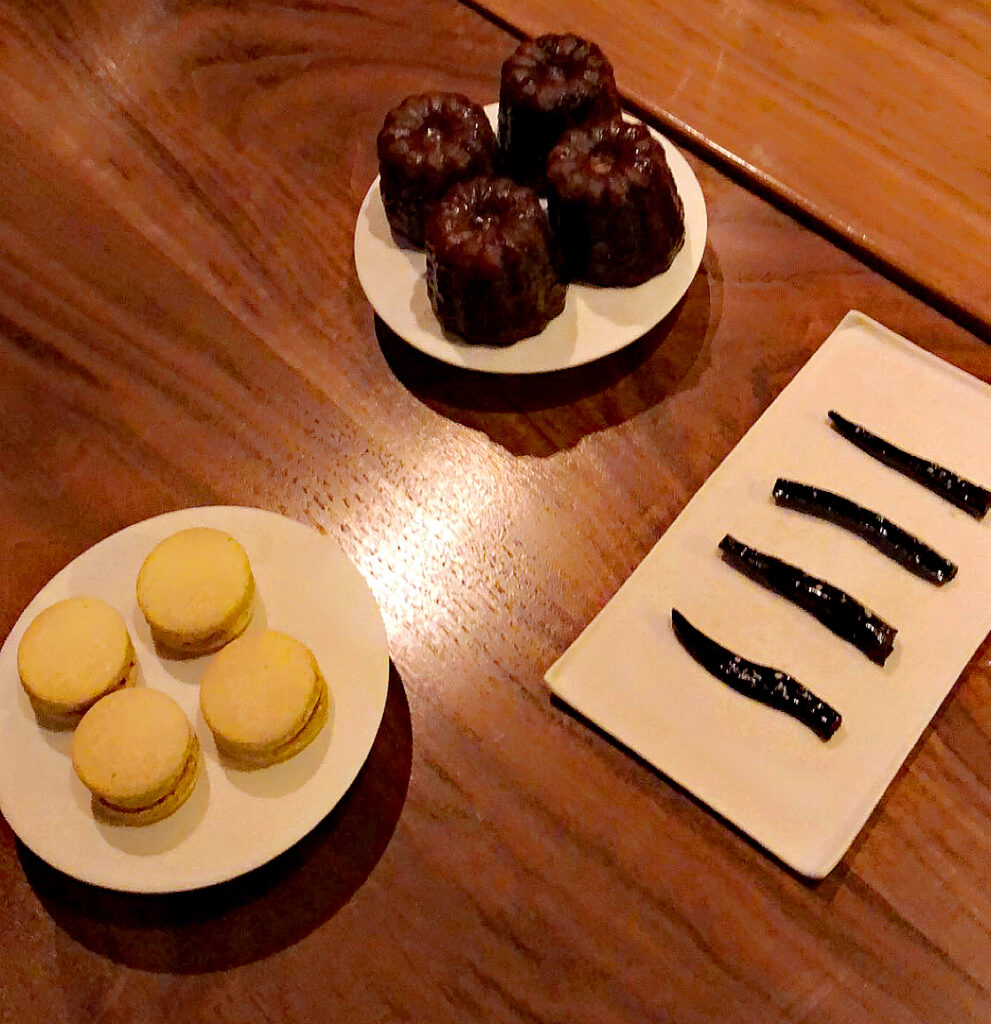
The last of the petit fours—and perhaps the most consciously “traditional” creation on Smyth’s entire menu—is that classic French form the canelé. These coveted bells should possess a crisp exterior leading into a custardy interior—a contrast that, yet again, yields something of an engaging sense of chew. Given Uriel Shields’s experience working for Chicago’s most renowned French restaurants, making a basic canelé is unquestionably old hat. And would such a forward-thinking restaurant—whose menu resists comparison from beginning to end—really finish things on such an utterly familiar note?
Do not worry, dear reader, for the Shieldses have one final card up their collective sleeves. What more Midwestern of a stamp could be applied to the classic canelé than to throw it on the damn grill? Imagine: the pastry’s outer layer crisped anew thanks to the char of a raging flame. Consider, that custardy interior no longer forms a static, solid filling but actually moistens the tongue with some of the consistency of a well-set flan. And, with a kiss of bitterness that serves to heighten the perception of sweetness, the traditional canelé has never been better.
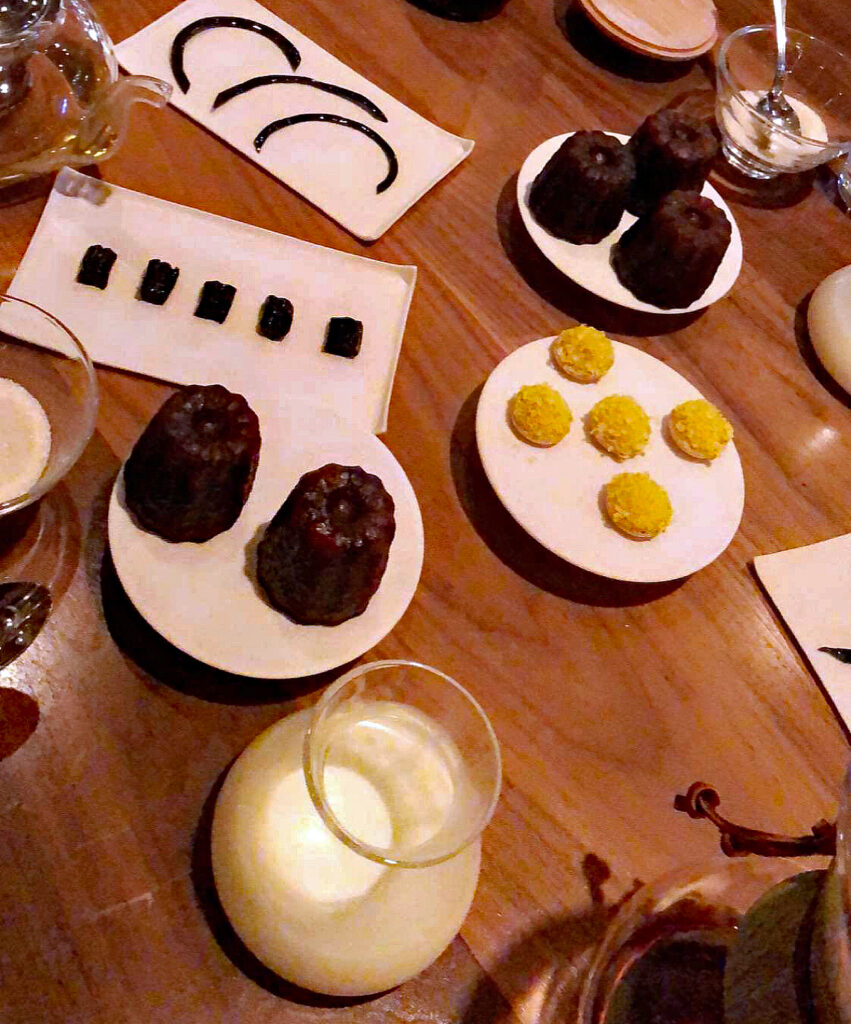
Urie Shields has also experimented with adapting the canelé to a “crêpe” form—two crisped pancakes filled with a chewy custard in a wedge-shaped slice about the size of the seaweed caramel tart. It’s a clever way to adapt what has become a signature preparation into smaller package. And it demonstrates, one last time, that any of Smyth’s most beloved dishes are not bound for embalmment in the grand mausoleum of gastronomy. Rather, they form perpetual jumping off points for a further exploration of a given moment in time. For nature is not a square peg to be fitted into a round hole. It resists the craven chef’s efforts to bend its bounty towards simply economic gain. It deplores hackery and demands a peer. John and Karen Urie Shields are those peers, and they have proven the greatest custodians and translators of nature’s splendor that Chicago dining has ever seen.
And now, at last, the ride stops. The record player scratches. Wined and dined to the very brim, you look around the dining room and reorient yourself. Nearly all the other guests have departed. Back of house has wiped down their stations, and the remaining front of house staff are busying themselves in preparation for the next evening’s chapter.
How do you end an experience—a journey—that in its seasonal, creative temporality will never, can never be repeated again? By dropping off the check with an urging “not to rush.” By depositing custom-printed menus on the table—truly custom, as in dates, the particular wines enjoyed (pairing or not), and even that supplemental course of cheeseburgers the staff so kindly arranged. You, of course, have consulted plenty of those menus in the process of writing this article. And, while other Chicago restaurants share in keeping the practice alive, nowhere but Smyth so singularly stamps their mementos with the full breadth of the story told.
Finally, your party rises and stumbles towards the entryway. Coats and hugs are exchanged—along with still one more parting gift. Another throwback: the take-home treat. Not always a pastry—sure as hell not any potpourri (sorry, Oriole, but do not go from offering Genie Kwon’s incomparable baked goods to packets of incense). Rather, Smyth looks to ensure their story becomes a part of your future as well: that might bean a homemade pancake mix with eggs fresh from The Farm, a bit of the restaurant’s Regiis Ova label caviar, a mini bottle of amaro (also made on The Farm), or even some black truffle for use in your morning omelet. Such generosity—even in the drunken haze such an exit usually entails—strikes home. It disentangles the transactional nature of fine dining from the true feeling of being cared for. And being cared for, without question and with the utmost resources at their disposal, is what Smyth provides without any equal.
Postscript: The preceding essay was written, on and off, during the period of time between November 2020 and March 2021. As it happens, that November witnessed the final meal—staged out of doors—before Smyth was forced to halt service for the second time. And that March, after an arduous period surviving on takeout sales alone, saw the restaurant welcome guests into their dining room once more.
How do you press “pause” on an establishment absolutely brimming with creativity? How do you freeze time for a restaurant that has surrendered itself fully to the rhythm of the seasons? Five months of uncertainty—produce, overgrown or rotting on the vine. Nature, like it or not, treads onward. A kitchen, a dining room both sapped of their strength. Two Michelin stars put towards pitmastery. Last season’s prized Farm preserves now merely bit part players. How do you just flip a switch and recapture the magic? How do you put the pieces back together when they have been scattered—twice—with many now gone for good.
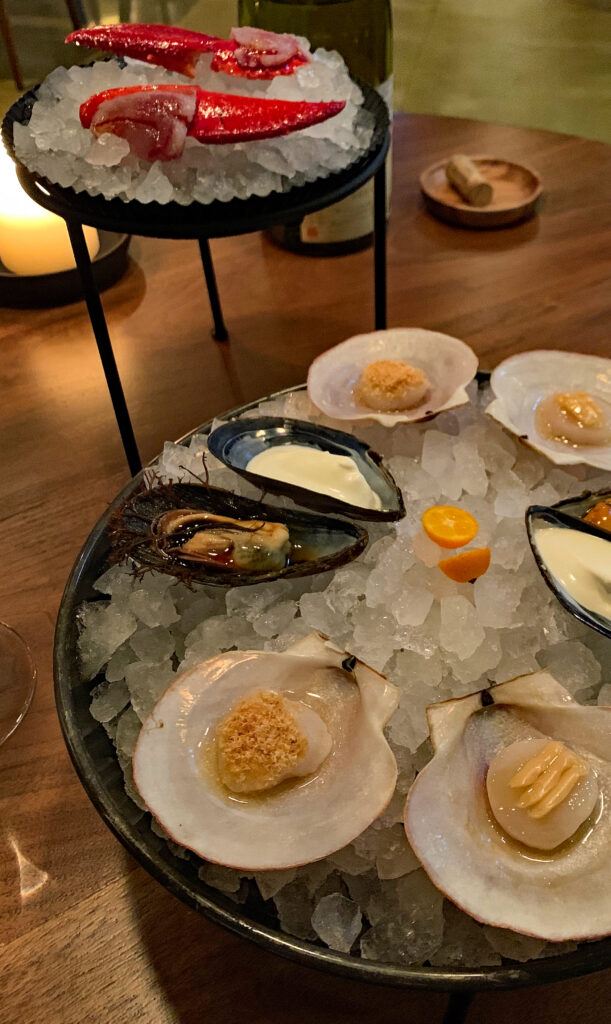
As you wrote, long ago, in the introduction, the tasting menu Smyth served to you in November of 2020 was their best ever. And, now, you are pleased to report that the latest tasting menu served—in March of 2021—was, yet again, Smyth’s best ever.
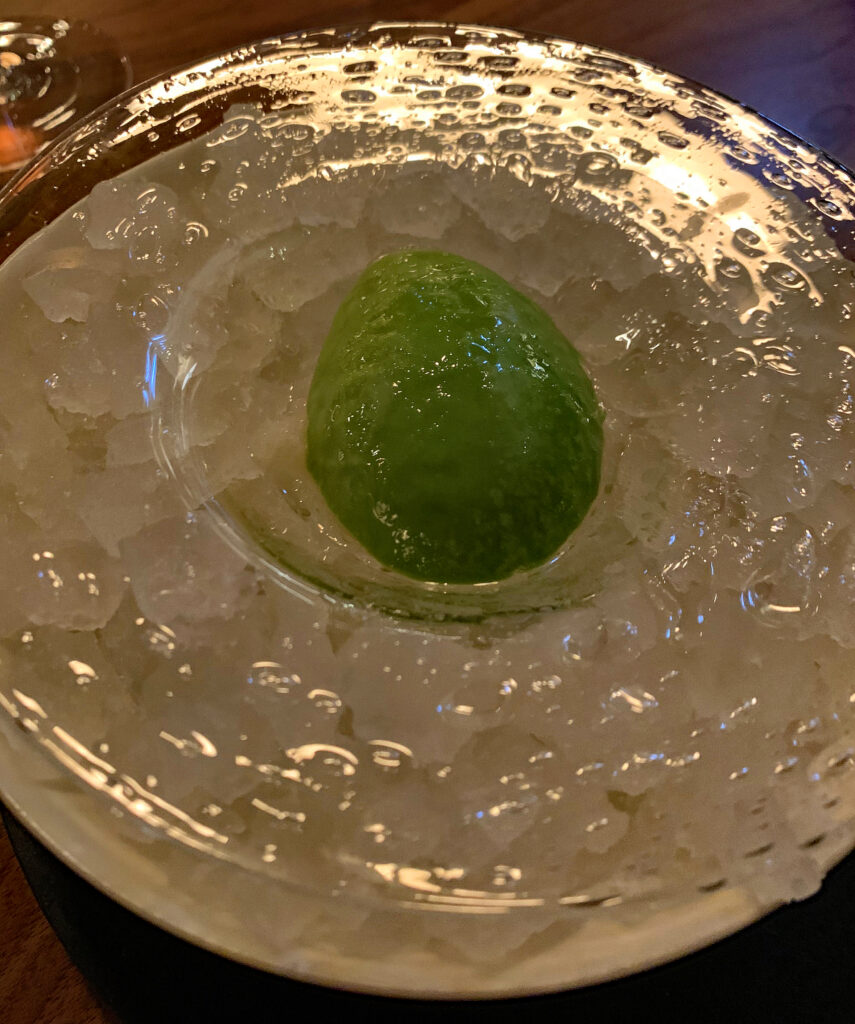
Technically speaking, the meal represented the apotheosis of so many concepts the Shieldses have explored—not just over the past five years, but going back to Town House. “Several servings of chilled shellfish”—like barely cooked lobster claw, wild Maine mussel, and a duo of marinated scallops—started the meal. Avocado, sourced from a small California farm, followed. It was chilled and served simply with a paste of Bangkok guava—and it resounded as the purest, most pleasing preparation of the ingredient you have ever been served.
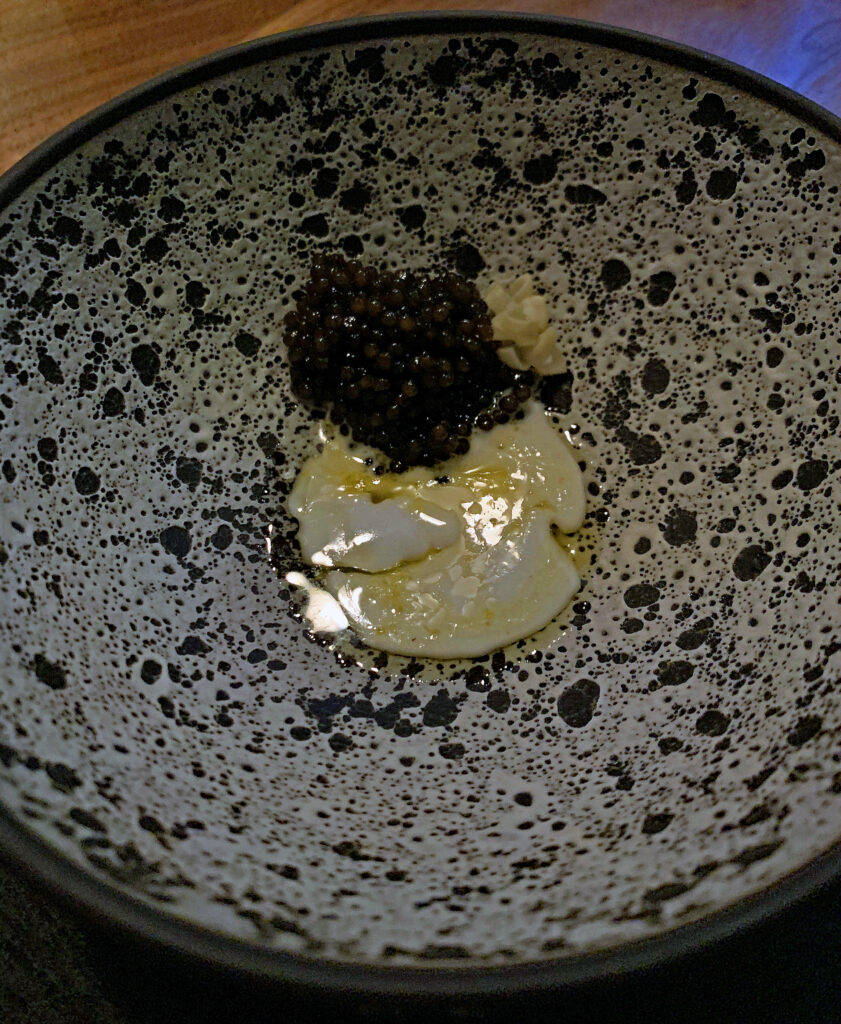
A dish of uni, egg yolk, and habanada pepper formed the one familiar presence from menus past (as it should, for the mutated habanero is a miracle of nature). It was followed by the finest anti-totemic caviar dish you have ever seen: “gently warmed” Kaluga in buckwheat butter with almond milk, walnut oil, and a startling pairing of Palo Cortado. What?! Warm caviar? And a glass of sherry? One can hardly imagine a caviar dish concocted to offer less pleasure. That Shields pulls it off is a stroke of genius: never before have the roe’s nutty accents been so boldly celebrated, with both temperature and pairing performing the miraculous.
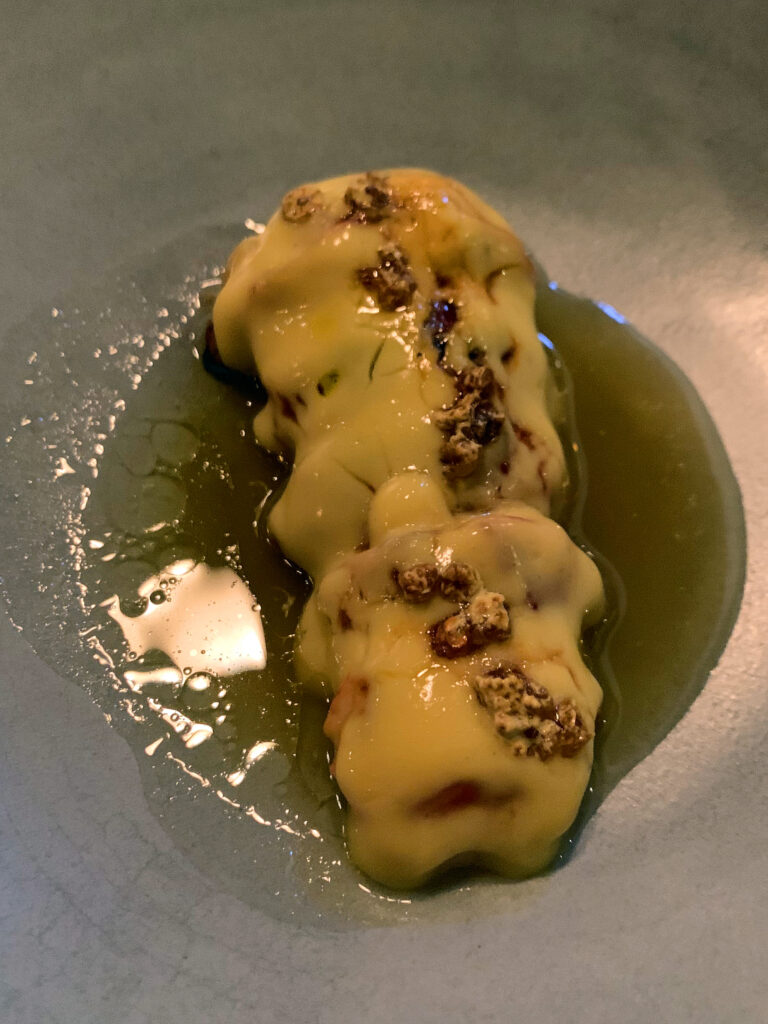
Maine lobster tail—cooked over the embers with honey and barley butter, seasoned with pine and bee pollen—then formed a companion piece with the raw portion of lobster claw served at the meal’s start. Taken as a sequence—a descendent of the shima aji and king crab sequences of yore—the claw and tail divide and conquer. The former is all about the gelatinous mouthfeel and burst of acidity from a simple seasoning of salted raspberries. The latter offers the ultimate indulgence: luscious, buttery chunks of tail taken to the extreme by way of complementary floral and honeyed notes. Paired with a glass of Bérêche’s Reflet d’Antan champagne, Shields’s lobster tail is simply sublime. In both complexity and sheer pleasure, it surpasses the classic butter-poached preparations served, for example, at Thomas Keller’s estimable three star establishments.
However good that lobster was, it was followed by perhaps the most intelligent sequence of dishes ever served at Smyth. It comprised not only the “heavy” (the richest or most umami) vegetable course, but the main entrée, the bread service, and the palate cleanser / transitional course to boot. All offered under one umbrella and served—bite after bite—with an impeccable flow.
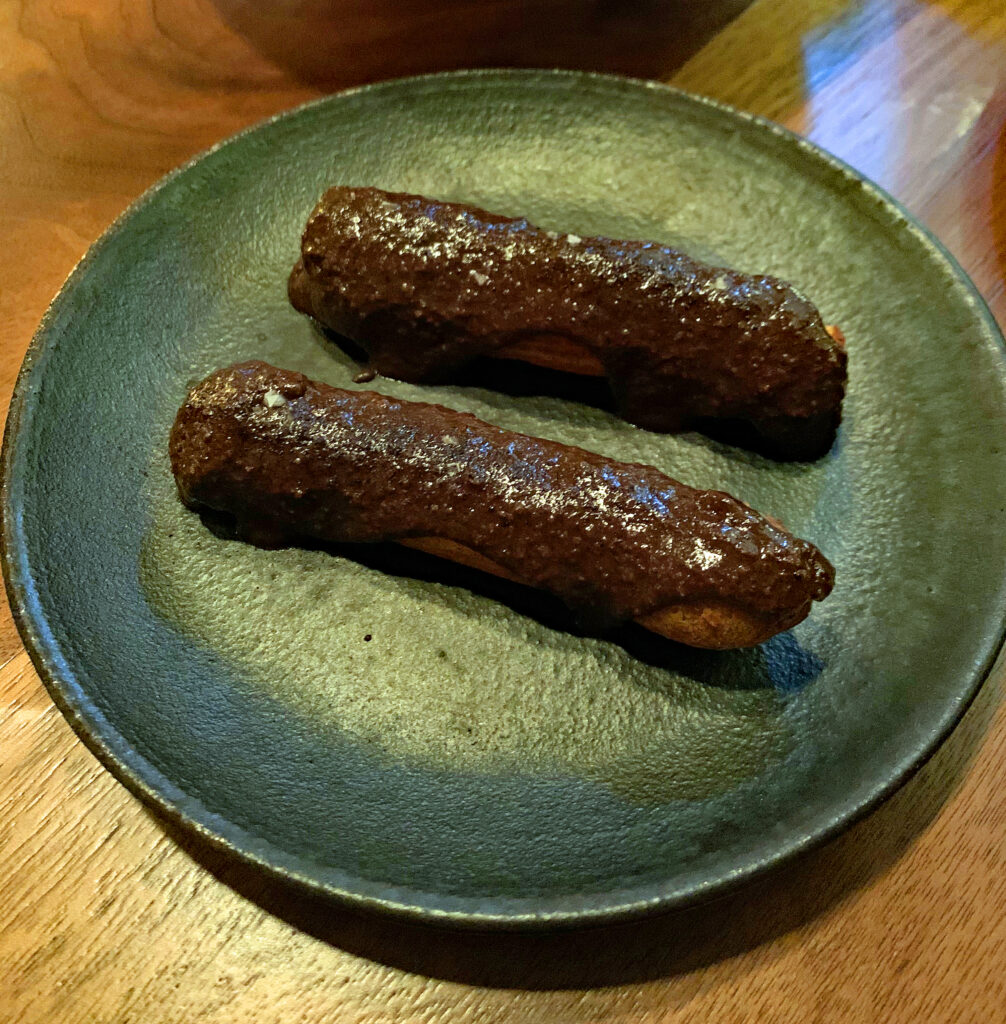
The sequence was titled “various preparations of game” and featured: a smoked beet, slowly cooked in a sauce of venison; a piece of venison loin, sourced from Texas, glazed with black walnut, and served with a truffled liver ragout; a savory éclair, glazed with sauce civet and filled with fermented shiitake mushroom; a tea made from black walnut, blood, and Armagnac; and a black malt macaron filled with blood sausage and chocolate. Such an assortment—a celebration of game, an onslaught of umami—transports diners to a lost era of grandeur.
And yet, Shields imparts drastically more flavor into his delicate forms than the heaping banquets of old. When one tastes the 1990 Cos d’Estournel poured alongside the sequence, one realizes that a heritage once lost has now been found. It’s not exclusively a French heritage, per se, but a tradition of cookery—of local sourcing—that has always prized game. Chicago, the pioneering metropolis of early American expansion, certainly did. And Shields, through this excellent set piece, is sure to remind (and convince) residents as to why.
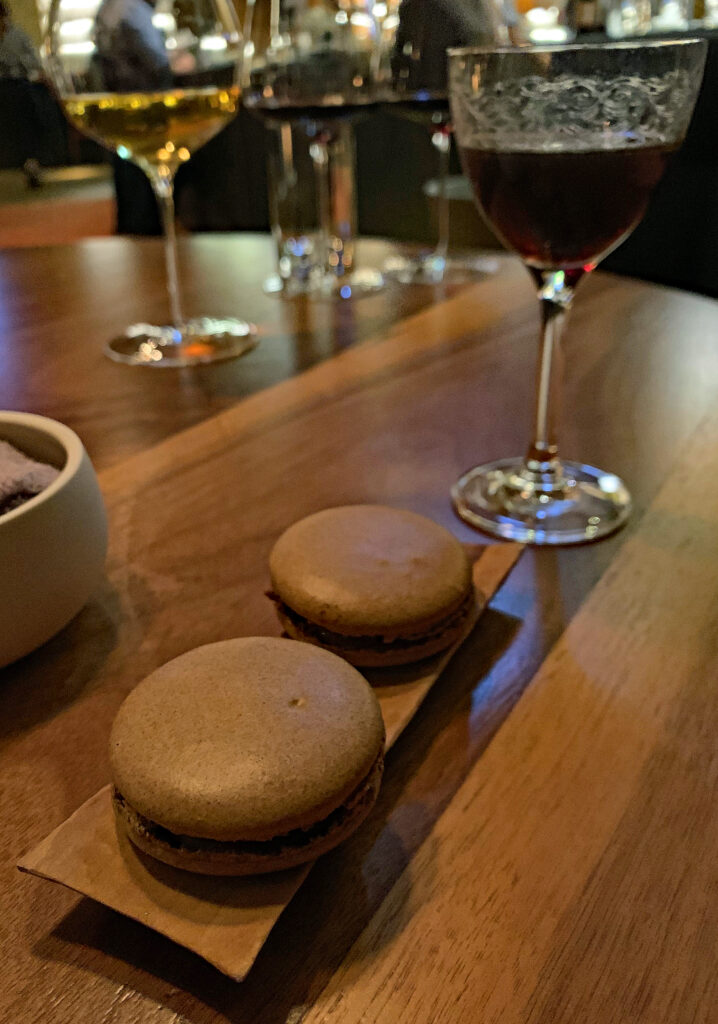
Urie Shields, of course, has kept herself busy during the extended downtime. And she has hatched some of the most elegant dessert offerings ever before seen at Smyth. Of course, that aforementioned black malt macaron was her handiwork: a balancing of irony blood sausage and chocolate that walks an even more precarious tightrope than the combination of shiitake mushroom and chocolate ever did. Yet, when the texture of the macaron is so perfect, it makes it easy for unorthodox combinations to shine. The combination of the pastry with its accompanying black walnut, blood, and Armagnac broth amounts to a surreal carnivorous “tea party” that adds a dose of fun and finality to the savory portion of the meal.
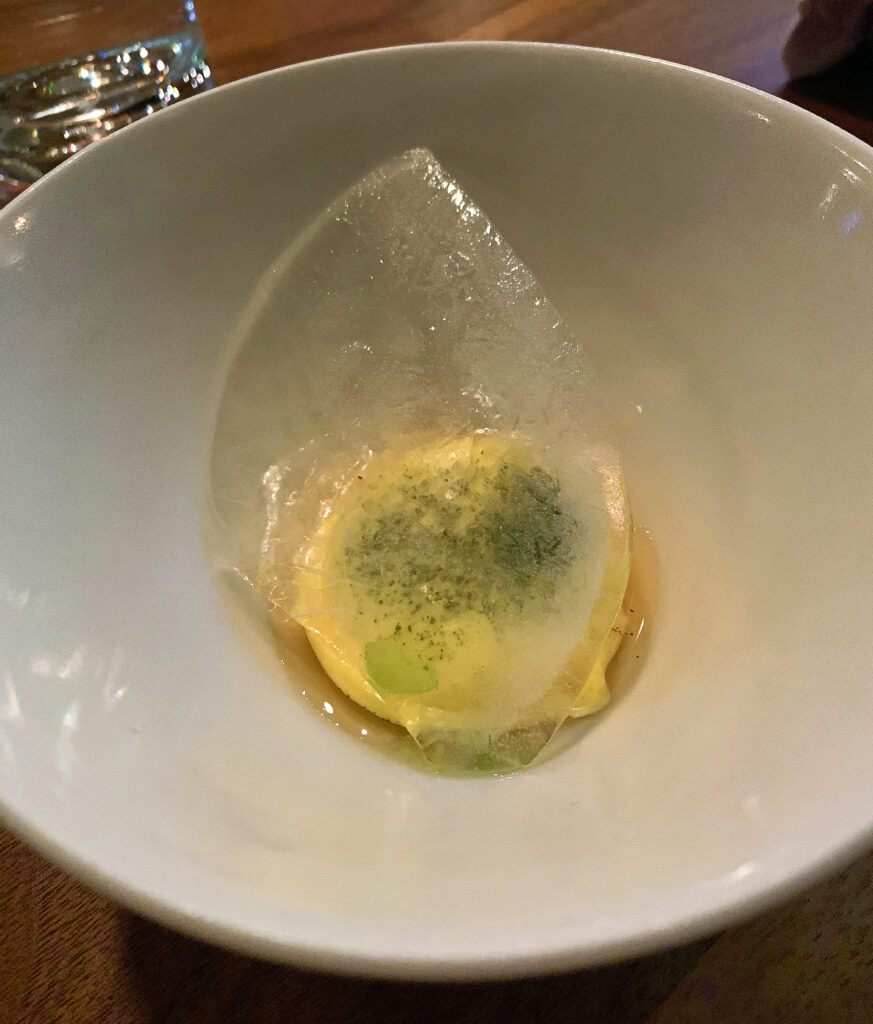
On the back of that bloody macaron, Urie Shields quickly pivots towards refreshment with a dish defined by kumquat. Nagami kumquats, to be specific, a winter-ripening variety with a powerfully sour flesh and an equally sweet skin that is typically eaten whole—“skin and all.” The chef processes the fruit into a sort of custard and augments its flavor with the vanillin notes of citrus flower and the cooling, floral effect of eucalyptus. These complementary notes—layers upon layers of tart and sweet fruit—verge on overkill, insomuch as they lack some signature, provocative sort of foil. But why contrast such pleasantly powerful flavors when they can instead be unfurled?
In a stroke of genius, Urie Shields tops the kumquat custard and floral combination with thin, clear sheets of ice. They cleanly shatter when struck with your spoon and dilute the intense flavors beneath into a perfectly-balanced (and ever so slightly crunchy) sorbet. The dish is not only interactive in the sense that guests complete the preparation, but—depending on the extent to which the ice is incorporated—they have complete control over the flavor composition of each bite. Thus, one does not end up with a bowl of “diluted” custard so much as a continual transition between the pure expressions of tart-sweet kumquat and something more like a Slurpee. Few chefs could successfully structure a dish in this manner, and Urie Shields—without question—triumphs.
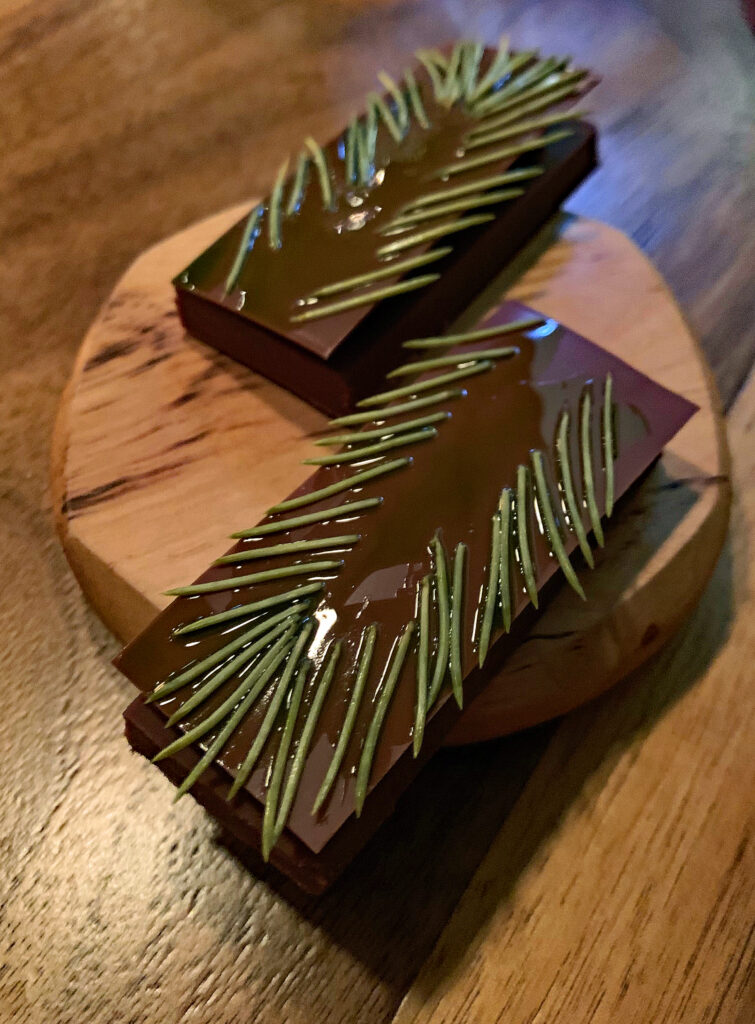
Bringing last weekend’s meal to a close, the petit fours featured a few familiar friends with some surprising new twists. Conifers—in the form of those baby pinecones which featured atop Urie Shield’s sundaes—were glazed in licorice and served whole. For the first time, their delicate crunch and strikingly dimpled texture could be appreciated alone—and you must say you found them to be quite tasty. The shiitake “chocolate bar,” too, took something of a new form. Out went the mushroom component and in came black raspberry, with a phalanx of spruce tips providing a citric boost and additional textural note to the bar’s topping. Finally, there was the tartlet—no longer filled with caramel or toffee, but preserved egg yolk. Topped with a bud of marigold, it offered a custardy richness like never before.
Clearly, the misfortune surrounding Chicago’s indoor dining restrictions did nothing to sap the Shieldses’ culinary creativity. The wine program, too, under the command of Kevin Goldsmith, has never been better. He has not only crafted pairings that—in the rarity, quality, and boldness of their selections—rank among the most exciting in the city, but Goldsmith offers them at a “pinch me I’m dreaming” price point without compare. Smyth, more than ever, ranks as the one restaurant in Chicago where you must indulge in a wine pairing for fear of missing something exceptional. (Compare that to other establishments that haphazardly and thoughtlessly raid the cellar to fulfill the expectations of a certain tier yet lack the vision to do so convincingly).
Beyond the wine pairings, Smyth’s list is replete with the sort of eclectic back-vintages and, more importantly, Burgundy (both white and red) rarely seen since the untimely passing of the city’s French old guard. The pricing, in a word and across the entire board, can only be called “generous.” Guests who take the plunge on a tasting menu need not dread being squeezed on beverages—in fact, they might very well find themselves transformed into an oenophile upon being placed in Goldsmith’s expert hands. Could it be the best wine program in Chicago? Curtis Duffy’s Ever provides strong competition, but it cannot touch Smyth in its current form. Refusing the temptation to subsidize the food with mark-ups on wine is a real feather in Shields’s cap—and the sort of gesture than should guide the restaurant ever-closer to its coveted, deserved third star.
So, if the food and wine are better than ever, what is there left to judge? Ah, yes, that old chestnut: hospitality. It cannot be denied that the pandemic—past the point of actually shuttering businesses—has devasted any continuity of service that might have survived. Long-term hospitality professionals—in any form—are rare birds. And even the most loyal soldiers have been forced—by overall uncertainty and, particular, in delayed relief funding—to seek new pastures.
Smyth, more than almost any establishment who dares use the term, truly embodied a “restaurant family.” Certainly, the ambiance and character of service lend itself to forging genuine connections with guests. Yet the ability for those relationships to survive and deepen across multiple visits affirmed that the restaurant was more than merely an “eating place.” Visitors to Town House or Riverstead, no doubt, knew they would reliably placed in the hands of the Shieldses. And guests who have visited Smyth during the first five years of its existence have come, too, to rely on a consistent cast of incomparable characters to care for them.
Suffice it to say, the pandemic has torn those deep relationships up “by the roots.” It has turned Smyth’s dining room from a fertile field of friends new and old—a mixed assemblage of relationships that buffered natural comings and goings—into something more like scorched earth. And, once that original thread has been severed, is it not right to ask if the magic can ever be captured again?
In truth, Smyth’s “restaurant family” starts at the very top: with the Shieldses—quite literally a family forged in the kitchen—and a general manager who ranks as one of the very best in the business. With such a foundation in place, starting “from scratch” need not seem so scary. For it was not by chance that the restaurant cultivated such an immense array of talent. It flowed naturally from a spirit, a soul, woven into the very fabric of the restaurant. One might even call it a “culture,” though you cringe at how that term has been applied to all manner of corporate concocted kumbaya nonsense.
Many of the faces you saw during your most recent visit to Smyth were altogether new. It is not wrong, in some sense, to say that—in terms of front of house—the restaurant is almost starting from scratch. Yet the team, at present, is by no means a bare bones cadre charged with pushing plates from pass to table. It’s no pale representation of what once was and what will never be again. No, the spirit of Smyth lives on: in every glimmer of eye contact that shines behind a masked visage, in every extra pause at the table, in every joke told, and in the myriad ways in which each and every member of the team demonstrates that guests are not customers, but friends. Such raw, genuine emotion can never be faked. It can only come from a team that feels valued, empowered, and—even—loved.
Smyth, despite 2020’s untold difficulties, still possesses that team. Which is to say, if the restaurant can inspire that sense of excellence yet again, it is no fluke. Rather, it presents a lineage—a heritage—that transcends any individual. It marks an identity that encompasses the many souls who have given themselves in service to an idea. And yet, that idea encompasses so much more than the sum of its parts.
There is something about Smyth that is timeless, something about it that feels eternal. And yet, the restaurant is never foreboding. It is a kingdom whose riches are lavished freely and equally upon all guests who arrive with open minds and hearts. Smyth, in its genuineness, invites diners to become a part of something far greater than a passing meal. The establishment stands as a beacon of humanity in a commercialized world, an expression of luxury that knows there is no greater luxury than to feel loved. Smyth, in a word, is legendary. You cannot say you have eaten at Le Francais or Charlie Trotter’s in their prime, but you feel no fear in saying Smyth is the greatest restaurant Chicago has ever seen. And, by all accounts, the Shieldses are only getting started.



